


FROM THE EDITOR
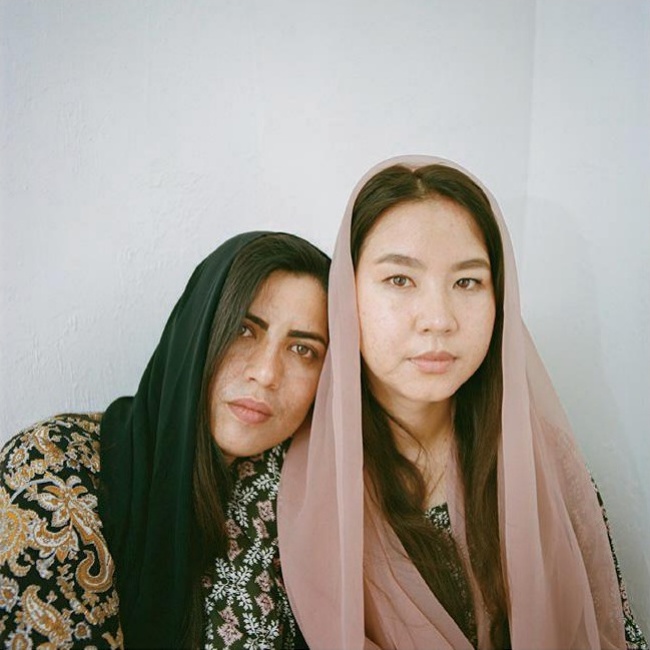
Friends Hasina Najibi and Raihana Rahimi at their home in Florida in July
Far from home
OVER THE COURSE OF “THE LONGEST WAR”—A NAME WE WERE already using back in 2009—TIME published more than a dozen covers about Afghanistan and the Taliban. Perhaps the best known was in 2010 and featured a shocking and disturbing portrait of Bibi Aisha, a then 18-year-old whose husband—a Taliban fighter—had cut off her nose and ears after she tried to escape their forced marriage. The story that ran with that cover, written by senior correspondent Aryn Baker, explored what might happen to Afghan women if the U.S. were to pull out of Afghanistan.
Today of course that is no longer a hypothetical. To mark one year since Kabul fell to the Taliban—a year in which women have lost many of the freedoms they had for the previous two decades—executive editor Naina Bajekal collaborated with journalists Amie Ferris-Rotman and Zahra Joya on a special project. The powerful visuals in the package were overseen by TIME’s Sangsuk Sylvia Kang, Paul Moakley, and Katherine Pomerantz. Working with women writers and photographers around the world, and supported by a grant from the Pulitzer Center, the team set out to illuminate the experiences of women who had to leave Afghanistan, pursuing new dreams even as they remain deeply concerned about loved ones back home.
The journeys of these eight women are varied. All are stories of resilience
The result is our international cover for this issue. It tells the stories of eight Afghan women, each of whom since last August has fled the Taliban to start a new life in locations ranging from Fort Myers, Fla., to Nice, France, to São Paulo. For Ferris-Rotman and Joya, this project was particularly personal. Ferris-Rotman was previously based in Afghanistan, where she established an organization to mentor and train Afghan women journalists. Joya, one of TIME’s 2022 Women of the Year, became one of the many new Afghan refugees last August. From her home in London, she runs Rukhshana Media, which is dedicated to telling the stories of Afghan women. Rukhshana Media will be publishing this project on its own website, in English and Dari, where we hope many of its readers will see themselves reflected in the stories.
The journeys of these eight women are varied. Some are stories of hope. Some of fear. All are stories of resilience. “What we need is not pity and empathy,” says Masouma Tajik, a 23-year-old Rutgers University student who left Kabul for Kyiv, only to have to rebuild her life once more. “What we need is opportunities so we can make our own way.”
Former Afghan air force pilot Raihana Rahimi, who appears with Hasina Najibi on the cover and was interviewed by Afghan journalist Farahnaz Forotan, expresses a similar sentiment. “I am determined to find a way back into my profession,” she says. “This is the dream that keeps me alive.”
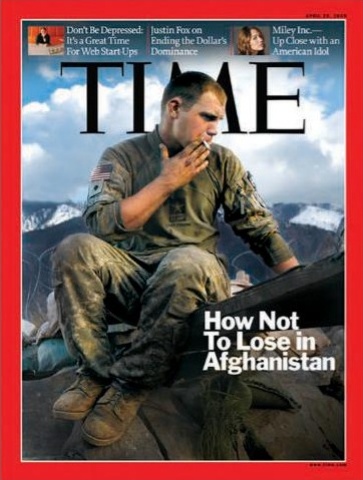
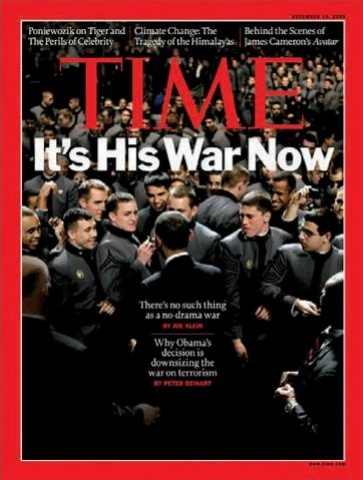
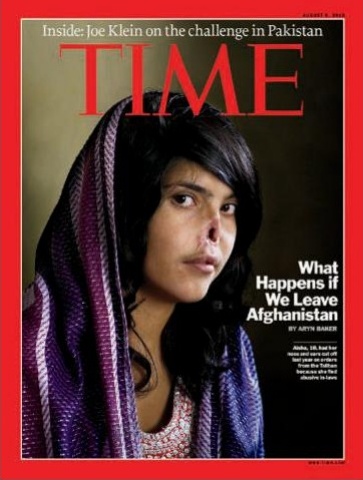
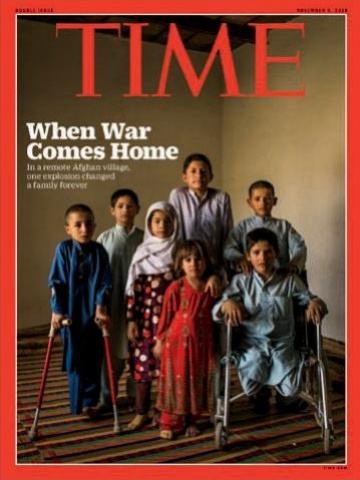

NAJIBI AND RAHIMI: SABIHA ÇIMEN—MAGNUM PHOTOS FOR TIME
CONVERSATION
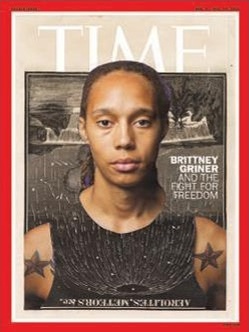
What you said about . . .
FANS OF WNBA STAR Brittney Griner—who has been detained in Russia since February for carrying cannabis oil—hailed Sean Gregory’s Aug. 8/Aug. 15 cover story on the league champion and two-time Olympic gold medalist for spotlighting the efforts to bring her home. A judge in Moscow sentenced her on Aug. 4 to nine years in jail.
“The best part of this profile is that it is a much-needed reminder for many that #BrittneyGriner is a human being,” tweeted Kimberly St. Julian-Varnon, a history Ph.D. student at the University of Pennsylvania. Ukrainian designer Irina Kostyshina replied that Russia’s detention of Griner “is an example of a person held hostage by a state clearly signalling ‘we are doing this just because we can.’” Tammie Cooper of Winter Springs, Fla., said it’s worth looking at pay for WNBA players so they don’t have to play abroad in the off-season.
The Women’s National Basketball Players Association tweeted Lorna Simpson’s cover art and said its members are fighting for Griner’s freedom, stating, “It’s hard for us to sleep knowing that you’re still there & we’re here. We won’t stop advocating until you’re home. We admire your bravery & are inspired by your courage.”

More Emmy nominations for TIME
TIME received five News & Documentary Emmy Award nominations on July 28 for Paper & Glue, the TIME Studios–MSNBC doc on the artist JR, and Unlivable Oasis, a TIME-ProPublica doc about a California family and climate change, which got three nods. Watch the films at time.com/unlivable-oasis and nbc.com/paper-glue

Best new books to read in August
Looking for your next summer read? TIME’s Culture team highlights 12 of the best books coming out in August. Among the novels featured are Afterlives by Nobel Prize winner Abdulrazak Gurnah and Carrie Soto Is Back by Taylor Jenkins Reid. Read the full roundup at time.com/august-books. Follow all TIME’s books coverage at time.com/books
SUBSCRIBE
Into the Metaverse newsletter
In a fortnightly email, TIME correspondent Andrew R. Chow makes sense of the latest on crypto, digital worlds, and the future of the internet. Sign up at time.com/metaverse
See all the newsletters
Find all of TIME’s email lists at time.com/newsletters
On the covers
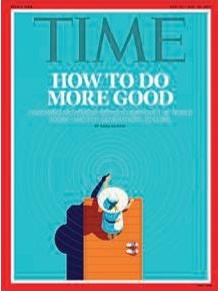
Illustration by Peter Greenwood for TIME
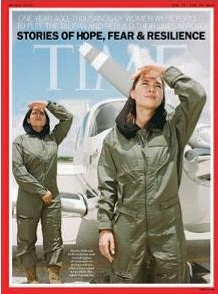
Photograph by Sabiha Çimen—Magnum Photos for TIME
Looking for a specific cover?
Order your favorites at timecoverstore.com
HEALTH
TIME’s Health editors are seeking submissions for the COVID Questions advice column, which answers coronavirus-related queries like “I’m Vaccinated, Boosted, and Had COVID-19. Can I Go Back to Normal Now?”
Email questions to covidquestions@time.com
PROGRAMMING NOTE
This issue will be on sale for three weeks. The next issue of TIME will be published on Sept. 1 and available on newsstands on Sept. 2.
TALK TO US
SEND AN EMAIL
Please do not send attachments
FOLLOW US
facebook.com/time@time (Twitter and Instagram)
Letters should include the writer’s full name, address, and home telephone, and may be edited for purposes of clarity and space
Reprints and Permissions Information is available at time.com/reprints. To request custom reprints, visit timereprints.com.
Syndication For international licensing and syndication requests, contact syndication@time.com
PAPER & GLUE: COURTESY OF MSNBC FILMS
FOR THE RECORD

1874
The last time a swimmer was attacked by a shark in U.K. waters—until July 28, when a snorkeler reported being bitten off the coast of southwest England
‘It’s time for a new international convention that accepts that the war on drugs has failed.’
GUSTAVO PETRO, Colombian President, at his swearing-in on Aug. 7
‘I never wanted to have to choose between tennis and a family. I don’t think it’s fair.’
SERENA WILLIAMS, announcing that she plans to retire from tennis in part so that she can have another child, in Vogue on Aug. 9
‘I LOVE SNAKES. I HATE THAT WE HAVE TO DO THIS.’
AMY SIEWE, one of 850 professional snake hunters who traveled to the Everglades to kill invasive Burmese pythons as part of the Florida Python Challenge, on Aug. 5 to CNN
47%
Increase in the retail price of eggs in July from a year earlier, according to an Aug. 9 report by analytics firm Information Resources Inc.


72
Number of looted artifacts London’s Horniman Museum and Gardens said Aug. 7 that it will return to Nigeria after more than a century
‘You know what perjury is, right?’
MARK BANKSTON, a lawyer for the parents of Sandy Hook school shooting victim Jesse Lewis, to conspiracy theorist Alex Jones, at a defamation trial on Aug. 3 after Jones’ lawyers accidentally turned over the entire contents of the InfoWars founder’s phone. Its contents contradicted Jones’ previous statements about his claims that the Sandy Hook shooting was a hoax
ILLUSTRATIONS BY BROWN BIRD DESIGN FOR TIME; SOURCES: BLOOMBERG; CNN; THE GUARDIAN; NPR
TheBrief
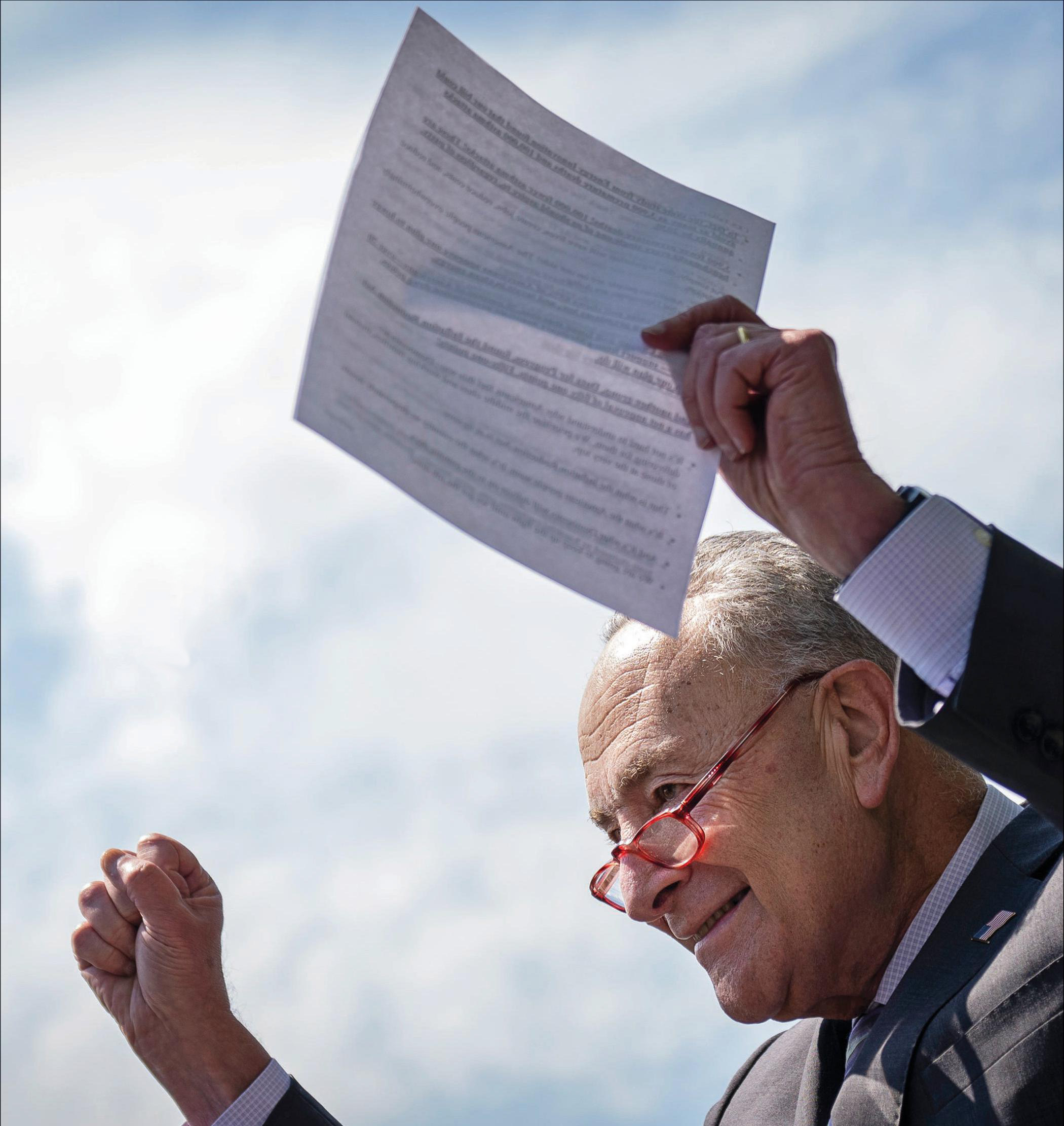
A CLIMACTIC CHANGE
The Inflation Reduction Act is about to jump-start U.S. climate policy and change the world
BY JUSTIN WORLAND
PHOTOGRAPH BY DREW ANGERER
I N JULY, A PAIR OF SENATORS GATHERED reporters in the U.S. Capitol to deliver a message to President Joe Biden: it’s time to declare a climate emergency. It was, to be sure, something of a Hail Mary. The prospects of major climate legislation had dimmed, and the two Democrats were desperate, worried it could be years before Congress tackled climate change in a meaningful way. “Am I concerned that it will be a decade before we have a climate majority?” said Senator Jeff Merkley of Oregon, alongside Senator Sheldon Whitehouse of Rhode Island. “I am damn concerned.”
Less than three weeks later, Democratic Senators walked off the Senate floor in celebration after passing the Inflation Reduction Act, the most significant climate legislation in U.S. history. Once the House of Representatives passes it, Biden will, with his signature, begin a new era of climate policy in America.
Experts say the legislation will dramatically accelerate the decline in U.S. emissions, putting the country within reach of the Biden Administration’s goal of slashing emissions in half by 2030 compared with 2005 levels. That goal serves as a barometer of how much climate-change-generated pain and destruction the world can avoid, and sets a destination of sorts for all U.S. climate policy. The Inflation Reduction Act offers a framework for how the U.S. will tackle climate change in the eight years until that deadline and beyond. It invests nearly $370 billion in energy and climate-change programs, including enormous tax incentives to advance renewable energy and electric vehicles. The bill still leaves many details to be determined, and battle lines are already forming over the future of fossil-fuel production and how to advance environmental justice.
Regardless of how those battles play out, the bill will give the U.S. newfound credibility as a climate leader on the international stage and help convince other countries that the energy transition is irreversible. It’s impossible to know exactly how well every climate provision of the Inflation Reduction Act will work, but what is clear is that once signed into law, it will jump-start an economic transformation and rejigger international climate politics—with ripple effects that will shape communities large and small, and the way Americans live.
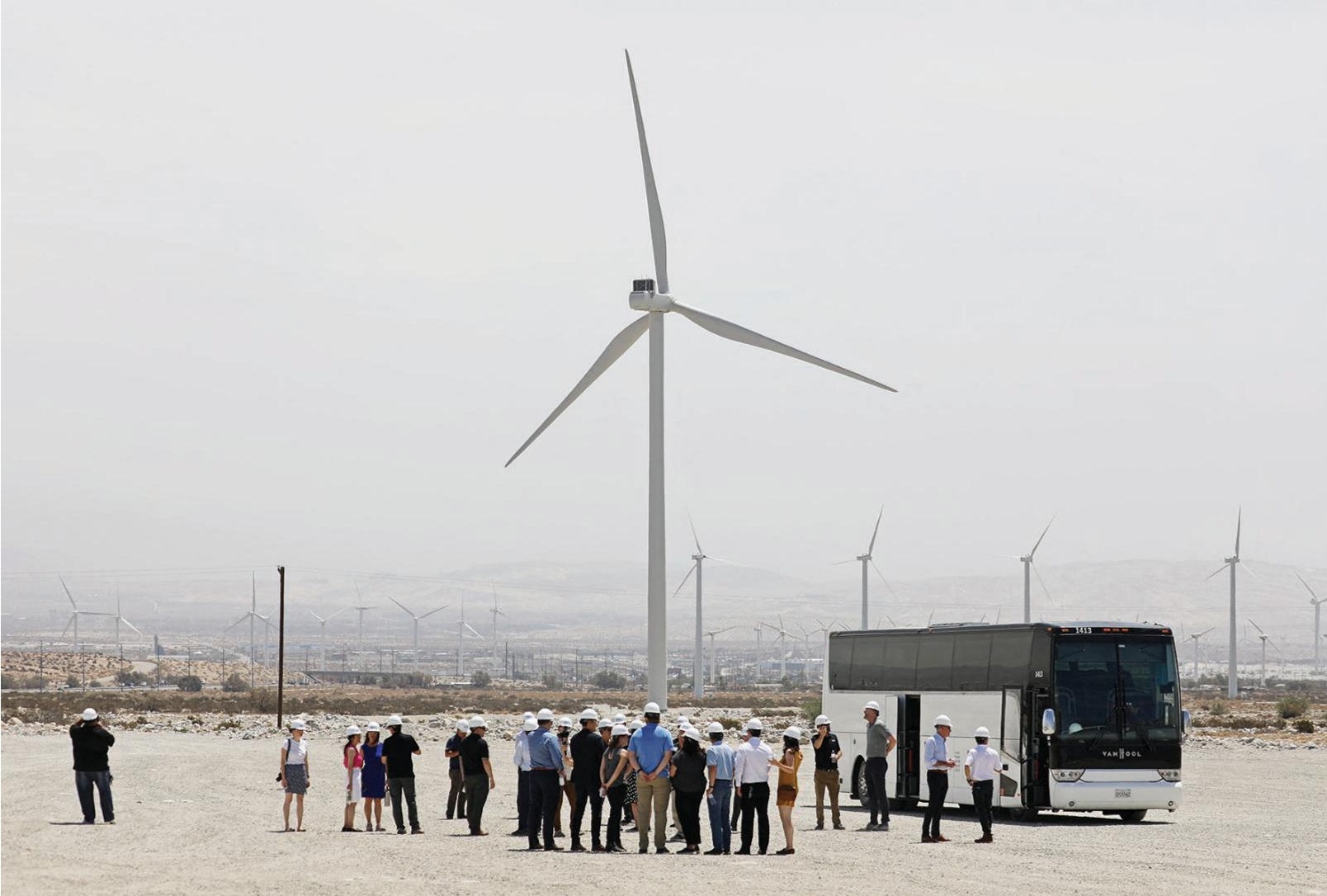
Wind turbines in Palm Springs, Calif.
THE INFLATION REDUCTION ACT’S approach to cutting U.S. emissions is the result of decades of trial and error. President Bill Clinton attempted to pass an energy tax but fell short; climate advocates learned that upsetting Big Business could doom legislation. President Barack Obama supported congressional efforts to pass cap-and-trade legislation endorsed by Big Business; when the bill sputtered in the Senate after being passed by the House, climate advocates learned they would need to foster grassroots support to get legislation across the finish line.
Both of these lessons—and many others—paved the way for the Inflation Reduction Act. It relies largely on carrots over sticks—incentivizing businesses to decarbonize rather than penalizing them for not doing so. And it promises to create jobs and investment in Americans’ communities, spreading the immediate benefits to broad swaths of the voting public.
At the core of the legislation are tax credits for companies that build wind and solar power as well as a slew of other clean energy technologies. These credits, which last for 10 years, should catalyze the creation of a decarbonized energy system and serve as the driving force behind the bill’s emissions reduction. Beyond that, a range of industries will be nudged to decarbonize. Airlines will get credit for buying lower-carbon fuel. Industrial firms will receive financial incentives to capture and store carbon dioxide in their production process. “This legislation truly is transformative,” says Dan Lashof, a director at the World Resources Institute. It “gives long-term investment certainty, which will really mobilize capital and transform our energy system.”
This may sound distant and wonky, but these changes will ripple across the economy—and into your backyard. Nascent technologies—from battery storage to hydrogen power—will get a boost, creating new jobs and inspiring new companies. The legislation gives the Department of Energy new authority to lend private companies up to $290 billion to advance clean-energy programs. Tesla received a loan from that same program a decade ago, helping it expand its manufacturing. The next clean-technology giant could benefit from a similar loan, if not other provisions in the Inflation Reduction Act.
$369
BILLION
Total investment in energy and climate programs over the coming years
$7,500
Tax credits for some electric-vehicle buyers
$290
BILLION
New funding for loans for private companies to advance clean-energy programs
$14,000
Maximum rebate for certain home-efficiency upgrades including heat pumps and insulation
You’ll notice the bill’s effects as a consumer too. Tax incentives for home renovations will create new opportunities for Americans to make their homes more energy-efficient, with up to $14,000 in rebates for products like heat pumps, which provide a cleaner way of heating and cooling homes, and electric stoves. Analysts say that efficiency, combined with the lower cost of renewable power, will reduce consumer energy prices. And then there are the incentives for electric vehicles: buyers can receive a tax credit of up to $7,500 per vehicle. Many consumers who aren’t even currently thinking of buying an electric car may soon find themselves in the market for one.
“This is the package that we have been waiting for,” says Leah Stokes, a professor of environmental politics at the University of California, Santa Barbara, who has been a key advocate for robust climate policy. “This is a transformative bill.”
Democrats and climate activists didn’t get every provision they wanted in the bill, and they had to strike compromises to keep their caucus together. The legislation incentivizes deploying carbon-capture technology, which would allow a continued reliance on fossil fuels so long as companies capture the carbon emissions. Environmental-justice activists argue that these technologies will do little to help the underserved communities that tend to bear the brunt of environmental pollution from fossil fuels. And, in what climate advocates call a poison pill, the legislation requires the federal government to auction some federal land for oil and gas drilling. How much of that land is actually developed will depend on a variety of factors, from fuel prices to activist pushback. The Inflation Reduction Act may help the U.S. confidently say that the energy transition is in full swing, but more work remains to ensure that the transition is swift and just.
Still, with this act, we are entering a new era in the fight against climate change.
The Brief is reported by Eloise Barry, Leslie Dickstein, Tara Law, Sanya Mansoor, Billy Perrigo, and Julia Zorthian
FROM TOP: GETTY IMAGES; DAVID SWANSON—REUTERS
THE BRIEF OPENER
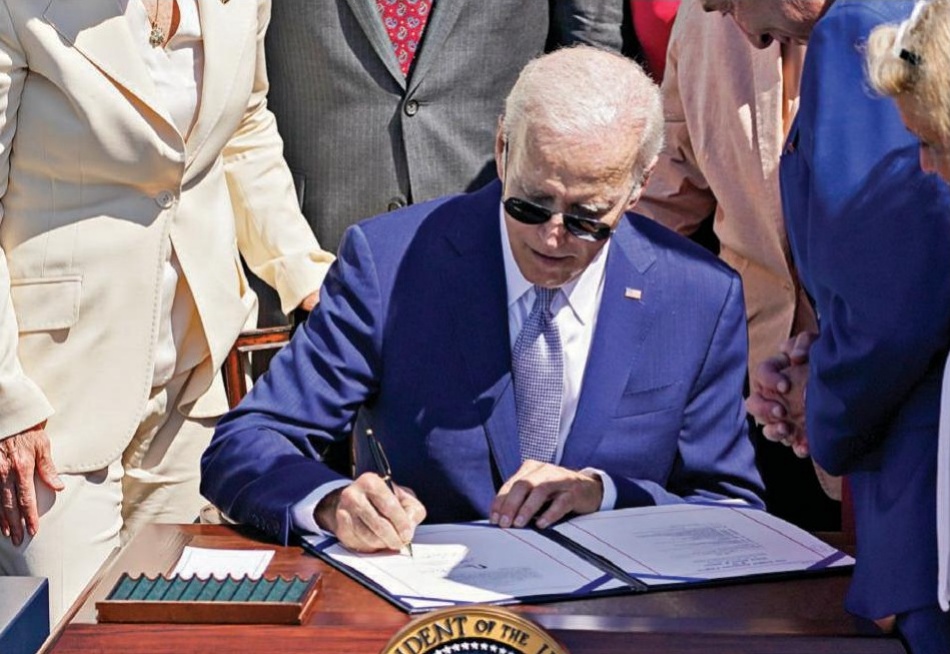
Biden signs a bill to boost U.S. semiconductor production on Aug. 9
POLITICS
Biden’s ‘bland leadership’ may be getting results
BY BRIAN BENNETT
JOE BIDEN SEEMED CAUGHT OFF GUARD. AN AIDE HAD interrupted the President’s meeting with his economic team and a handful of CEOs on a stage in the basement of the Eisenhower Executive Office Building on July 28 to hand him a note. “You’re trying to tell me something, huh?” Biden said. The message informed Biden that the bill to boost semiconductor-chip manufacturing in the U.S. had passed the House, news that brought a wide grin as his staff in the room applauded. “Been trying a long time,” Biden said.
The President may indeed be starting to catch a few breaks. Just the week before, Biden had contracted COVID-19, and key planks of his campaign agenda appeared dead in the water. But Biden recovered quickly from the virus, thanks to protection from vaccine boosters and widely available antiviral medication. And now, after months of dismal approval ratings and being blamed for the worst inflation in decades, he is poised to sign a raft of significant legislation that delivers on a sizable chunk of what he promised voters.
The CHIPS and Science Act will pump more than $52 billion into U.S.-based computer chipmakers, create billions in tax credits to encourage more investment in the American chip industry, and pour tens of billions of dollars into cutting-edge scientific research.
Meanwhile, Senate Democrats passed a sweeping bill that includes massive investments in reducing carbon emissions and lowering prescription drug costs. The Inflation Reduction Act would also set a 15% minimum on corporate tax rates for the largest corporations. It’s now on track to pass the House and head to Biden, who has said he will sign it.
If that bill is enacted, it will join the CHIPS bill and Biden’s success in June ushering through the first gun-safety legislation in decades and the $1 trillion infrastructure package he signed into law in November.
“There was clearly a commitment and a desire on the part of everybody in the Democratic Party—Joe Manchin, thank God, included—in trying to get as much of the big agenda items done before November,” says Ashley Etienne, a former communications director for Vice President Kamala Harris.
It is unclear if those legislative accomplishments would be enough to reverse the decline in Biden’s poll numbers, which continue to hover around 40%. Young voters in particular have soured on him. An average of polls published by FiveThirtyEight found that Biden’s approval among 18-to-29-year-olds has sunk to 37% from over 55% when he took office.
Even the passage of the climate-and-tax bill may not be enough to help Democrats in the midterm elections in November. Concerns about the economy loom large, despite the latest jobs report from the Bureau of Labor Statistics showing 528,000 new jobs added in July, bringing the unemployment rate to 3.5%, the lowest in five decades. While the job market and consumer spending remain strong, the U.S. economy has contracted over the past six months, and any economic impact from that bill and the CHIPS bill would take years to be fully felt.
THE INFLATION REDUCTION ACT falls short of the ambitious policy proposals Biden laid out during the campaign and when he rolled out his wish list last year for the Build Back Better plan. Big portions of Biden’s agenda are all but dead for the foreseeable future. No measure with a pathway to passing touches on his campaign promises to make community college free, invest in eldercare and housing programs, or develop guaranteed paid-leave programs for those caring for loved ones.
Biden has been criticized from the left wing of his party for not pushing Congress harder and not taking more forceful executive actions on immigration, student-loan debt forgiveness, and protections for access to abortions in the wake of the Supreme Court’s decision overturning Roe v. Wade.
The Sunrise Movement, one of the most outspoken climate-activist groups, is pushing for the climate-and-tax deal to pass, while stressing the ways they believe it falls short. “Let’s be clear: this bill isn’t the Green New Deal. It’s not even@POTUS’ Build Back Better. This is the Manchin Climate Plan,” the group tweeted in late July.
It is up to Democrats and Biden to tell Americans what they have accomplished, Etienne says. And the major promises Biden hasn’t been able to land? “We make the argument that we’ve made great progress, and in order to complete the task or to continue even further on these big-ticket items, you need more Democrats,” she says.
Biden’s persistent and understated navigation around the far-left voices in his party may be what voters wanted when they elected him, says Timothy Naftali, a historian at New York University. “People have been quick to describe his presidency as a flop and as unsuccessful, but each time he chooses that middle lane, it yields results,” Naftali says. That “bland leadership” has been frustrating for many Americans, but after the “tumultuous” Trump era, “Biden is delivering cool, calm leadership, likely too bland for young activists, but perhaps that’s what the country needed,” Naftali says.
THE PASSAGE OF THESE BILLS would allow Democrats to “flip the script” going into the fall, says a Democratic House aide. “This isn’t a referendum on Joe Biden; this is about what we’ve done and what we’re trying to do vs. what we know Republicans have as their goals,” the aide says. Democrats will say they took steps to reduce inflation after having stimulated a struggling economy, overhauled the transit system, helped get much of the country vaccinated, and taken other bold steps to help end the pandemic. They will paint Republicans as seeking control of Congress to give tax breaks to corporations, launch investigations into Hunter Biden, and further restrict access to abortion.
Congressional Republicans are portraying Democrats as soft on crime and indifferent to inflation, particularly high gas prices, which Republicans want to address by expanding oil drilling. The top Republican in the House, Kevin McCarthy, said on July 26 at a conference hosted by the Trump-aligned America First Policy Institute that he planned to unveil a seven-point plan in September called the “Commitment to America.” Should they take control of the House next year, Republicans will hold hearings to “rein in” Biden’s Cabinet secretaries, McCarthy said, as well as push for increased police funding, demand harsher border-security policies, vote to pass a “parents bill of rights” in determining what is taught in schools, and create a House committee on China that works to reduce U.S. dependence on Chinese production of precious metals and medicine.
During his meeting with CEOs, Biden grinned as his taciturn Treasury Secretary, former Fed chair Janet Yellen, reported that despite the country’s gross domestic product shrinking for a second quarter, the economy is still adding jobs, American household finances are holding up, and consumers are spending money. “With skill and luck, it will be possible to maintain that strength,” Yellen said.
That prompted Biden to tell a family story. (It never takes much.) He recalled how his grandfather, a college football star who played for Santa Clara College in California in the early 1900s, liked to say that having “Lady Luck” on your team wasn’t enough—a team also needed skill on the bench. “We’re looking for both,” Biden said. Voters in November will decide if Biden and the Democrats have enough of either.
AL DRAGO—BLOOMBERG/GETTY IMAGES
THE BRIEF OPENER

The bill would cap out-of-pocket costs for drugs from pharmacies
NATION
Why Americans may soon see lower drug costs
BY ABIGAIL ABRAMS
AT PRESS TIME DEMOCRATS WERE POISED TO ENACT A SWEEP-ing health care achievement that will address one of the country’s most intractable problems: high prescription-drug costs.
The Inflation Reduction Act would allow Medicare for the first time to negotiate with drugmakers for lower prescription-drug prices. This could be life-changing for older Americans, saving some thousands of dollars a year.
The package would also cap out-of-pocket costs that seniors pay for medications at $2,000 annually and guarantee they have access to vaccines for free. It would require pharmaceutical companies to pay rebates if their drug prices rise faster than inflation. And it would extend the expanded subsidies that 13 million Americans got during the pandemic to buy health insurance under the Affordable Care Act (ACA). All told it would be the biggest change to health care since the ACA was passed in 2010.
Here’s how the health care pieces of the bill would affect Americans.
20
Number of drugs Medicare could negotiate prices for by 2029
$2,000
Maximum annual amount seniors and people with disabilities on Medicare would pay for meds they buy at the pharmacy
$35
Capped price of insulin per month for Medicare beneficiaries
DRUG-PRICE NEGOTIATION
The package would empower the federal government to negotiate prices for certain expensive medications that seniors get at their doctors’ offices or at pharmacies, a goal decades in the making. Starting in 2026, Medicare could negotiate the prices of 10 drugs. That would increase to 15 drugs in 2027 and 2028, and then 20 drugs in 2029.
While it’s not yet clear which drugs would be negotiated and precisely how many Americans would be helped, the provision would curtail costs and deliver significant savings for Medicare over time, according to the Congressional Budget Office (CBO).
LIMIT OUT-OF-POCKET DRUG COSTS
Another piece of the bill would prevent older Americans and those with disabilities from paying more than $2,000 a year for medications they buy at the pharmacy.
Right now, Medicare beneficiaries have no out-of-pocket maximum for drug costs. Once they reach $7,050 in a year, they pay 5% of subsequent costs. Under the new bill, they would not pay any costs for medications once they reach $2,000 in a year.
The bill would also get rid of cost-sharing for adult vaccines covered under Medicare Part D, another provision that experts say would help seniors get the treatment they need.
TACKLING INFLATION
The bill would require drugmakers to pay rebates if their medication prices rise faster than inflation.
Prescription-drug prices have increased sometimes at two to three times the rate of inflation, according to Glen Fewkes, director of health care access and affordability at AARP. The rebates would be limited to those on Medicare.
The pharmaceutical industry argues the changes would hurt the development of new drugs. But the CBO found that the changes in the bill would lead to 15 fewer drugs reaching the market over the next 30 years, or about 1% of an estimated 1,300 in that time.
CURBING INSULIN COSTS
The bill would cap the price of insulin at $35 per month for Medicare patients, 1 in 3 of whom has diabetes. Medicare patients using insulin spent an average of $54 per prescription in 2020, according to the nonpartisan Kaiser Family Foundation—a burden for people on fixed incomes.
OBAMACARE SUBSIDIES
The bill would extend the beefed-up subsidies for low- and middle-income Americans buying insurance under the ACA. The expanded pandemic subsidies were set to expire at the end of this year. Now they would last through 2025.
PAUL RATJE—THE NEW YORK TIMES/REDUX
THE BRIEF NEWS
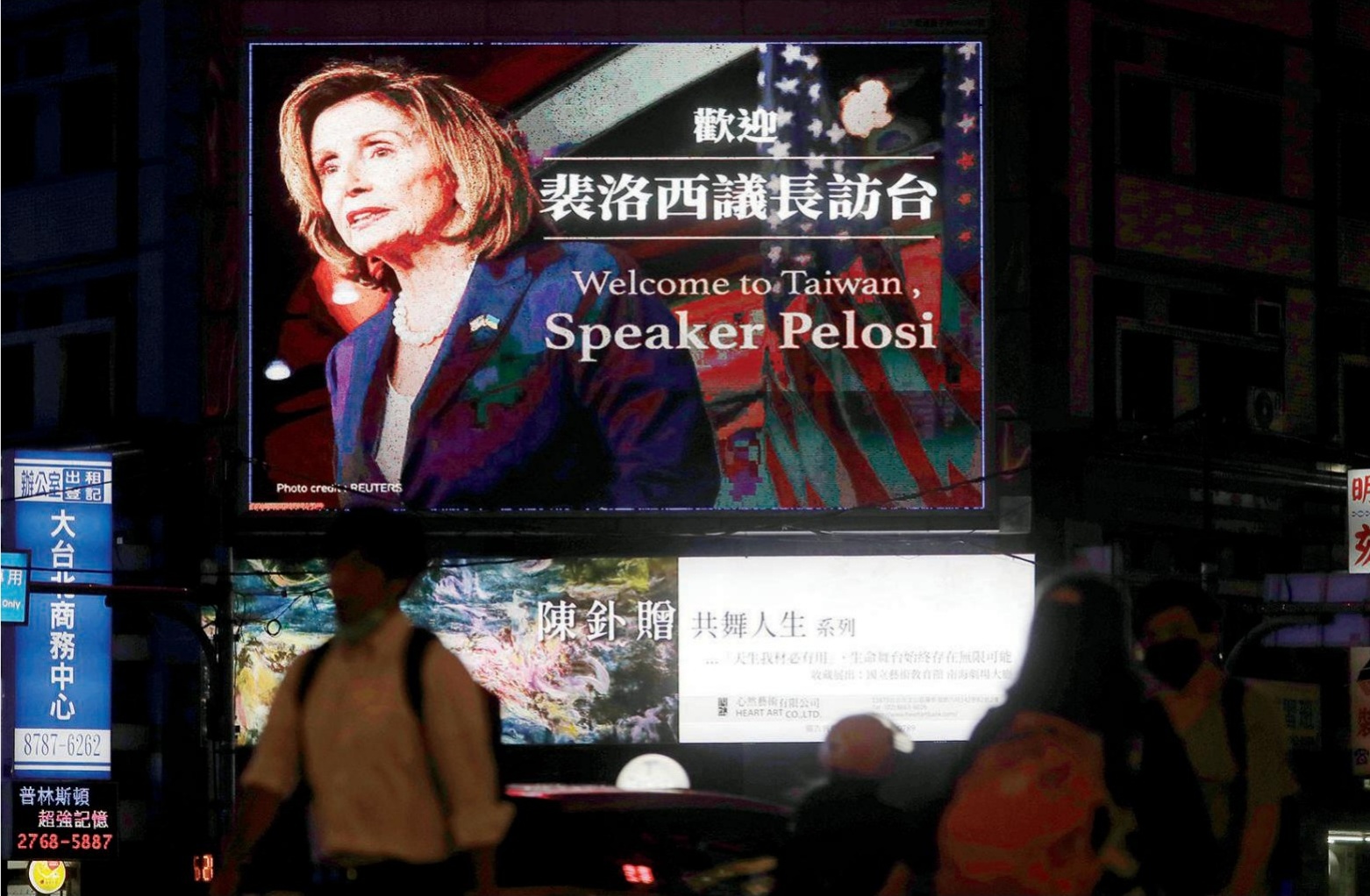
A billboard in Taipei celebrates Pelosi’s visit; some Taiwanese were less enthusiastic
GOOD QUESTION
Did Pelosi’s trip make Taiwan less secure?
BY CHARLIE CAMPBELL
AND LIKE THAT, SHE WAS GONE. U.S. HOUSE Speaker Nancy Pelosi departed Taiwan on Aug. 3 after a lightning visit that included addressing the island’s parliament, visiting its National Human Rights Museum, and holding a televised meeting with President Tsai Ing-wen. Pelosi is the most senior U.S. politician to visit Taiwan in a quarter-century. But Beijing’s reaction to the trip—it considers the self-ruling island its sovereign territory and fiercely opposed the visit—was both swift and unprecedented.
Within hours of Pelosi’s departure, China began several days of live-fire drills and missile tests that encircled Taiwan. The maneuvers are the largest in recent memory and impeded commercial shipping and flights to the island. Taiwan’s Foreign Minister accused Beijing of using the drills as a pretext for taking over the Taiwan Strait, which separates the island from mainland China. Chinese state media said the drills involved over 100 warplanes and more than 10 destroyers and frigates. Some of the missiles flew over Taiwan—a worrying first—while others landed in Japanese waters.
On Taiwan, whether Pelosi’s visit was a good idea remains a point of division. On one side of Taiwan’s legislative building, a group held up banners welcoming her to the “Republic of Taiwan,” in a nod to their aspirations of formal independence. Across the way, pro-Beijing demonstrators brandished placards denouncing the 82-year-old as an “arsonist” meddling in China’s internal affairs.
For many, strong U.S. support is important as the gap between China’s and Taiwan’s conventional military power continues to widen. Yet Taiwanese are largely ambivalent about both these symbolic diplomatic visits and China’s furious reaction to them. “The Taiwanese are largely over it,” says Sung Wen-ti, a Taipei-based scholar for the Australian National University. “They’ve been living under the same threat for about a quarter-century.”
Still, Pelosi’s visit came days after China’s strongman Xi Jinping warned President Joe Biden against “playing with fire” over the island. And beyond the heightened risk of confrontation between the nuclear-armed superpowers, the trip could undermine the U.S. policy of “strategic ambiguity” over whether it would defend the island in the event of an attack. This approach—crafted in 1979 after the U.S. cut off formal ties with Taipei—is intended to avoid riling Beijing and discourage Taiwan from needlessly poking the dragon.
Over the past year, however, Biden has twice said that he would defend the island from China, coming dangerously close to violating this decades-old policy.
As for what exactly Pelosi left behind, we can only wait and watch. But “nobody gains from any of it,” says Shelley Rigger, a professor of political science at Davidson College in North Carolina, and author of Why Taiwan Matters. “The cost to U.S.-China relations and Taiwan security is really high.”
NEWS TICKER
Inflation hits white families less hard
Inflation is causing serious financial problems for the majority of Native American, Black, and Latino households, according to a national poll released Aug. 8 from NPR, the Robert Wood Johnson Foundation, and Harvard. Nearly 70% of Native families and nearly 60% of Black and Latino respondents said rising prices have led to trouble paying bills, compared with 38% of white families.
Calif. accuses Tesla of false advertising
The California department of motor vehicles has accused Tesla of falsely claiming in advertisements that its driver-assist technology made vehicles fully autonomous. Regulators say the names of the features, Autopilot and Full Self-Driving, are themselves misleading.
Emmett Till accuser not indicted
A Mississippi grand jury declined to indict Carolyn Bryant Donham, the white woman whose accusations incited the lynching of Emmett Till almost 70 years ago, despite the recent discovery of an unserved 1955 arrest warrant for her over the Black teen’s kidnapping.
Iranian charged in plot to kill Bolton
The U.S. Justice Department charged a member of Iran’s Islamic Revolutionary Guard Corps with plotting to assassinate former National Security Adviser John Bolton, offering $300,000 for the murder—allegedly in retaliation for the U.S. drone strike that killed Iranian commander Qasem Soleimani in 2020.
BTS could get military exemptions
Boy band BTS might still be able to perform overseas while servingo in the military, South Korea’s Defense Minister said Aug. 1.M Parliament is also debating a bill to shorten military service, which is compulsory for South Korean men ages 18 to 28, from 18 months to three weeks for K-pop stars.
U.K. energy-cost crisis to worsen
Annual U.K. energy bills are to surge to £4,266 ($5,157) in January, an increase of more than 300% from 2021, a consultancy predicted on Aug. 8. Pressure is mounting for enhanced state support—which lags behind the measures introduced by other European countries—amid warnings of widening poverty.
TAIWAN: CHIANG YING-YING—AP
THE BRIEF NEWS
THE BULLETIN
Breonna Taylor’s family sees justice in federal charges
THE AUG. 4 ARREST ON FEDERAL CHARGES of four Louisville, Ky., police officers involved in the raid that killed Breonna Taylor was understood by her family and supporters as the beginning of justice they thought had been denied. Officers raided Taylor’s home using a no-knock warrant in March 2020 and killed her after her boyfriend, believing they were intruders, fired toward them. “I’ve waited 874 days for today,” said Tamika Palmer, Taylor’s mother.
‘FALSIFIED’ WARRANT A federal grand jury in Louisville charged that officers lied both before and after the raid, falsifying an affidavit to get the warrant. “Breonna Taylor should be alive today,” U.S. Attorney General Merrick Garland said in announcing charges that former detective Joshua Jaynes and Sergeant Kyle Meany had willfully violated Taylor’s civil rights “under color of law.” A third officer, Detective Kelly Goodlett, was charged with conspiracy.
EXCESSIVE FORCE The fourth officer, Brett Hankison, was charged with two counts of violating the rights of Taylor and her boyfriend through “unconstitutionally excessive force,” by firing 10 shots through a covered window and a covered glass door. Hankison was the only officer to face state charges, for which he was acquitted in March. If convicted of the federal charges, Jaynes, Meany, and Hankison face sentences of up to life in federal prison.
VINDICATION The Justice Department has long served as a selective backstop in local police shootings, and the indictments were cited by observers who alleged Kentucky Attorney General Daniel Cameron had failed to present all the evidence in the case prepared by the commonwealth. “I hope that we will finally use these cases to look at the system,” says Sadiqa Reynolds of the Louisville Urban League, “and the corruption within the system.”
—JOSIAH BATES
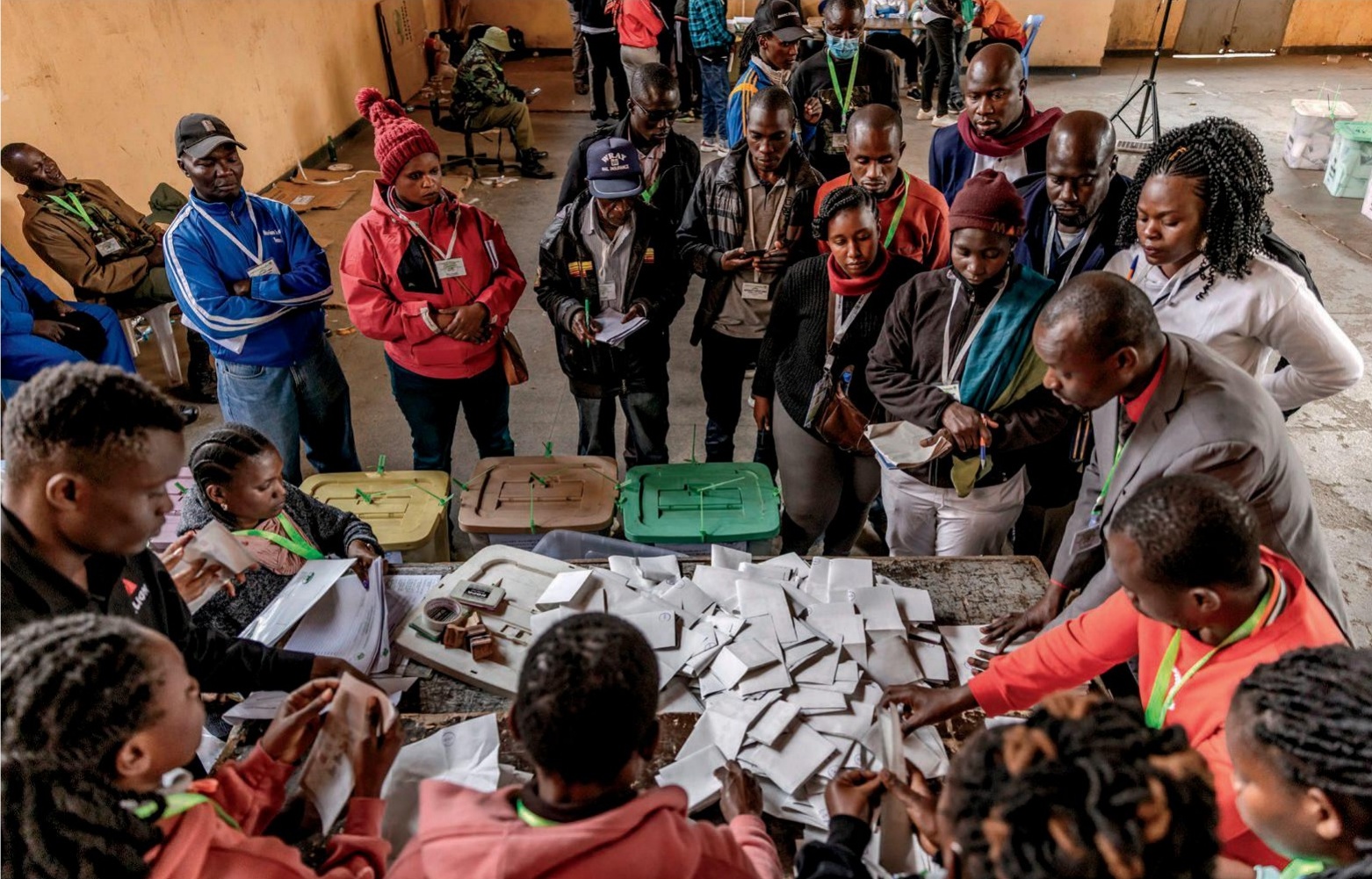
Test for democracy
Kenyans went to the polls on Aug. 9 to replace outgoing President Uhuru Kenyatta following a tightly contested election campaign in which rising living costs and high unemployment in the East African nation dominated discussion. Results were still being counted as TIME went to press on Aug. 10, with little separating the two leading candidates, Raila Odinga, who is making his fifth bid for the job, and William Ruto, Kenyatta’s Deputy President.
LUIS TATO—AFP/GETTY IMAGES
THE BRIEF NEWS

An empty conference room in a Microsoft office in Redmond, Wash.
ECONOMY
Some CEOs are cutting staff even as the job market booms
BY ALANA SEMUELS
IN MANY WAYS, THE U.S. ECONOMY LOOKS VERY STRONG, having added 528,000 jobs in July, according to official figures published on Aug. 5—almost double what analysts had expected. The unemployment rate dropped to 3.5%—it hasn’t been lower in half a century. And consumers are still opening their wallets—retail spending in July increased 11.2% over the previous year, according to the Mastercard SpendingPulse, which measures in-store and online retail sales across all forms of payment.
Yet some CEOs are cutting jobs based on feelings of doom and gloom, even though their companies are thriving—actions that could negatively affect consumer sentiment. Earlier this summer, Elon Musk reportedly emailed colleagues at his electric-vehicle company Tesla that he had a “super bad feeling” about the economy and that he planned to cut staff at Tesla by 10%, a plan he later executed. The next month, Musk said during an earnings call that the second quarter of 2022 was “one of the strongest quarters of our history,” and that Tesla had the potential for a “record-breaking” second half of the year. Meanwhile, Oracle made cuts across the company despite reporting that revenues were up 5%—and that the company “finds itself in position to deliver stellar revenue growth over the next several quarters.” Microsoft laid off around 1,000 people and then reported in late July that profit rose 2%. Even Ford, which said in late July that its net income rose 19% and that consumers are buying products as quickly as the company can make them, is planning to cut thousands of workers in the coming weeks.
The debate over whether the U.S. is in a recession is ongoing, but if a downturn does hit, CEOs, not consumers, might stand to shoulder most of the blame, after conducting widespread layoffs even as their companies perform well. Some may be incurring higher staff costs to attract talent (hourly earnings are up 5.2% from 2021), but recent layoffs and hiring freezes are unusual because they are anticipatory, rather than reactionary.
“I do believe only the paranoid survive,” Spotify’s Daniel Ek said in late July, while announcing the company would “proactively” reduce hiring by 25%. “And we are preparing as if things could get worse, but it’s hard to be anything but optimistic given what I am currently seeing.” The company added 5 million more users than anticipated last quarter, and posted 23% revenue growth.
528,000
Number of jobs the U.S. economy added in July
3.5%
U.S. unemployment rate in July
32,000
Number of additional jobs the U.S. economy has, compared with February 2020
For much of the past century, companies didn’t lay off workers until they were in trouble and needed to cut costs, says Matthew Bidwell, a professor of management at the Wharton School at the University of Pennsylvania. Then, in the 1990s, even profitable companies started to downsize. “They got comfortable with, ‘We’re making money, but we can be making even more money,’” he says. In 1979, the year before a “new capitalism” focused on efficiency became popular in the U.S., fewer than 5% of Fortune 500 companies announced layoffs; during the Great Recession and its aftermath, 65% did. Hiring and firing has become a way for CEOs to signal that they’re strong, decisive leaders, taking bold action, Bidwell says—even though those decisions might fly in the face of what’s best for the company or the wider economy.
LAYOFFS CAN PLAY a role in how the economy is perceived, which may have a knock-on effect elsewhere. American households may cut back on spending in anticipation of bad times, even if their finances are doing well, and laid-off workers will behave cautiously until they find new jobs.
Research shows that layoffs are almost always bad for a company, says Sandra J. Sucher, a professor of management practice at Harvard Business School. Workers who aren’t laid off will start looking around for other jobs because they feel uneasy about their employer’s prospects. Those who are laid off will find jobs at competitors and help them innovate. Downsizing a workforce by 1% can lead to a 31% increase in voluntary turnover, according to one study. Another study found that after a layoff, survivors at the companies experienced a 41% decline in job satisfaction.
“The fact that these turn out to be self-defeating decisions makes this a particularly bad strategy,” Sucher says. “These CEOs may be spooked by what’s going on, but that doesn’t mean they’re smart, it means they need to regulate their anxiety.”
LAYOFFS: CHONA KASINGER—BLOOMBERG/GETTY IMAGES
THE BRIEF NEWS
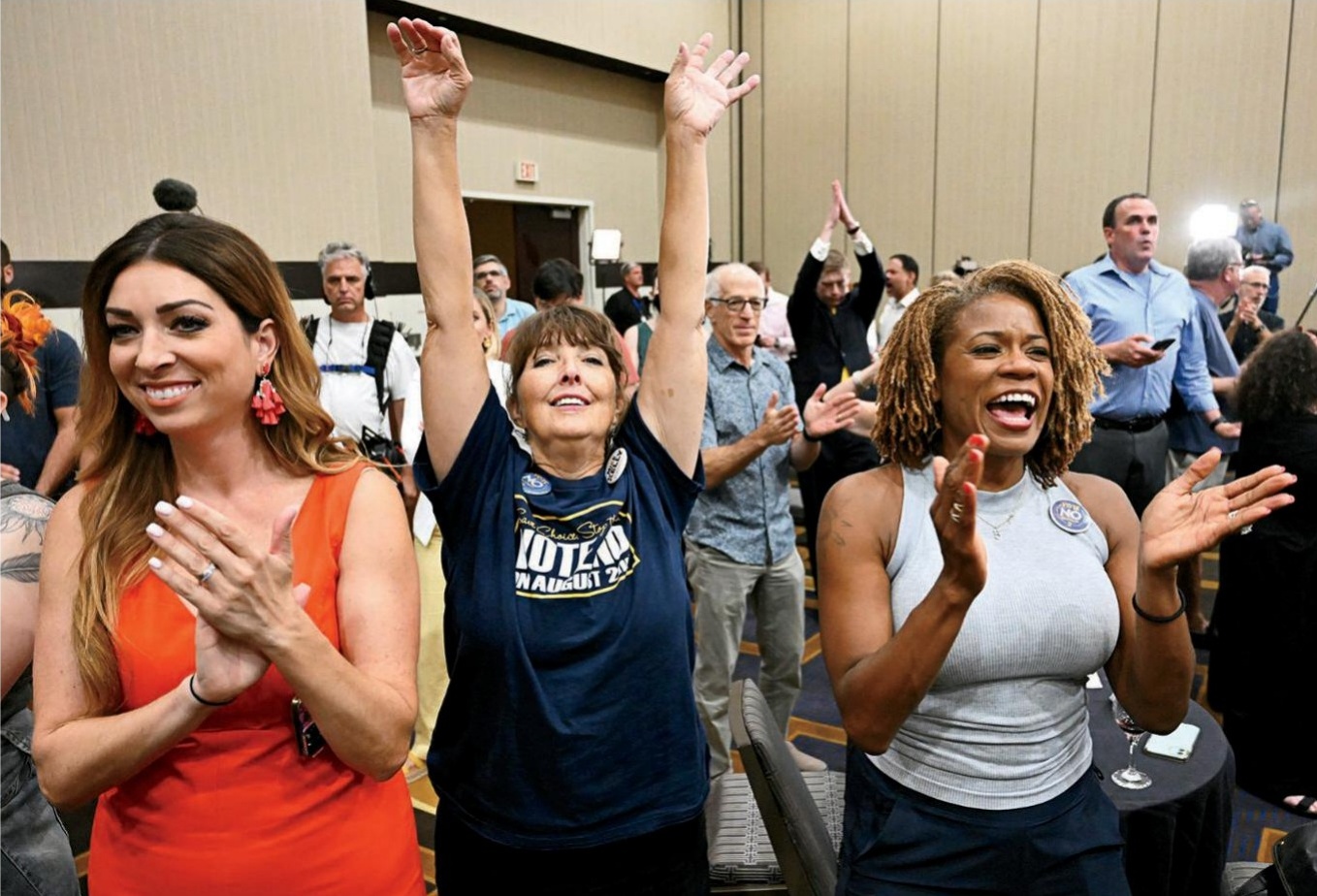
From left, Calley Malloy, Cassie Woolworth, and Dawn Rattan cheer the win for abortion rights on Aug. 2
HEALTH CARE
Kansas previews road map to protect abortion access
BY ABIGAIL ABRAMS AND MADELEINE CARLISLE
ANNE MELIA HAD CANVASSED WITH AN ABORTION-rights group for months, urging Kansas residents to vote no on a ballot measure that would have amended the state constitution to say there was no right to an abortion in the state.
But she never “in a million years” thought Kansas voters would so strongly reject the constitutional amendment on Aug. 2, with 59% voting no and 41% voting yes.
The vote was the first major win for abortion-rights supporters since the Supreme Court overturned Roe v. Wade on June 24. The outcome demonstrated a strong public backlash to the Supreme Court’s decision, and created a road map for both Democrats running in November’s midterms and abortion-rights advocates who hope to use similar ballot measures to enshrine abortion rights in other state constitutions.
Registered Republicans greatly outnumber Democrats in Kansas, and the state consistently favors the GOP in presidential elections. But Kansas also has plenty of moderate and unaffiliated voters, and abortion-rights supporters appealed to them in their outreach ahead of the primary. Voters in increasingly Democratic areas like the Kansas City suburbs rejected the measure by huge margins, and the vote in rural areas was closer than either side expected. In urban and rural counties alike, the vote to protect abortion rights performed better than Joe Biden did against Donald Trump in 2020.
THE OUTCOME IN KANSAS may preview how much the issue of abortion—which has historically motivated more voters on the anti-abortion side—could influence the midterm elections.
Turnout in Kansas was unusually high. At least 922,300 people voted on the ballot measure, compared with the roughly 457,000 people who voted in the 2018 primaries. Voter registration surged 1,000% on June 24, the day Roe v. Wade was struck down, and the increases were particularly strong among Democrats and women, according to Tom Bonier of political data firm TargetSmart.
Yet it remains to be seen how abortion will stack up against issues like inflation in voters’ minds come November. “Even if they disagree with Republican candidates on the issue,” says Miles Coleman, associate editor of the election forecaster Sabato’s Crystal Ball at the University of Virginia’s Center for Politics, “is it going to override their concerns about inflation or the economy?”
‘It is politically inspiring for folks to not run away from this issue.’
—KELLY HALL, EXECUTIVE DIRECTOR OF THE FAIRNESS PROJECT
KANSAS’ VOTE ALSO HIGHLIGHTS the key role that state constitutions will play in the nation’s abortion landscape going forward. Without a federal right to abortion, the procedure’s legality will largely be determined at the state level. “Kansas is a model for a path to restoring reproductive rights across the country through direct democracy,” Alexis McGill Johnson, president of Planned Parenthood Action Fund, said in a statement.
Abortion will be on the ballot elsewhere this year, with voters in Kentucky, California, and Vermont set to weigh in. Advocates have also submitted more than 750,000 signatures to put a constitutional amendment protecting abortion rights on the ballot in Michigan this fall.
If abortion rights can win in Kansas, “it is advocacy-inspiring,” says Kelly Hall, executive director of the Fairness Project, which is working on the ballot measures in Michigan and Vermont. “I hope that it is also politically inspiring for folks to not run away from this issue, no matter what corner of the country they’re in.”
KANSAS: TAMMY LJUNGBLAD—THE KANSAS CITY STAR/AP
THE BRIEF NEWS
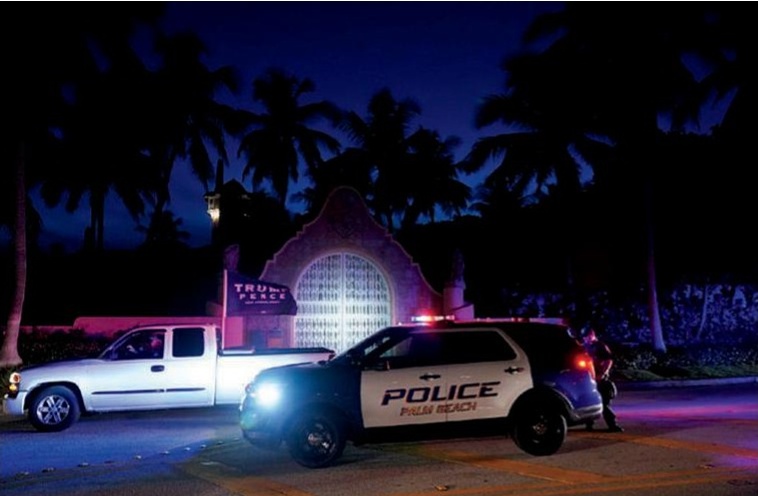
A Trump supporter, left, drives past the ex-President’s Mar-a-Lago estate on Aug. 8
POLITICS
Trump allies seek political gain from FBI Mar-a-Lago search
BY BRIAN BENNETT
WITHIN HOURS OF FBI AGENTS SEARCH-ing Donald Trump’s Mar-a-Lago residence on Aug. 8, the Republican National Committee urged voters to fight back with their wallets. “In an UNPRECEDENTED move Joe Biden’s Department of Justice RAIDS President Trump’s home at Mar-a-Lago,” the RNC’s call for donations read. “Donate ANY AMOUNT RIGHT NOW to show your support for the GOP to take back Congress and STOP JOE BIDEN.”
It was one of multiple signs that the unprecedented move by federal law enforcement to execute a search warrant on a former President’s home was quickly mobilizing Trump’s base and allowing his supporters to monetize what was otherwise a stunning escalation of the federal investigations into him.
Federal officials have been investigating allegations that Trump mishandled classified documents while he was in office and when he moved out of the White House on Jan. 20, 2021, taking boxes of papers that arguably should have been handled by the National Archives. It was not immediately clear whether those documents were the sole reason for the search, but it fit the profile of a President who struggled with the concept of public service. In a forthcoming book, longtime Trump chronicler Maggie Haberman reports that the President more than once flushed documents down toilets.
With few details available, both Trump supporters and critics were left speculating as to the purpose of the search. For allies of the former President, however, the move had nothing to do with Trump’s past actions, or the possibility of a Justice Department acting independently of politics, and everything to do with 2024.
“This continuous, irrational, obsessive quest to destroy Donald Trump is just further proof that the Biden Administration is just solely focused on politics and not addressing the issues the American people really care about,” says Hogan Gidley, Trump’s former White House deputy press secretary, who still speaks with him.
Even former officials who have criticized the 45th President warned that the mishandling of classified documents might be interpreted as a skimpy rationale. “This better not be chickensh-t,” says a former senior Trump White House official, who requested anonymity to speak more freely.
“This, I’m hoping, goes beyond simply not complying with some archiving laws, or DOJ just handed Donald Trump the Republican nominee and potentially the presidency,” Alyssa Farah, Trump’s former White House director of strategic communications turned critic, said on CNN.
The Department of Justice appears to be accelerating investigations that may reach deep into Trump’s orbit. Along with investigations into his handling of classified documents, prosecutors have ramped up the investigation into the Jan. 6 attack on the Capitol. In a separate investigation in Georgia, close allies of Trump have been asked to testify before a grand jury hearing allegations of interference in the 2020 election.
The U.S. District Court of Appeals for D.C. recently affirmed that the Internal Revenue Service can hand over Trump’s tax returns to the House Ways and Means Committee, potentially giving Democrats critical information about Trump’s finances.
The bolt from Mar-a-Lago came a day after Senate Democrats passed a landmark climate and health care package, one of a run of measures that lifted Democratic hopes for the midterms. Republicans, already harping on Democrats for approving more money for the IRS, found their theme of government overreach amped by the FBI search. “There is no question this will mobilize Republican voters,” Gidley says.
TRUMP: WILFREDO LEE—AP
THE BRIEF MILESTONES
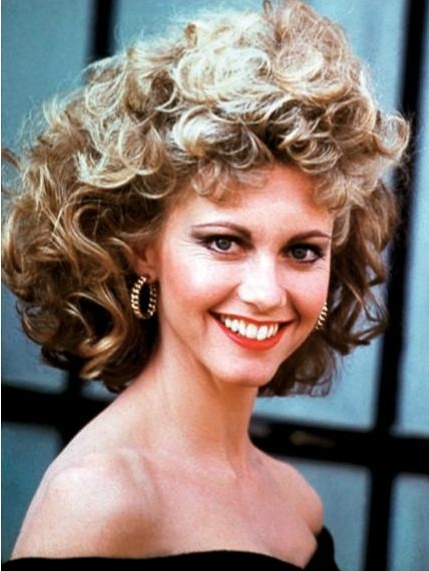
DIED
Olivia Newton-John
A silky star
AMONG THE SUNNIEST pleasures of top-40 radio in the 1970s and ’80s were the songs of Olivia Newton-John, who died on Aug. 8 at age 73 following a decades-longd battle with breast cancer. Her silky, flaxen voice—in pillowy ballads like “Have You Never Been Mellow” and subtly foxy seductions like “A Little More Love”—always brought with it a rush of joy and warmth.
Her films were ambrosial too. In the 1978 Grease, Newton-John’s good-girl Sandy embodied both the wistfulness and the sunburnt bliss of summer’s last days. Her 1980 film Xanadu, in which she played a singing, dancing, rollerskating goddess, wasn’t a hit. But to watch it today is to revel in Newton-John’s rainbow radiance, and to see how a performer can be both of her time while also, like a breezy emissary from Mount Olympus, living forever outside it.
—STEPHANIE ZACHAREK

Ayman al-Zawahiri, right, with Osama bin Laden in 2001
KILLED
Ayman al-Zawahiri
A Sept. 11 plotter who found haven in Afghanistan
AYMAN AL-ZAWAHIRI, 71, WHO TOOK over al-Qaeda after Osama bin Laden’s death in 2011, was killed by a U.S. drone strike in Kabul on July 31.
An Egyptian physician who joined his first jihadist cell in his teens, Zawahiri helped plan the Sept. 11, 2001, attacks, as well as the 1998 bombings of U.S. embassies in Kenya and Tanzania. Biden Administration officials have said Zawahiri remained in charge of the terrorist group up until his death.
The killing of Zawahiri with two bladed missiles in Afghanistan’s capital demonstrated the deadly power and reach of U.S. intelligence services, even a full year after President Biden withdrew all U.S. forces from the country. But one aspect of the assassination is alarming counterterrorism experts: its precise location.e The fact that al-Qaeda’s top leader was living with his family in an expensive neighborhood in downtown Kabul broke into public view the degree to which the Taliban has given al-Qaeda’s leadership license to operate inside the country; Zawahiri was described as a guest of a leader of the Haqqani network, a terrorist militia that holds ministerial positions in the government. “We believe that there were senior members of the Haqqani network who are affiliated with the Taliban who did know that al-Zawahiri was in Kabul,” Jake Sullivan, Biden’s National Security Adviser, said on NBC News. Security experts also warn that the Taliban could once again allow al-Qaeda to use the country as a safe haven to plot attacks.
Zawahiri was “being given VIP treatment” in Kabul, says Bruce Hoffman, an expert on counterterrorism and homeland security at the Council on Foreign Relations. “One can only imagine the kind of treatment that other al-Qaeda officials and fighters are getting,” Hoffman says.
—BRIAN BENNETT WITH W.J. HENNIGAN
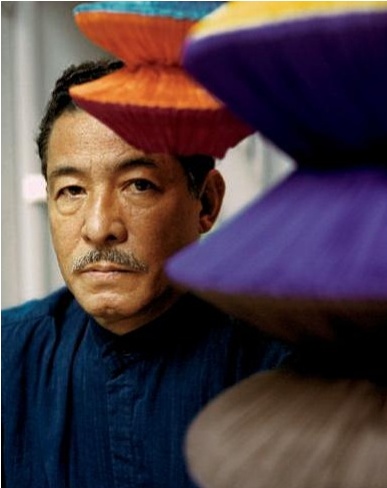
DIED
Issey Miyake
Known for his signature pleats and avant-garde cuts, and for designing Steve Jobs’ iconic turtleneck, Issey Miyake, who died of liver cancer at 84 on Aug. 5, viewed fashion as a medium for innovation.
He opened his studio in 1970 and put Japan at the forefront of the global fashion scene with his technical precision and creative vision, turning out wondrous garments that transcended gender, size, race, and age.
As a child growing up in Hiroshima, he survived the 1945 U.S. atomic-bomb blast, and his approach to design had an innately humane quality.
Miyake was also refreshingly pragmatic, dedicated to creating items that were comfortable, affordable, and practical enough for everyday use. “Design is not for philosophy,” he once famously quipped. “It’s for life.” —Cady Lang
DIED
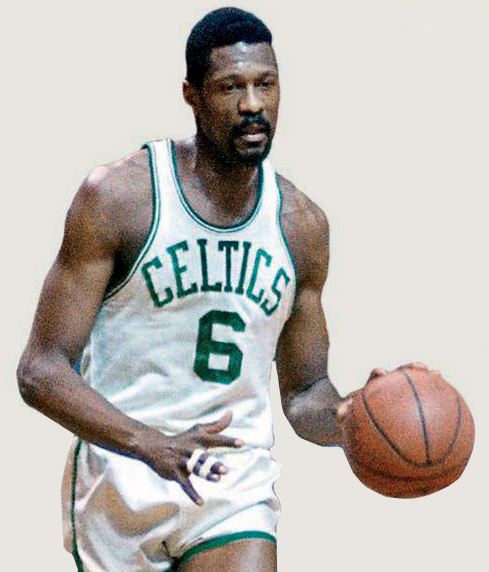
NBA icon and civil rights activist Bill Russell,R at 88, on July 31.
Barrier-breaking Star Trek actor Nichelle Nichols, at 89, on July 30.
RELEASED
Uvalde, Texas, school-shooting victim Mayah Zamora, 10, from a hospital after more than 60 days, on July 29.
SUSPENDED
Uganda’s leading LGBTQ-rights charity, on Aug. 5 by the country’s government, which also enforces some of the world’s toughest anti-LGBTQ laws.
ARRESTED
A suspect in the killing of four Muslim men in Albuquerque, N.M., on Aug. 9. The shootings had led several Muslim residents to isolate at home or leave town.
NEWTON-JOHN: MARY EVANS—EVERETT COLLECTION; AL-ZAWAHIRI: HAMID MIR—AUSAF/REUTERS; RUSSELL: DICK RAPHAEL—NBAE/GETTY IMAGES; MIYAKE: DENIS DAILLEUX—AGENCE VU/REDUX
THE BRIEF WORLD
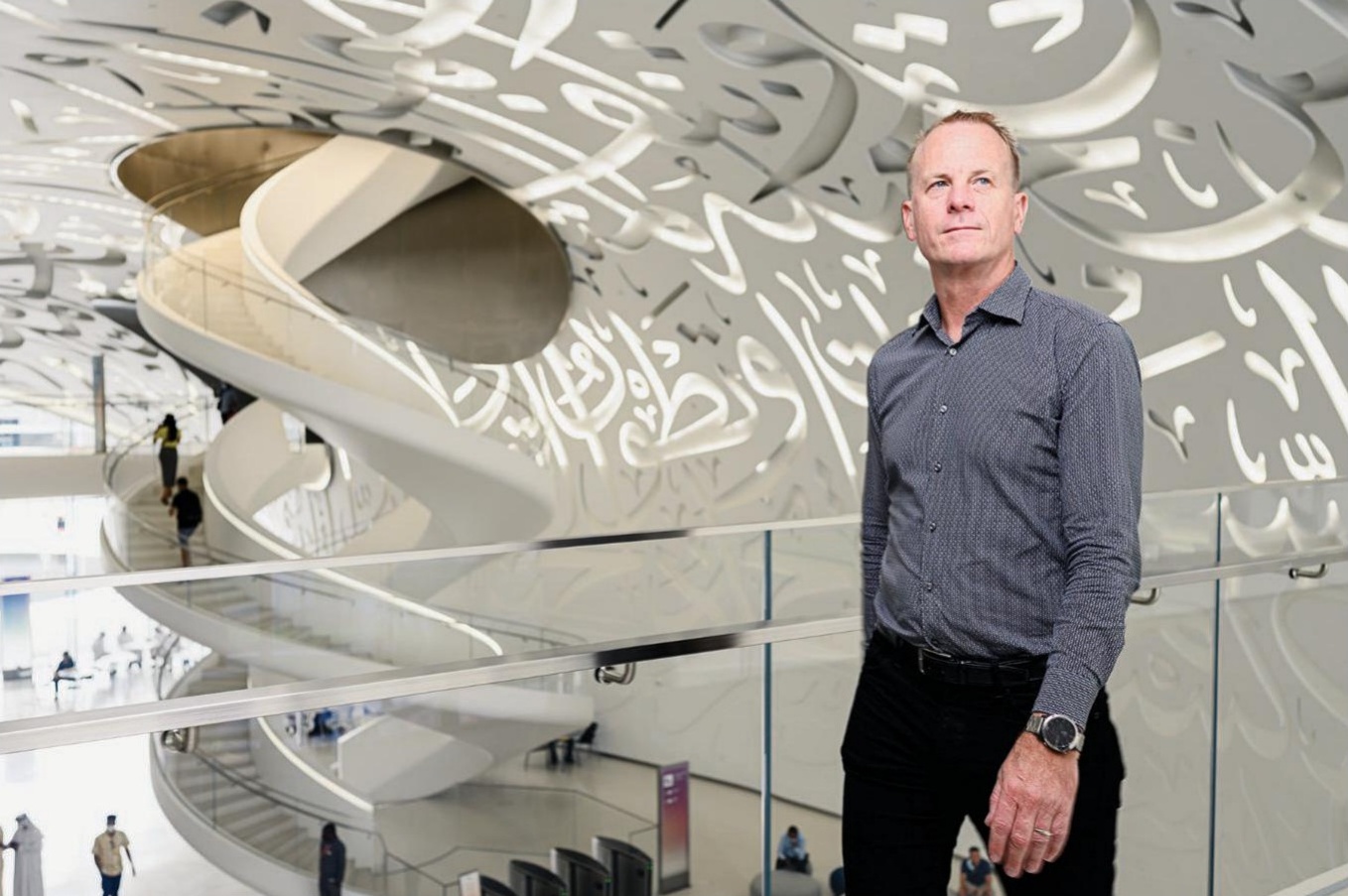
Shaun Killa, design partner at Killa Design
ARCHITECTURE
Building the designs of the future
BY NICOLA CHILTON
THE SHIMMERING TORUS-SHAPED MUSEUM OF THE FU-ture in Dubai is covered in Arabic calligraphy and is supported not by the traditional columns but by a steel diagrid, with a facade of 1,024 steel panels. The aviation industry provided inspiration for the technology needed to create the exterior that was developed using learning algorithms. “All the parameters structurally were put into a program, and eventually it learned to create this shape,” says architect Shaun Killa.
Opened in February 2022, the building is an iconic addition to Dubai’s already dramatic skyline, which includes the sail-shaped Burj Al Arab and the Burj Khalifa, the tallest building in the world. These modern, globally recognizable structures have made a name for Dubai’s architecture, but the story of Dubai’s urban landscape goes back much further. “Often the story is that since the 2000s it’s been a place of gleaming skyscrapers,” says architect and writer Todd Reisz, author of Showpiece City: How Architecture Made Dubai. But the creative fusion seen in the architecture of structures like Killa’s Museum of the Future goes deeper. “I think what has had the most influence on the city is the fact that it’s an entrepôt, a port city,” says Reisz. “It’s a place of exchange and in-betweenness, where not only things and people come in and out, but so do ideas.” That exchange of ideas has led to some of the world’s most ambitious architectural projects—in which Killa has played an outsize role.
‘People come in and out, but so do ideas.’
—TODD REISZ, AUTHOR AND ARCHITECT
KILLA FIRST ARRIVED in Dubai from South Africa in 1998, joining architecture firm Atkins, where he worked on the Burj Al Arab—one of Dubai’s most famous buildings, which sits on an artificial island and is shaped like the sail of a yacht. “For an architect coming from Cape Town, the scale of the buildings was so much bigger,” Killa says of Dubai. “If you’re used to smaller projects, it’s quite a challenge to overcome that scale.” Killa went on to work on other major projects in Dubai such as the Dubai Opera, the Address Boulevard, and the Almas Tower, the tallest building in Dubai at the time.
Killa launched his own architecture studio, Killa Design, in 2015, with a desire to make futuristic buildings that combine engineering innovation and technology. Sustainability is also a driving force. For the Bahrain World Trade Center (BWTC), completed in 2008, Killa worked with wind-tunnel and bridge specialists to create a building that is made up of two wing-shaped structures with three 30-m wind turbines suspended between them. The structures funnel wind onto the turbines, which generate up to 15% of the building’s power.
Killa has helped advance architectural innovation in Dubai through his “challenging designs and to demonstrate the capacity to construct them using the latest technologies in the market,” says Georges Kachaamy, director of the Center for Research, Innovation, and Design at the American University in Dubai.
Killa also sees the importance of focusing on the livability of buildings and cities, and creating more cyclable and walkable areas. “There is a strong emphasis on creating a better place to live, with greater diversity,” he says.
With its unusual facade, the Museum of the Future, located in Dubai’s financial district, features frequently on Instagram posts. And like the city itself, it has become a place of exchange—an outsize space where people gather, marvel, and commune. “That enjoyment that I saw people having really filled me with something that was very special,” Killa says of the public reception to the museum. “The building has now been passed to them.”
TIME’s Destination Dubai series is presented by See the video at time.com/DestinationDubai
SIDDHARTH SIVA FOR TIME
THE BRIEF TIME WITH

Parker, photographed outside Chicago on May 12
Basketball star Candace Parker takes stock of life beyond the court
BY SEAN GREGORY/DEERFIELD, ILL.
CANDACE PARKER WAS ALREADY ENJOYING A monumental run in her life last year. One of the greatest women’s basketball players of all time won her second WNBA championship, capping a storybook return home: the Illinois-raised athlete had signed with the Chicago Sky before the previous season and delivered the franchise its first ever WNBA title. Her media work, providing commentary on TNT’s highly popular and influential NBA program, was receiving rave reviews. Parker was a basketball force.
Then, late last year, her journey took another significant turn. On Instagram, she revealed publicly, for the first time, that she had been married for two years to Anna Petrakova, a former Olympic basketball player from Russia who played with Parker on a pro team there. Parker, who was previously married to former NBA player Shelden Williams, shared pictures from the couple’s 2019 wedding—which 50 guests, plus workers, were required to keep secret. Parker also announced that the couple was expecting a child. Their son, Airr Larry Petrakov Parker, was born in February.
During an interview in suburban Chicago on an off-day for the Sky, who are in first place in the Eastern Conference heading into the WNBA playoffs starting Aug. 17, Parker, 36, reflected on her decision to take her relationship public. One reason she and Petrakova kept their marriage under wraps was the hard reality of Russia’s anti-LGBTQ+ policies: Petrakova was concerned she’d be subject to discrimination. But with a baby now on the way, Parker and Petrakova felt the timing was right. Plus, Parker wanted to send a strong message to her daughter Lailaa, now 13. “I always tell my daughter to be proud of who she is,” says Parker. “And I always tell my daughter to speak for herself and speak up for those that she loves. And I can’t say that to her if I’m not doing it myself.”
Parker’s announcement resonated with both her family and the LGBTQ+ community. Her message, plus her continued accomplishments on the floor, her strong performances on TV, and her ability to manage the demands of motherhood and a full-time sports career, have set her up to become one of the key figures in American sports and culture for years to come.
PARKER QUICK FACTS
High school highflyer
In 2004, Parker became the first woman to win the slam-dunk competition at the McDonald’s High School All-American game, beating out future NBA players like J.R. Smith and Rudy Gay. “Parker sparked a raucous ovation, chest bumps from her teammates, and officially launched herself as the female answer to LeBron James,” ESPN wrote.
Cover star
Parker covers the 2022 edition of the popular NBA2K video-game franchise, the first woman to do so.
Graceful aging
In May, Parker, 36, became the oldest player in WNBA history to record a triple-doubled (double-digit points, rebounds, and assists in one game). She picked up another in June.
Canine crew
Parker has three dogs: a cavapoo, a rottweiler, and a mini dachshund. “People think I’m a dog walker,” ,” she says.
PARKER GREW UP breathing basketball. A college recruiter once visited the Parker home, trying to woo her older brother Anthony, who would later play nine years in the NBA; Candace, who was 6 or 7, told the coach about his team’s defensive shortcomings.
Parker was the Gatorade Girls High School Player of the Year in 2003 and 2004; she is still the only girl’s basketball player to receive this accolade in back-to-back years. As a redshirt freshman at the University of Tennessee, Parker became the first woman to dunk in an NCAA tournament game. Tennessee won back-to-back titles in 2007 and 2008.
As a first-year pro in 2008, Parker won a gold medal at the Beijing Olympics, and was named WNBA MVP and Rookie of the Year playing for the Los Angeles Sparks. She was unknowingly in the early stages of pregnancy with Lailaa. “My daughter was along for the journey,” Parker says. “She got an Olympic gold medal, won the MVP and Rookie of the Year before she was even born. That’s so special for me, because it encompasses what women are capable of.”
Parker spent her WNBA off-seasons playing professionally in Russia, China, and Turkey, Lailaa in tow. Salaries are more lucrative for female players overseas. During the WNBA season, she continued to thrive, winning a second league MVP in 2013 and a title with Sparks in 2016. Before the 2021 season, Parker decided to return home to Chicago. She led the Sky to a championship.
Parker, who has had eight knee surgeries, is still unsure if this will be her final season. “I live in the moment,” she says. But whenever retirement from basketball arrives, Parker has a luxury unavailable to most athletes: a second career awaiting her. She’s one of the first women to be featured on TNT’s NBA studio programming. “The biggest thing for me when I came in is that I said that I’m not trying to be one of the guys,” says Parker. “I’m Candace. I’m not going to change who I am.”
Her exchanges with Shaquille O’Neal have stood out, including a viral clip from March 2021 when Parker patiently explained to Shaq how the current ubiquity of the three-point shot has changed NBA defense. “It’s a confidence that she walks with,” says fellow analyst Dwyane Wade. “She knows she’s an expert. So it’s so dope to sit next to her and hear her perspective on the game, because it always gives me a different way to think of it.”
‘Society had a way of putting this pressure on people to come out.’
—CANDACE PARKER, CHICAGO SKY FORWARD
IN RUSSIA, PARKER PLAYED for UMMC Ekaterinburg, the top women’s team in the country, from 2010 through 2015. Brittney Griner was playing for UMMC Ekaterinburg at the time of her arrest in February. On Aug. 4, a Russian judge sentenced Griner, whom the U.S. government has designated “wrongfully detained,” to nine years in prison for carrying cannabis oil in her luggage. “Everybody is just ready for this unjust detainment and now sentence to be over and for her to be back,” says Parker. “We can help fight for her freedom, but she won’t get the time back. Let’s not have her lose any more of either.”
Petrakova joined UMMC Ekaterinburg in 2012. Parker and Petrakova would stay up late and talk. “There were some drunken nights,” Petrakova says, laughing. During one of those evenings, they kissed for the first time. “We’re scared, and we’re like, ‘What the hell was that?’” Petrakova says. Neither Parker nor Petrakova had ever imagined herself married to a woman. But in 2019, Parker got on one knee and told Petrakova to look at a cake Lailaa was holding. On it was a question: “Will you marry us?”
“She knows that Lailaa is the center of my entire universe,” says Parker. “So we come in a package deal. It was important for the dynamic duo to be upgraded to the Big Three.”
The crew is now a quartet, with the arrival of Airr Larry. His first name is pronounced Air, as in Air Jordan. Given the name, Parker knows her son has no choice but to take up basketball. “A drop-step dunk is definitely in his future,” says Parker. “His hands are huge.”
Parker and Petrakova had long feared that the social media blowback to their relationship would be hurtful to them and, most important, to Lailaa. But they’ve both been pleasantly surprised. Aside from an occasional ignorant comment, they’ve received mostly positive feedback. “Society had a way of putting this pressure on people to come out,” says Parker. “And I don’t think it should be that way. You should be able to choose the parts of your life that you share and the parts you keep private. And I hope I was able to open up the door of conversations. And open up the door of how valuable it is to have support.”
NOLIS ANDERSON FOR TIME
THE BRIEF POSTCARD
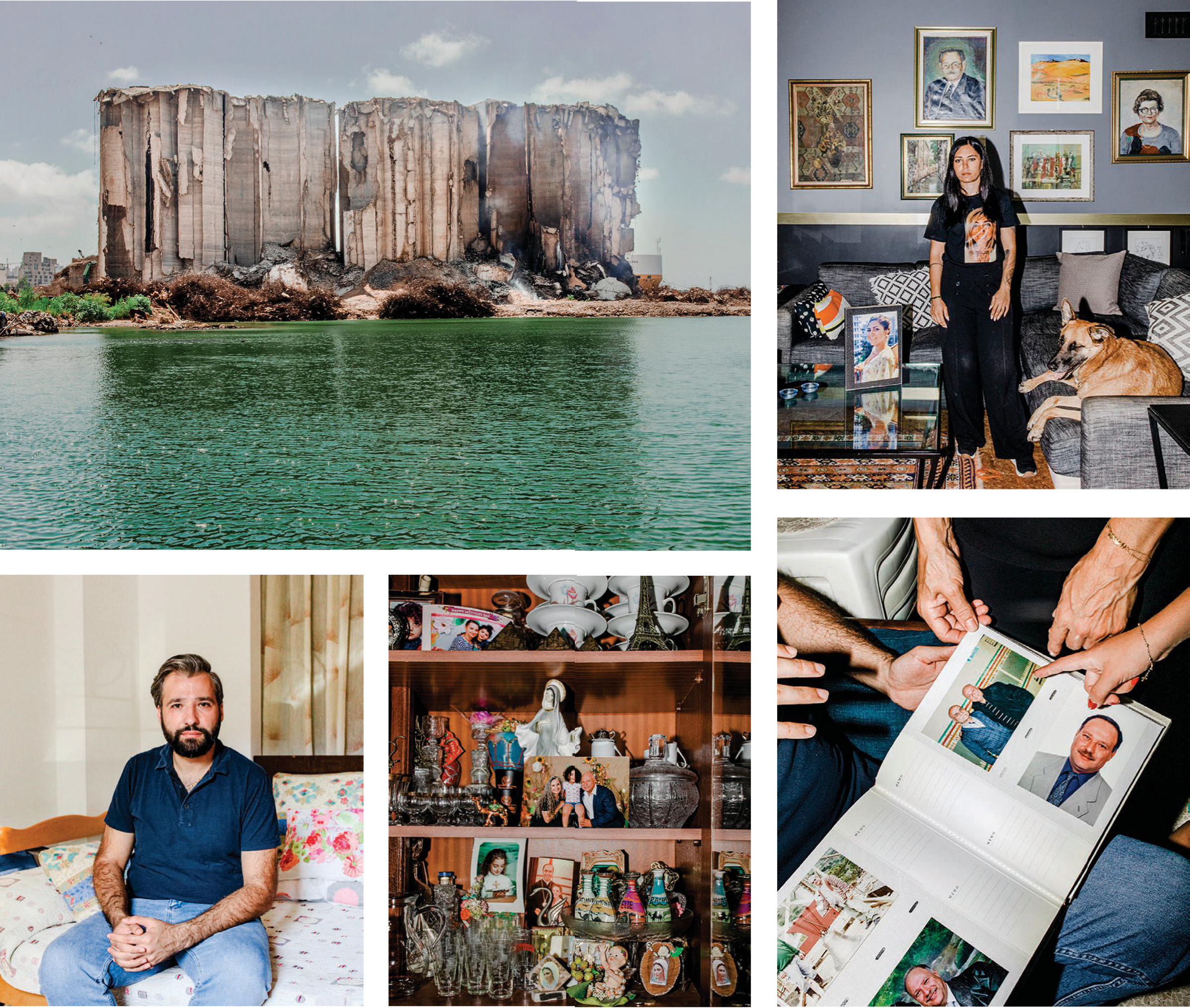
Clockwise from top: Beirut’s port silos on July 22; Mariana Fodoulian; a photo album of Elie Hasrouty’s father Ghassan; a vitrine in the Hasrouty home; Elie Hasrouty
WORLD
The fight to save icons of the Beirut blast, two years on
BY CLÉMENT GIBON
PHOTOGRAPHS BY MYRIAM BOULOS FOR TIME
AT GATE 9 OF BEIRUT’S PORT IN MID-JULY, ALL EYES were on the mammoth concrete grain silos. There was a blazing fire, and plumes of smoke were billowing out of the northern block of silos. Rima Zahed was here at a protest holding a portrait of her brother Amin, one of the 218 people who were killed in the catastrophic Aug. 4, 2020, explosion at the port, which left the silos a disemboweled shell of their former selves. Zahed feared the additional damage would cause them to collapse—and denounced the Lebanese authorities for not stamping out the blaze.
“The authorities told us that the fire was extinguished despite the fact that it was growing. They could have stopped it,” Zahed said. Her fears were borne out on July 31, when some of the silos first collapsed, kicking up thick dust around the port. More silos fell on the two-year anniversary of the blast—reigniting trauma for many Lebanese.
Beirut’s port silos were first completed in 1970, and before the explosion they stored some 85% of Lebanon’s grain. Jean Touma, a former director of the silos, says they had long ensured the country’s food security.
But in April, Lebanon’s Cabinet approved the demolition of all of Beirut’s port silos—both the northern and southern ones—located at the site of the 2020 blast. Ever since, the families of the victims of the blast have mobilized to preserve them, and are outraged about their partial collapse. Judicial investigations into the explosion, one of the largest nonnuclear ones in history, have been obstructed and stalled by Lebanese authorities for over a year. (An independent report by Human Rights Watch last August found that “multiple Lebanese authorities were, at a minimum, criminally negligent under Lebanese law” over the handling of 2,750 tons of ammonium nitrate stored at the port since 2014, which caused the blast after the warehouse where the fertilizers were deposited caught fire.)
On July 4, the same day the fire erupted, civil-society groups alongside families of the victims launched a solidarity campaign called the Silent Witness. The goal remains to protect the silos—at least what’s left of them—that are less than 300 ft. from the epicenter of the 2020 explosion, and that absorbed much of the blast’s force, thanks to the dense grain that had been stored within them. For Mariana Fodoulian, who lost her 29-year-old sister in the blast, both the collapse and the government’s drive to demolish all of the silos are part of the country’s endemic culture of impunity.
“How could they let the [northern block of silos] collapse just before Aug. 4?” Fodoulian says. If no silos are left standing in the end, “when future generations grow up, no one can tell them what happened.”
‘They do not want people to remember anything.’
—SOHA MNEIMNEH, URBAN-PLANNING RESEARCHER
A CULTURE OF IMPUNITY has plagued Lebanon since the 1975–1990 civil war, which left at least 120,000 people dead and pushed some 1 million people to leave the country. A 1991 amnesty law protected those accused of war crimes and allowed them to remain key players in Lebanon’s fractured political scene. No fewer than 17,000 people are still missing from the war, affecting thousands of families who are still waiting for answers about their fate.
At the same time, key visual reminders of the war have been erased through the demolition of historic downtown areas that saw some of the 15-year conflict’s fiercest fighting. Companies involved in postwar reconstruction—chiefly Solidere, which was overseen by former Prime Minister Rafiq Hariri—contributed to that amnesia by destroying more homes than even the fighting had, and tearing down iconic buildings.
Lebanese authorities have been “trying to repeat the same policies of amnesia that followed the civil war with the silos. They do not want people to remember anything related to the crimes they committed,” says Soha Mneimneh, an urban-planning researcher at the Beirut Urban Lab and a member of the Order of Engineers and Architects of Beirut.
Families of the victims and activists who have been trying to protect the silos are troubled by the lack of consideration by the government, Mneimneh says. (The government has not launched any public consultations or sought input from the families of the deceased.) The blaze and subsequent collapse has only fueled their anger.
Following the 2020 blast, the government commissioned several studies to assess the damage to the silos. One of the latest, conducted in March by the Swiss firm Ammann Engineering, noted that the northern block could collapse within months. The assessment concluded that the southern block was stable, however, and that “demolition is not a priority compared to other challenges in Beirut port.”
Mneimneh says the northern block of silos could have been safely reinforced and preserved—a view that was supported by some of the studies. For her, they make clear that the decision in April to demolish all of the silos, including the stable southern ones, was ultimately a political one.
IN JUNE, THE FAMILIES of the victims filed three lawsuits at Lebanon’s Shura Council to overturn the government’s decision to demolish all of the silos. For Ghida Frangieh, a lawyer who helped draft one of the lawsuits, continuing with such plans would deny victims their rights.
“International standards consider preservation of the crime site to be part of compensation for victims, which includes recognition of the victims’ pain,” Frangieh says. Failure to preserve them “would not only affect their mental health but also their right to be treated with dignity.”
In addition to legal recourse, the families of the victims have tried for months to register the silos on the UNESCO World Heritage List. These efforts build off Minister of Culture Mohammad Wissam El-Mortada’s decision in March to designate them as heritage buildings. The silos “represent a common memory for all the people who were victims of the explosion,” says Mortada.
Mortada later withdrew the heritage designation, citing a lack of resources to secure the silos’ protection. But he has been working to create a public park with an open museum and a memorial site in collaboration with artist Rudy Rahme on the east side of Beirut’s port.
Back at the launch of the Silent Witness campaign in early July, by the Emigrant statue opposite the port that acknowledges the millions of Lebanese in the diaspora, Elie Hasrouty, who lost his 59-year-old father—who was working at the silos at the time of the explosion—is exasperated by the uphill battle to preserve the silos. “Every day that passes, with the stalling of the investigation and the government’s willingness to demolish the silos, is a continuation of the Aug. 4 crime,” Hasrouty says.
When TIME checks in with Hasrouty after the partial collapse on July 31, he says he is at a “great loss.” He adds, “It is a place that represented our wounds, and our pain. I am very angry with the behavior of the authorities. It has been two years and nothing has been done to preserve the silos, and make it a place of memory.”
MAGNUM PHOTOS
TheView
WORLD
IN WAR, THE E.U. FINDS UNITY
BY BRUNO MAÇÃES
In recent years, the identity of the European Union has come to be inextricably linked with the logic of crisis. The E.U. does not just face crises, it seems to be defined by them. In a way, it welcomes crises. It has turned danger into opportunity, with many of its defenders arguing that crises can be a way to move forward. Everything has been postponed for the moment when the E.U. would face a larger crisis.
A larger crisis would force the E.U. either to finally take a decisive step toward a more perfect union, or to enter a state of terminal decline. Over the past few years, many have speculated about the specific form this larger crisis would take. It seemed to me obvious that it would be a geopolitical crisis in some sense, because it was from the external environment that the sort of challenges the E.U. remains unprepared for could more clearly arise: challenges demanding a quick response or requiring a level of improvisation or adaptation. The war in Ukraine was the larger crisis.
It was an interesting moment of introspection and doubt, in a second sense. Suddenly we were no longer sure the problem was with the E.U. Was it the E.U. that created the dangerous dependence on Russian energy that now threatens to upend the European economy as a whole? Actually, no. It was mostly the German political and economic elites that ended up captured by the mirage of cheap Russian energy. The E.U. struggled unsuccessfully against the dominance of these elites, but it never made any secret what a bad idea it thought Nord Stream really was. Nor was it ever enamored with the French concept of a larger Europe including Russia, if only because the Kremlin despises the E.U. and wants to see it fail. Consciences are slowly changing. In a recent trip to Prague I expected to find the usual skepticism about Brussels and supranational power. It was still present in some form, but most of my interlocutors were much angrier and much more suspicious about German and French power. With the center of political action now decisively geopolitical rather than cultural, Czech elites suddenly find themselves closer to Brussels than to Berlin. At least in Brussels one can discuss how to respond to the Russian threat. The E.U. thinks about the world in terms of large blocs. Germany is concerned with parochial economic interests, while France still dreams about French power and prestige.
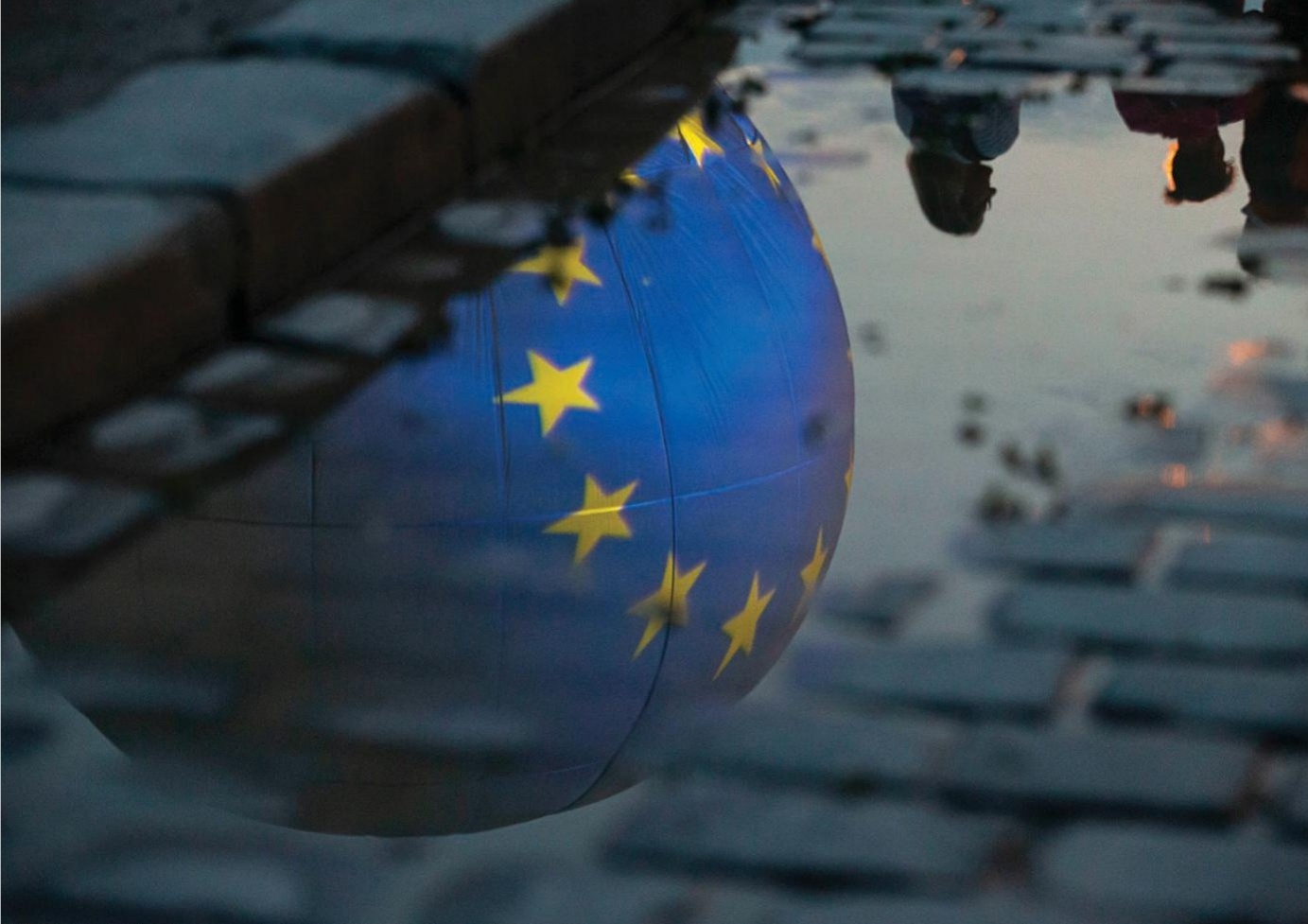
The European Union flag is projected on a helium balloon in Prague on June 25 to mark the beginning of the Czech E.U. presidency
ABOVE THE ANXIETIES of the present moment, new vistas are opening up. A political union in Europe was never going to be built on economic foundations. Europe will come together as a geopolitical union or not come together at all. And now for the first time, geopolitics is taking over. Already in the decision to grant Moldova and Ukraine candidate status, a quantum leap took place. No one spent much time discussing whether Ukraine enjoys the economic conditions necessary to join the E.U. Under the circumstances it would have been a ludicrous consideration. Instead, we assumed that those conditions can be created in the future, provided Europe is able to ensure its own security.
Relations between Brussels and Poland have improved. There are issues to solve, but both sides agree on the fundamental question of what our enemies are. With Hungary, there is no such agreement, and in fact the Hungarian government is now entirely isolated in Europe, seen by almost everyone as a Kremlin stooge. The war has taught us to focus on the essentials.
The most difficult problem still to be solved is how to create in Brussels a common power that can be genuinely independent from French and German interests. The lack of such a power was responsible for Brexit, with Britain having concluded that inside the E.U. it would remain dependent on its old European rivals in Paris and Berlin.
In the longer term, enlargement should be able to take us there. With Ukraine as a member, the simple combination of Polish and Ukrainian votes will exceed the German share. Have no illusions that this is the reason both France and Germany are looking for a solution to postpone Ukrainian membership.
In the shorter term, we need new alliances between the South, Scandinavia, and Central Europe. But the balance of power is already shifting. You could see that in the recent proposal by the European Commission for an emergency power to declare a general Union alert and mandate that every member state shall reduce its national gas consumption. Germany not only accepted that this will become a European competence—under threat from a sudden energy collapse, it requested it. German vulnerability is a ray of hope for a future political union.
Maçães, formerly Portugal’s Secretary of State for European Affairs, is the author of Geopolitics for the End Time
E.U.: GABRIEL KUCHTA—GETTY IMAGES
THE VIEW
THE RISK REPORT BY IAN BREMMER
A fragile Israel-Gaza truce holds, for now

AN AUG. 7 EGYP-tian-brokered truce-in Gaza between Israel and the militant group Palestinian Islamic Jihad (PIJ) appears to be largely holding, pausing another round of violence that began days earlier and has killed dozens of Palestinians and sent rockets flying from Gaza to within three miles of Jerusalem. (However, Israeli forces killed at least three Palestinians in a shoot-out on Aug. 9 during a raid against militants in the occupied West Bank.) Unfortunately, this latest deadly showdown between Israel and PIJ is likely a precursor of more conflict to come.
It’s never easy to pinpoint exactly when and why a flare-up in fighting between Israel and Palestinians begins. Before this month’s violence, at least 53 Palestinians were killed from March to July, including Palestinian American Al Jazeera journalist Shireen Abu Akleh. During the same period, a spate of attacks by Palestinians killed at least 19 people in Israel.
IN RECENT WEEKS, Israeli officials had begun to fear that PIJ was preparing for more violence in the West Bank. On Aug. 1, Israeli police arrested Bassem al-Saadi, PIJ’s leader in the West Bank, in the city of Jenin, home to two of the attackers who had killed Israelis. The militant group immediately began issuing threats. This was not al-Saadi’s first arrest, but tensions spiked further when a video was released showing the force used to subdue him and an Israeli police dog biting him.
Then, on Aug. 5, Israel launched strikes into Gaza that killed a senior PIJ commander. The militant group responded by firing dozens of rockets into Israeli territory. On Aug. 6, Israel launched more airstrikes into Gaza, and PIJ sharply increased the number of rockets it fired, though there have been no Israeli deaths or injuries reported so far. The violence continued into Aug. 7, with the Palestinian death toll reaching at least 46, including 16 children and four women. Gaza’s Health Ministry says more than 360 Palestinians were also wounded.
Israeli officials say their strikes killed several senior PIJ members and destroyed both weapon-storages sites and tunnels. The cease-fire followed news that hospitals in Gaza were overwhelmed and could not handle a continuing surge of wounded people.
For its part, Hamas, which has governed Gaza since winning Palestinian legislative elections in 2006, remained largely on the sidelines as Israel made clear its strikes would be targeted at the smaller, more radical PIJ. But given the death toll, it’s far from easy for Hamas to remain above the fray. And PIJ has incentive to create conflicts that increase its popularity with Palestinians in both Gaza and the West Bank.

Israeli airstrikes on densely populated Gaza City on Aug. 6
ADDING TO THE INCENTIVE for escalation, Israel is heading for another election in November. Caretaker Prime Minister Yair Lapid has good political reason to take as uncompromising a line as possible. He lacks the military expertise that many Israelis expect of their leaders, and is due to face off against former Prime Minister Benjamin Netanyahu.
Finally, there’s the Iran angle.
PIJ has close ties with Iran, and it’s possible that Iran’s government will again encourage the PalestinianP militant group to createm more trouble for Israel to improve Iran’s bargaining power as diplomats in Vienna continue to try toV hash out a return to the 2015 Iran nuclear deal. Before the cease-fire, PIJ’s secretary-general issued threats of attack against Israel during a visit to Tehran. On that trip, he met with both Iran’s President Ebrahim Raisi and a senior adviser to Supreme Leader Ali Khamenei. It was just 15 months ago that a burst of Israeli-Palestinian attacksP and counterattacks killed hundreds and wounded thousands, most of them Palestinian. Since Israeli forces withdrew from Gaza 17 years ago this month, there have been military clashes in 2008, 2012, 2014, and 2021. All the conditions that spark these wildfires remain in place, not least the crippling, 15-year-long Israeli-led blockade. Even if thel current cease-fire remains in force, the risk remains that the next war will be even more destructive.
GAZA: ANAS BABA—AFP/GETTY IMAGES
THE VIEW INBOX
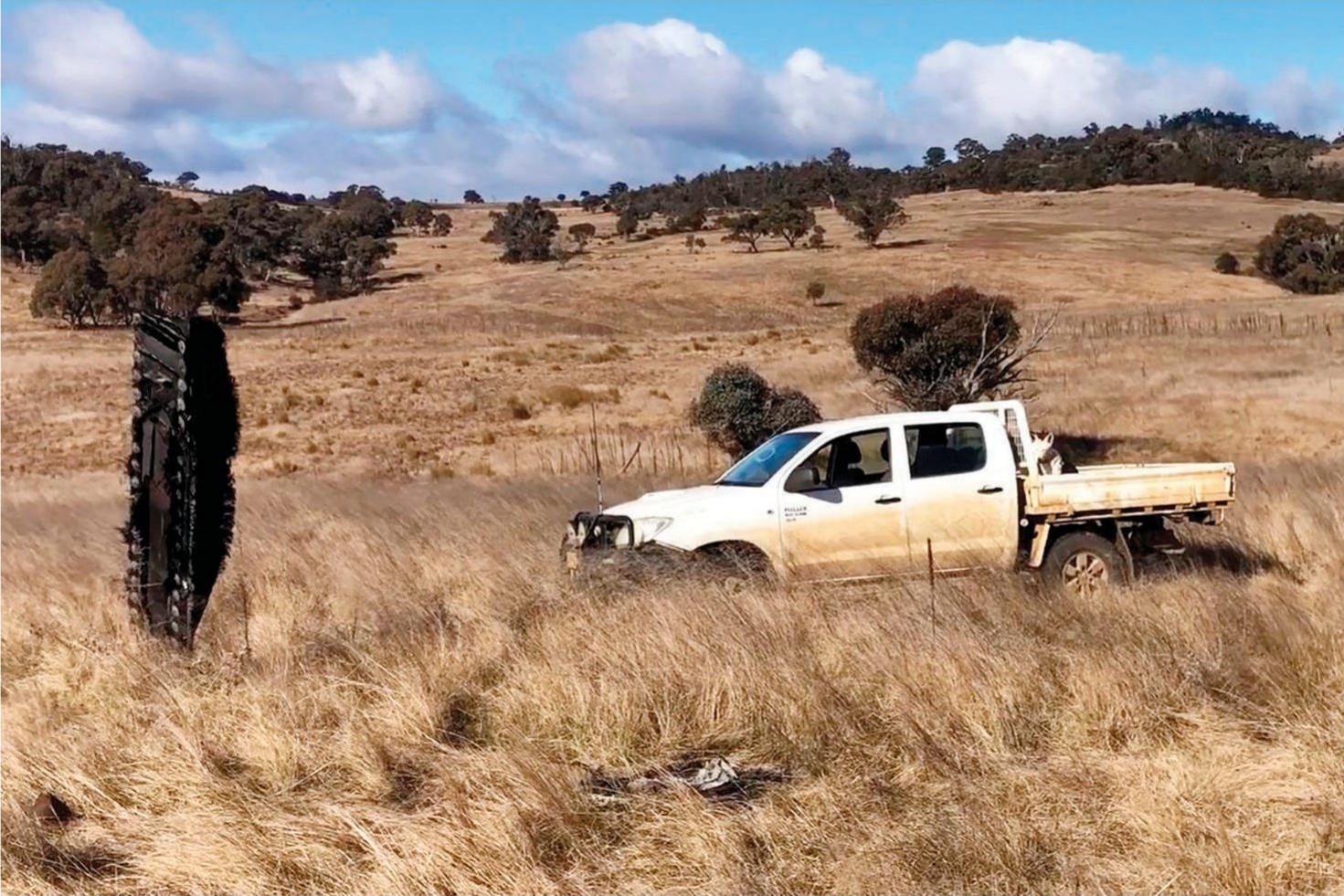
A jettisoned piece of a SpaceX vehicle, left, landed on an Australian farm
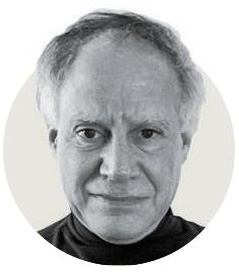
Space TIME
By Jeffrey Kluger
EDITOR AT LARGE
HISTORY REMEMBERS OCT. 4, 1957, a lot better than it remembers Jan. 4, 1958—although in recent weeks, the second date is coming to loom larger than the first. Oct. 4, 1957, was the day the Soviet Union launched Sputnik—the world’s first satellite—an achievement that heralded the start of the space age. RUSS SATELLITE CIRCLING EARTH, shouted the Los Angeles Times in a banner headline. REDS FIRE ‘MOON’ INTO SKY, yelped the Chicago Daily Tribune.
There was no such hyperventilating, however, three months later to the day, when the little 184 lb., beach-ball-size satellite, having slowly lost altitude over the months because of atmospheric drag, fell from the sky, burning up like a small meteor in the fiery heat of re-entry. With that, the world’s first satellite became the world’s first piece of plummeting space debris. It would by no means be the last.
Ever since then, a massive belt of cosmic junk has been accumulating around Earth—posing a collision risk to spacecraft, and menacing the 7.7 billion of us on the planet below.
On July 30, the 25-ton core stage of a Chinese Long March 5B rocket fell uncontrollably from the sky. Up to 40% of the booster survived re-entry; debris rained down on Borneo. “No casualties or property damage reported, but debris is near villages and a few hundred metres either way could have been a different story,” tweeted astrophysicist Jonathan McDowell, of the Harvard-Smithsonian Center for Astrophysics. The incident was especially troubling because most national space programs and private-sector aerospace companies design their rockets to have enough maneuvering fuel left aboard to land at planned spots in the ocean or on vast stretches of unpopulated steppe or desert. The Long March 5B has no such guidance system.
A massive belt of cosmic debris orbiting Earth poses a growing danger
But it’s not only China that’s been a menace recently. Last month, a 10-ft.-tall, monolith-like piece of debris landed on an Australian farm. Thanks to a serial number on one of the panels, it has been identified as belonging to SpaceX.
NASA said SpaceX confirmed the object was likely part of a Dragon spacecraft—a segment of the vehicle known as the trunk that was jettisoned when the Dragon returned to Earth last May, carrying a crew from the International Space Station. Typically, the trunk burns up entirely in the atmosphere, reported the Federal Aviation Administration in a statement, but in this case a dangerously large piece of it survived. NASA had little to say about the SpaceX incident, with administrator Bill Nelson reserving his fire for China instead: “All spacefaring nations should follow established best practices, and do their part to share this type of information in advance.” In the genteel parlance of diplomat-speak, that counts as a dressing-down.
But finger-wagging won’t solve anything. With private and public launches increasing, space debris will only get worse. The Atlantic Council think tank has called for an international framework for orbital traffic management—reporting and sharing information on launches and re-entries, and developing ways to collect and clear some of the junk from orbit. “Achieving security, economic, and societal objectives in the 21st century hinges on free and open access to outer space,” the authors of the council’s report wrote. “Now is the time to act and protect a future of security and prosperity in space.”
For the latest out-of-this-world news, sign up for TIME’s space newsletter at time.com/space-newsletter
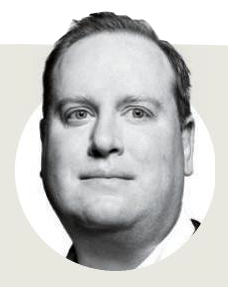
The D.C. Brief
By Philip Elliott
WASHINGTON CORRESPONDENT
LAS VEGAS—Senator Catherine Cortez Masto stood by the kitchen doors of a Latino-owned restaurant about five miles east of the neon-soaked Las Vegas Strip. The Senator strode in, seemingly knowing most of the crowd, who called her “Catherine” to her face and “La Senadora” to everyone else.
“Latinos, it’s what we do. We open businesses,” said Nevada’s first female Senator, the only Latina ever elected to the Senate. “We’re part of the community. We’re entrepreneurs.”
The whole pitch on Latino solidarity took less than two minutes, but it was better than anything she could have scripted in an ad. After all, as the signs taped to the support columns pointed out, the woman who took the time to visit with them that day was “Una de las Nuestras.” One of Ours.
The matchup against Republican Adam Laxalt is seen as a 2-point race, or maybe even closer than that—and one that could decide if the Democrats hold their narrow majority in the Senate. If Democrats end up on the receiving end of a national drubbing this fall but Cortez Masto somehow survives, the Hispanic vote will have played a pivotal role. Strategists anticipate 15% to 20% of the Nevada electorate identify as Hispanic or Latino. Yet, according to polling conducted in July by Emerson College, a solid one-third of them are backing Laxalt, a former state attorney general. For context: that’s about the same support Donald Trump enjoyed in 2020, when he came within 2 points of winning Nevada battling headwinds now blasting in Democrats’ faces.
For more from Washington, sign up for TIME’s politics newsletter at time.com/theDCbrief
BRAD TUCKER—AFP/GETTY IMAGES
THE VIEW Q & A
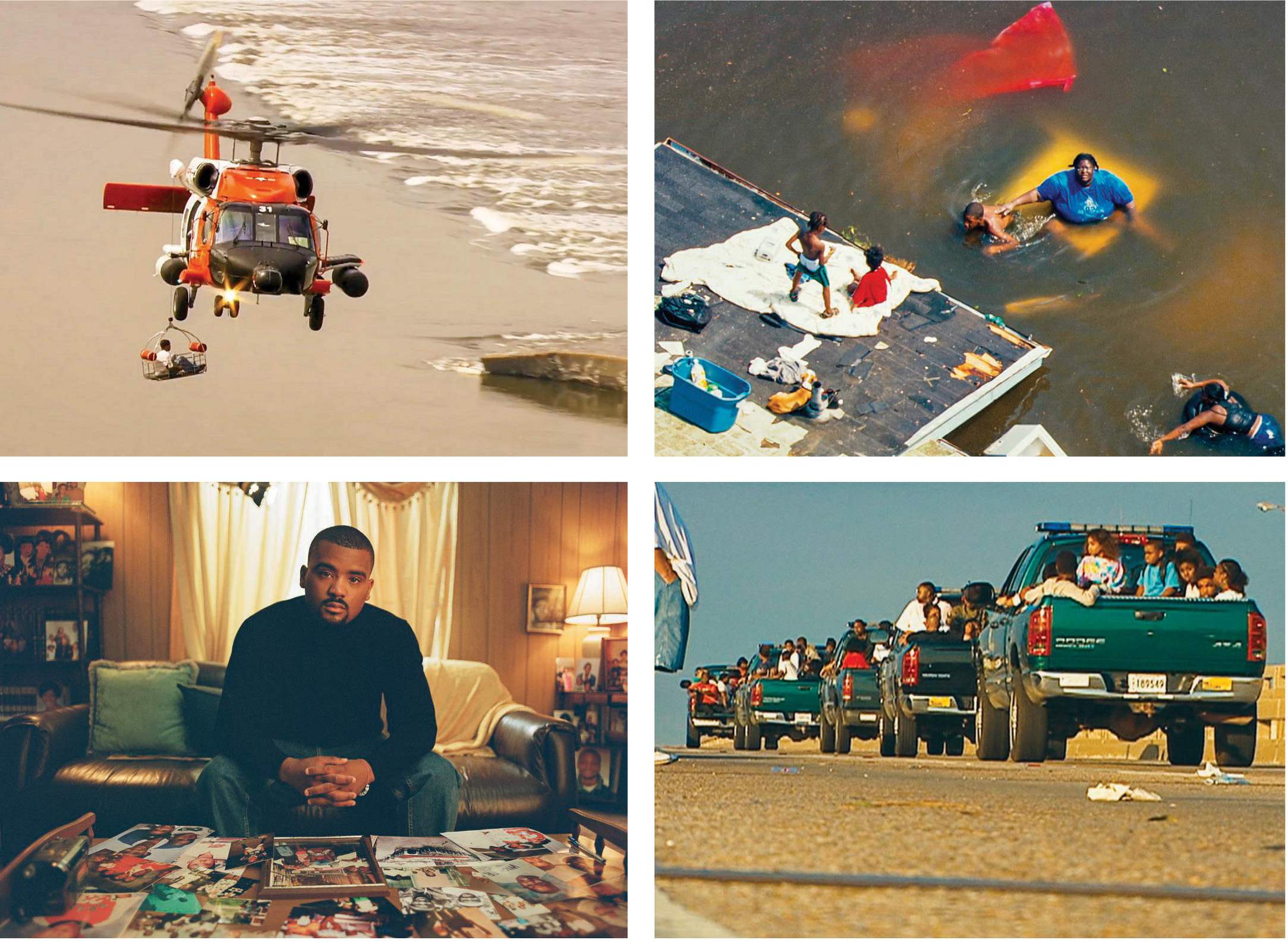
Edward Buckles Jr. and scenes of the aftermath of the 2005 hurricane from his film, Katrina Babies
The director of Katrina Babies with Soledad O’Brien on the story of New Orleans
EDWARD BUCKLES JR. WAS 12 WHEN Hurricane Katrina hit New Orleans. His family fled the city just in time, but the storm changed him forever. After years spent as an educator and filmmaker, Buckles decided to make a film about the children—including himself—who were affected by the storm. Katrina Babies (produced by TIME Studios) is an intimate documentary about life and loss that focuses on those who were 3 to 19 years old when the storm struck. Through moving firsthand accounts, including interviews with his cousins and parents, Buckles wants his film to “change the narrative and own the narrative of what’s happening with young New Orleans.”
In a conversation with journalist Soledad O’Brien, who covered the aftermath of Katrina extensively for CNN, Buckles discussed his film and his hope for the future.
SOLEDAD O’BRIEN What was the story that you wanted to tell?
EDWARD BUCKLES JR. I got this idea when I was 20 and studying documentary at Dillard [University]. I’m watching all of these films, and I’m really being inspired. And then I’m like, What’s a documentary that I would tell about my life? And nothing came to me for a very long time. One day my cousin Tina called me. And she was just crying, because she was still displaced during the holidays. That’s when it finally hit me. And I was like, Yo, I want to tell a story about what the children went through during the storm. Because on that call, she told me what all of my cousins had been through. I grew up in post-Katrina New Orleans, and I was exposed to everything.
O’BRIEN It seemed like it was hard for you to know the story, because you were in the story.
BUCKLES I was not prepared for the weight and the stories that came with that. So that’s why it took me seven years to make it. But it wasn’t until Year 6 that I actually inserted myself into the film. I was very resistant.
O’BRIEN Why were you resistant? It really is your story seen through other people’s experiences as well.
BUCKLES I was resistant because the only thing that I can think about is survivor’s guilt. I was fortunate enough to follow my mom’s faith, and she evacuated us at the 11th hour. Something that we do a lot in our communities—I don’t just want to say in New Orleans, but something that we do in my type of neighborhoods—is we compare trauma. We wear our trauma as armor. So, because I wasn’t actually in the water, I always said, “I don’t have trauma.” There are people being airlifted off of roofs and people who drowned and people who lost their parents, why do you need to be in this story? But then once I got older, my trauma started to surface in different ways. It just wasn’t the same as everybody else’s, but trauma is trauma. This film helped me to begin that process of finding my own trauma and healing.
O’BRIEN Was it hard to go back and look at the videos? It was hard for me to watch, having just spent so much time in New Orleans covering that story.
BUCKLES It was hard to watch that archival footage, but I learned a lot.
I was hearing a lot of crazy stuff that these different reporters and journalists were saying. It really allowed me to grow a whole different respect for people like yourself who are doing it the right way, who are doing it with love and empathy, and really trying to give voice to the voiceless. But it also allowed me to see the other side as well and how our Black bodies were being spoken about.
O’BRIEN What is it like to lose your future when you’re 12 years old?
BUCKLES What does it mean to lose your identity when identity is connected to everything that has been washed away? In New Orleans we find out who we are through our neighborhoods. We find out who we are through our history, and all of that was washed away. When I became a high school teacher, it was the most interesting thing because every high schooler is on their journey. But kids in New Orleans really don’t know who they are, don’t know how to find who they are because they’re moving around so much, because they don’t have any baby pictures, simple things like that. They don’t know where their childhood home is. If you layer that on top of everything else that’s happening in New Orleans, it’s hard to grow up. What happened 17 years ago is still impacting children that were not born during the storm. It’s still impacting their future because of the conditions that it left.
O’BRIEN Why does it piss you off so much when someone refers to the folks who were displaced as refugees vs. evacuees?
BUCKLES It makes me mad because by definition, we are not refugees. We were being treated like refugees, but we are American, right? We are from here, right? We fight, and we would die for this place, right? I thought that calling us refugees was lazy. And don’t be lazy with how you are labeling us because words are things, right? So I just think that it’s the lack of empathy, and it’s the lack of respect for Black people and Black bodies. It’s like one of those things where I’m not mad. I’m just disappointed.
O’BRIEN Why do you think so many people who are very young babies in Katrina haven’t gotten help for what is clearly a real trauma?
BUCKLES Growing up disenfranchised and not having access and mental-health resources. I think that’s the reason that talking about our trauma is not our go-to, but using our strength and resilience is.
O’BRIEN What do you want people who watch this film to walk away with?
BUCKLES Hurricane Katrina was in 2005, and it still echoes. I believe that if we get resources and tools, we can be a great city. I just wanted to shine light on us and start healing.
Katrina Babies will premiere on Aug. 24 on HBO and stream on HBO Max
CLOCKWISE FROM TOP LEFT: COURTESY HBO; COURTESY GETTY IMAGES/HBO; COURTESY CNN/HBO; COURTESY HBO
WORLD
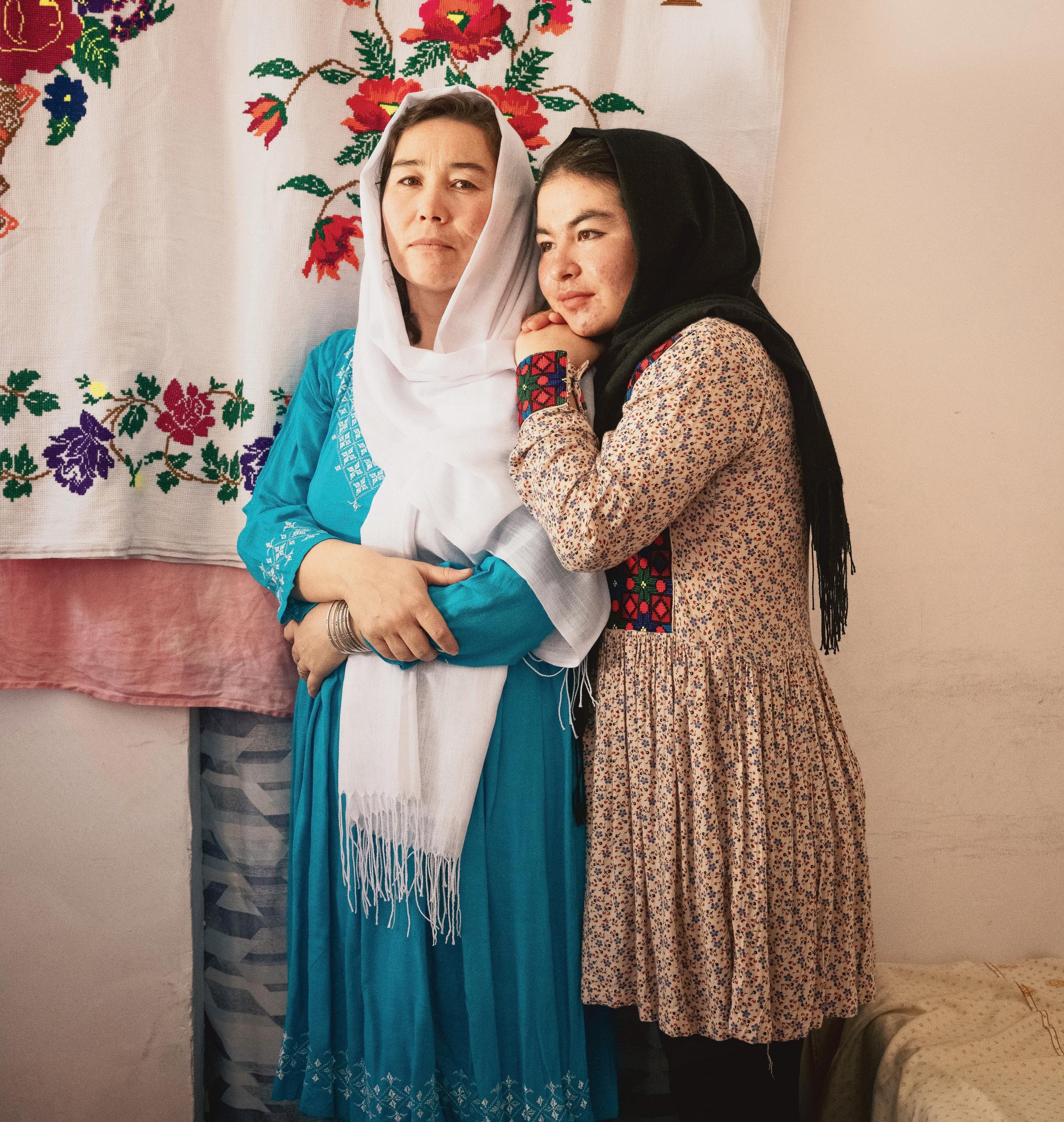
Najiba Ebrahimi, a biology teacher, and her daughter Azada now live in São Paulo
FAR FROM HOME
ONE YEAR AFTER THE FALL OF KABUL, AFGHAN WOMEN ARE TRYING TO BUILD NEW LIVES ABROAD
When the Taliban walked into the capital of Afghanistan on Aug. 15, 2021, America’s longest war came to an end. The vacuum left by the exit of U.S. troops forced tens of thousands of Afghans to flee. Some were evacuated by Western nations. Others escaped on foot. For many Afghan women, the Taliban takeover spelled the end of the freedoms they had enjoyed for two decades.
One year on, thousands of women are scattered across the world. For this project, a global team of female journalists and photographers spent time with eight individuals who are building new lives, from the beaches of Florida to the suburbs of Dublin.
Starting anew has not been easy. They ache for their homeland and their loved ones, unsure when they will see them again beyond their cell-phone screens. At night, they often return to Afghanistan in their dreams. They are wrestling with new identities, spending their days learning new languages and exchanging their Afghan air force uniforms for restaurant aprons.
OVER THE PAST 20 years, U.S. officials often defended the war as an effort to improve the lives of Afghan women and girls. There were real successes: around half of Afghan girls—some 4 million children—entered elementary school, compared with almost none two decades earlier; women filled university hallways, joined the medical profession, traveled freely across the country, and entered nearly every aspect of public life, becoming lawmakers, judges, governors, and police officers. An all-female robotics team garnered global fame. Afghan female athletes became Olympians.
In a country where nearly two-thirds of the population is under 25 years old, members of Afghanistan’s young generation particularly flourished during the U.S. and NATO’s war against the Taliban, which had ruled the country in the late 1990s before being ousted by U.S.-backed Afghan forces in 2001. The international community encouraged women to chase their dreams, be emboldened by the end of the repressive rule many of those same women had known as children.
When the final U.S. troops withdrew in a chaotic exit last summer, Afghan women saw their hard-won gains evaporate overnight. Despite promising to honor women’s rights “within Islam,” the Taliban has intensified its crackdowns—just as Afghan activists had long warned.
The Taliban has banned high school for girls, placed restrictions on women working and traveling abroad, and ordered that women stay at home—and that, if they must go out, they cover their entire body and face except for their eyes. The regime has closed almost all shelters for women fleeing violence, and domestic violence is now sharply on the rise. It disbanded the ministry for women’s affairs and suppressed women’s demonstrations. The number of child marriages is surging, and women are increasingly committing suicide.
The Afghan women who managed to get out are the lucky ones, but they feel betrayed by a world that promised to stand by them. They mourn the loss of freedoms that reverberates across their nation and several generations. These are women who once were full of optimism about the future of their country. They joined Afghanistan’s security forces, or became educators, artists, and activists. Now they are free and safe. But they are also far from the homes they love, and the futures they deserve.
—AMIE FERRISROTMAN and ZAHRA JOYA
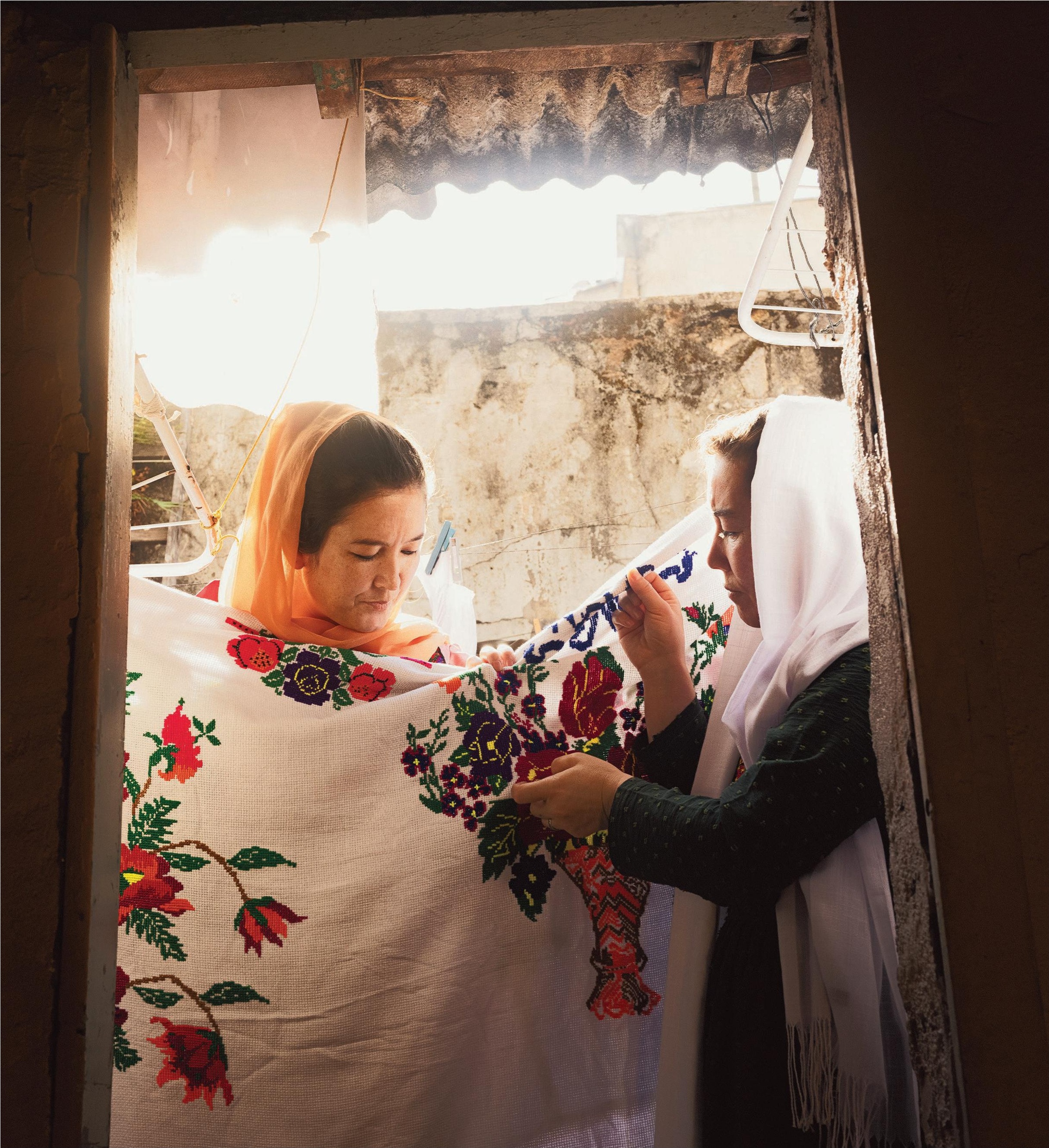
NAJIBA EBRAHIMI
São Paulo
BY JILL LANGLOIS
NAJIBA EBRAHIMI LIVES in Freedom. It’s the São Paulo neighborhood where the 33-year-old has settled and what she feels she’s finally attained after escaping the Taliban. A champion for the rights of women and girls in the minority Hazara community, Ebrahimi taught biology at a girls’ school in Afghanistan’s southeastern Ghazni province and shared her love of sports with her students. That turned her into a target when the extremist group made its return.
In late August, she began receiving phone calls from various men using different numbers. “They said, ‘You shouldn’t be alive. If you stay here, you’ll die,’” Ebrahimi says.
So she fled. Her parents had left Afghanistan years earlier for Brazil because of ethnic persecution. She crossed the mountains of Pakistan with her teenage daughter, brother, and cousin, the women under the cover of burqas. Her parents got to work on getting them visas.
Now Ebrahimi works in São Paulo with her family at their Afghan restaurant, Koh-I-Baba, named for the mountains of her ethnic Hazara homeland. It’s a new start and also a return to what she loves most: life with her family and the freedom to be herself.
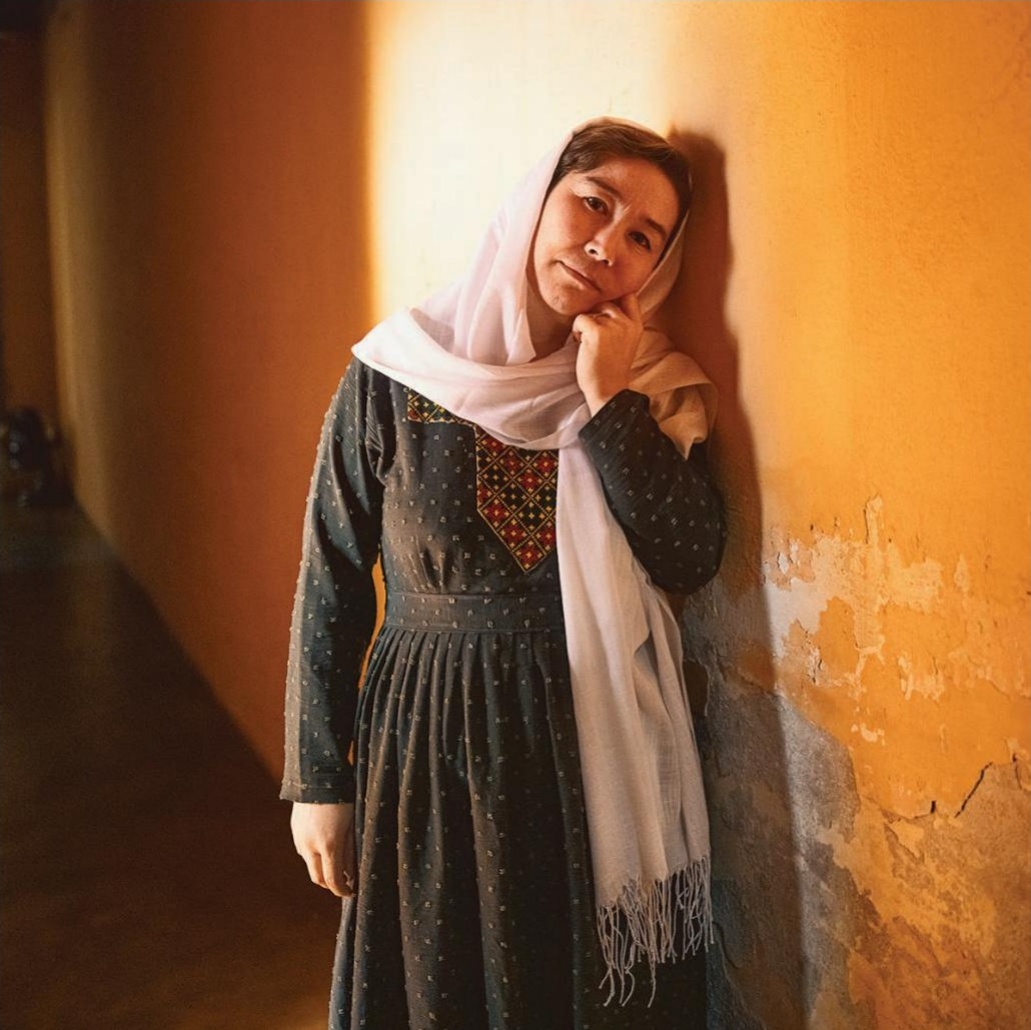

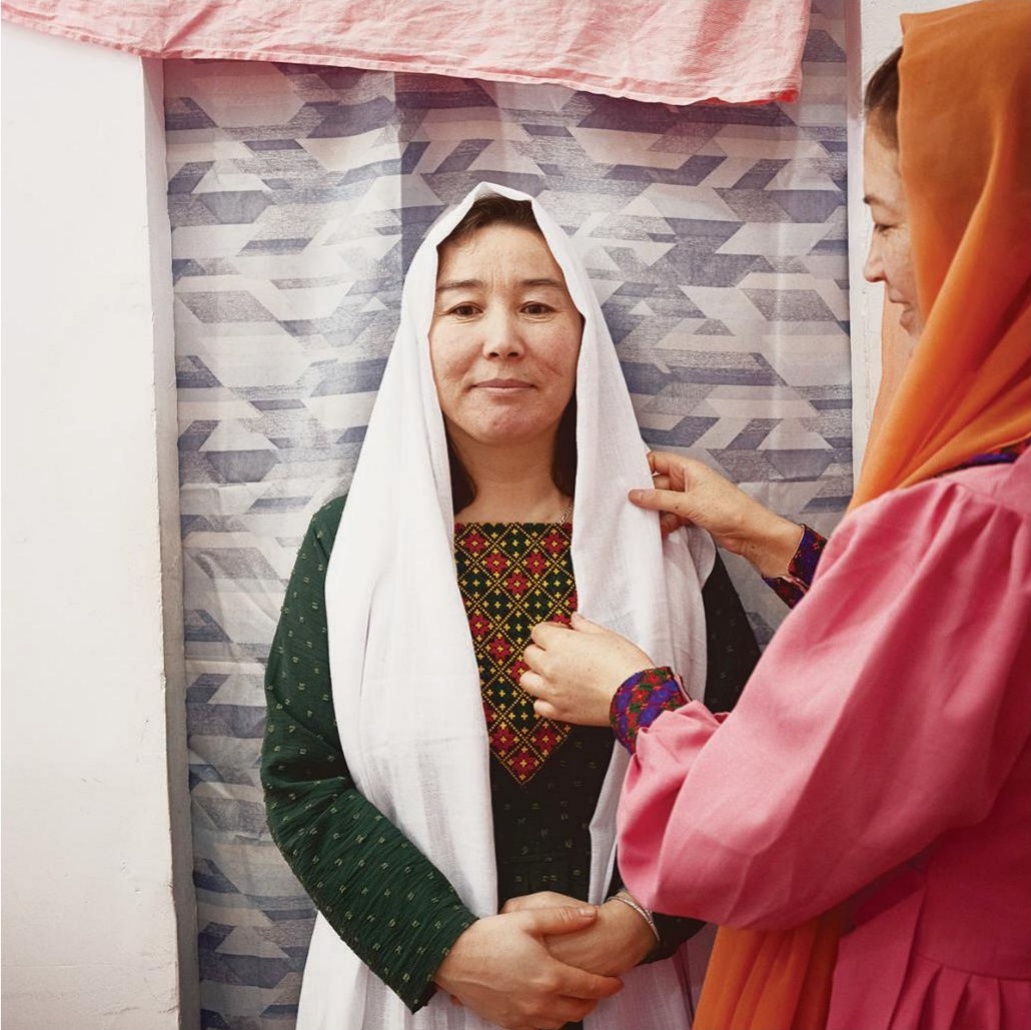

Clockwise from top left: Ebrahimi at the apartment she shares with five relatives; her recent embroidery work; with her cousin, who also fled Afghanistan; the family in front of their restaurant in Brazil
What do you miss most about Afghanistan? My students. I was the first teacher to get them involved in sports. I bought the school’s first volleyball, and we set up tournaments. I even helped train some of the girls who wanted to go to the Olympics.
What has surprised you about your new home? Women here have freedom. They can wear what they want, do what they want. They don’t have to be afraid. Here I can walk down the street, around my neighborhood, and it’s safe.
What new foods do you eat now? Food here has a lot of pork and cheese, so it’s hard to find new things I like. But I do like fries.
What is your most treasured possession? I wasn’t able to bring much with me when I left, but I brought a tapestry I embroidered, which is two meters long. It took me a year to finish it. My mother taught me how to embroider. It’s something that’s passed down through all the women in our families.
What word do you associate with the Taliban? Fascism.
Choose one word to describe yourself. Free. That’s how I am here. I can’t go back to Afghanistan. There’s no life there for women.
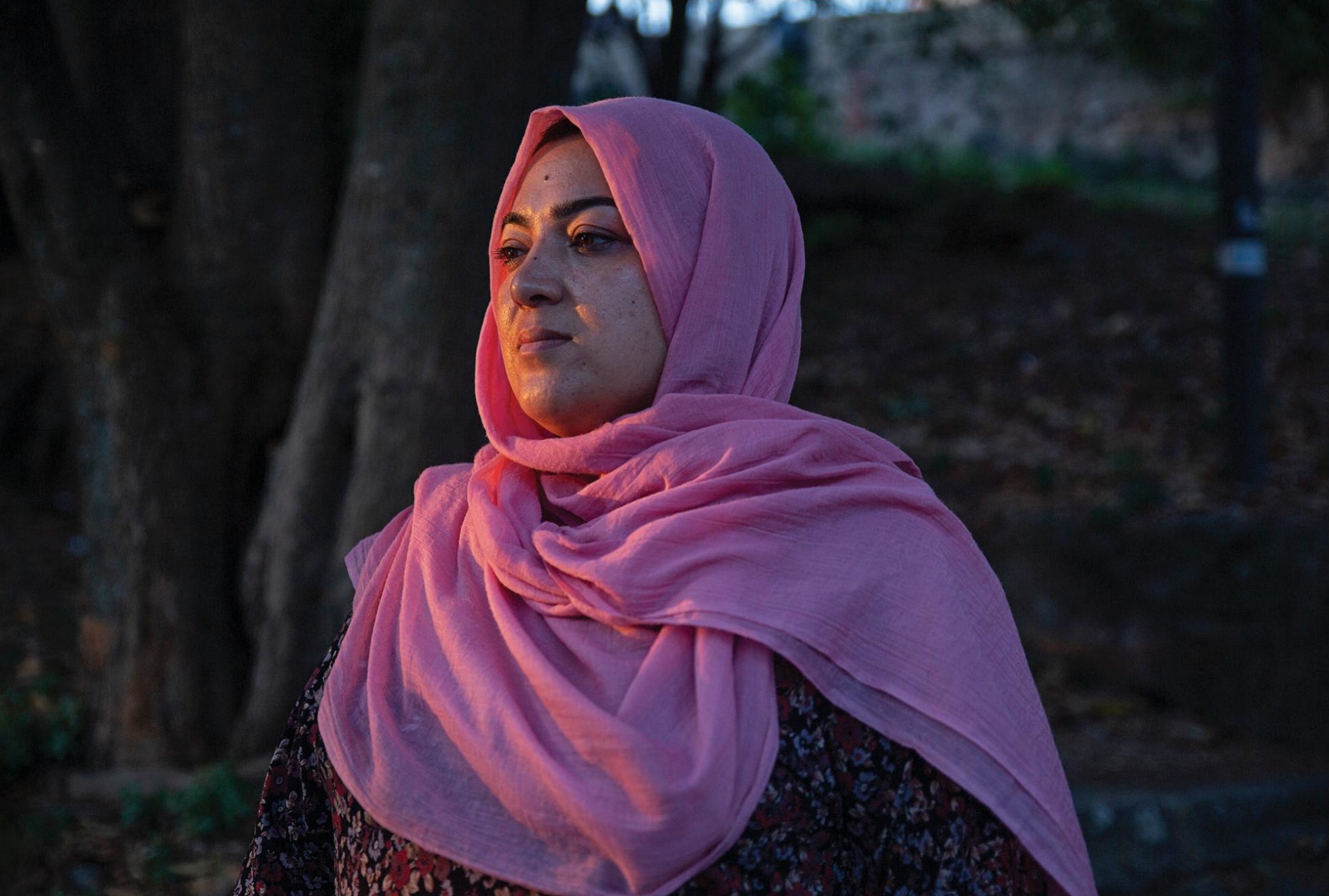
From Italy, Haidari is trying to help others escape the Taliban
BATOOL HAIDARI
Rome
BY CORINNE REDFERN
IN THE DAYS following the fall of Kabul, Batool Haidari found herself forced to make an agonizing decision. Haidari, a 36-year-old psychologist and sex therapist working with women and the LGBTQI community, had safely escaped to Iran, where her children were already hiding, but her Ph.D. research remained in Kandahar, which had been under Taliban control since Aug. 12. Haidari’s thesis was her proudest achievement—the product of years of study. She decided to travel back to collect it.
But by the time she got it, Iran had closed its land borders. Trapped in Afghanistan, Batool began to organize protests in Kabul against a regime more violent than she’d imagined. Eventually, she managed to flee again, this time to Pakistan. From there, an Italian journalist helped her family fly to Italy, where they claimed asylum.
From Rome, Haidari works to find escape routes for others at risk and provides phone therapy to those experiencing depression. During rare moments of quiet, she opens her folders of research. For as long as the Taliban oppresses her people, her work feels more important than rest.
What do you miss most about Afghanistan? In Kabul, there is a very crowded area where the streets are always full of people selling fruit and vegetables. I miss the sound of them shouting their prices into the air, a hundred times over. They are the sounds of my home.
What has surprised you about your new home? I was born into a very religious family, in a very religious society. But I never imagined that Italy would be so religious too. There are churches everywhere!
What do you do to relax? As long as there are women activists trapped in Afghanistan, I cannot relax. At the moment, I spend all my time listening to their problems. When they are free, I will also need to see a psychologist. We will have to empty our minds by talking, dancing, listening to music, laughing . . . By doing all this, you can find yourself again.
What is the most important thing you brought with you? My daughters. They are the new generation of Afghanistan. They are powerful girls, and they carry all of my hopes for the future.
Choose one word to describe yourself. I am a warrior. We are all warriors. Not because we are at war, but because we are fighting to survive. Even now, after leaving Afghanistan under such difficult conditions, we are still fighting to live our lives.
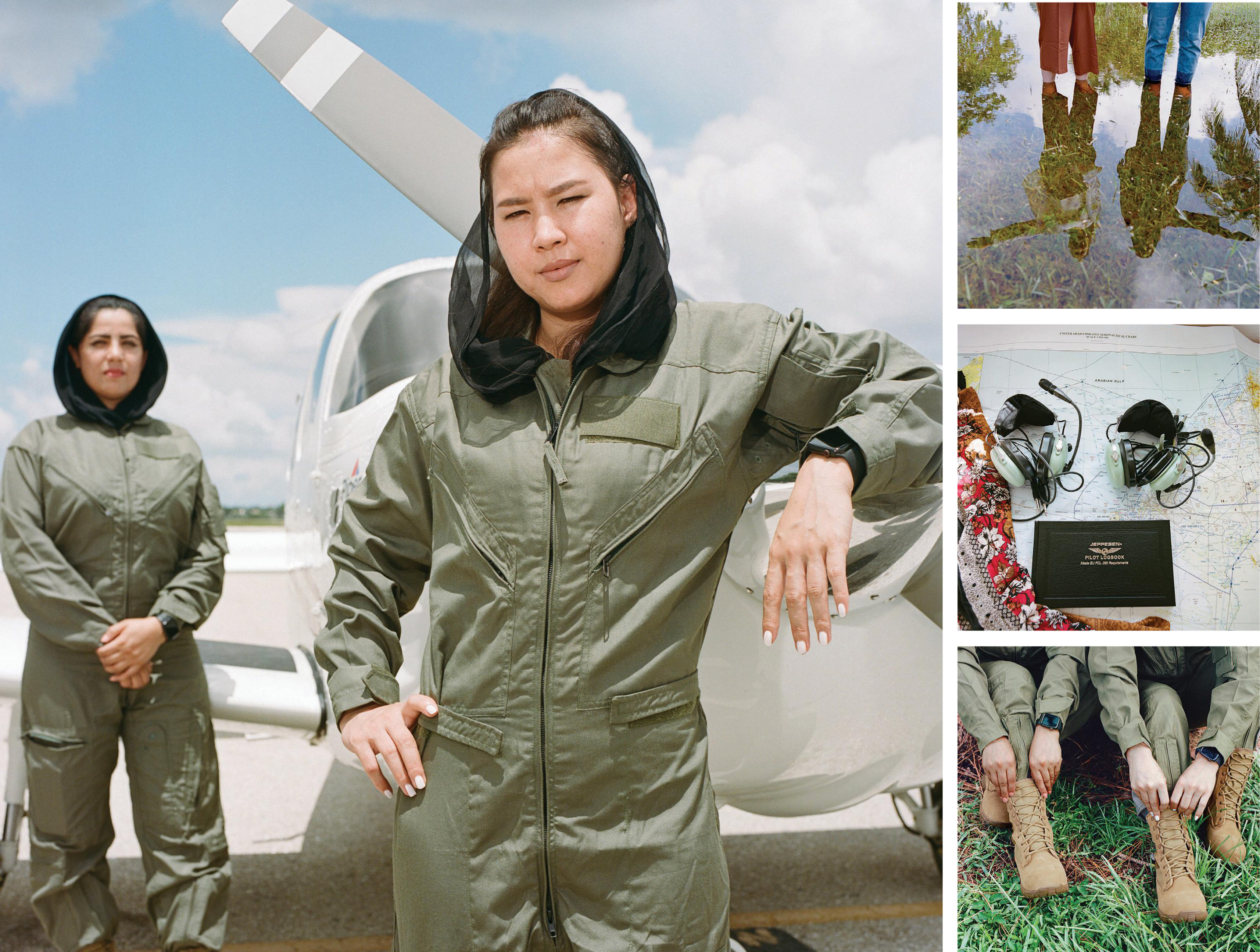
Clockwise from left: Wearing their old uniforms while visiting the Paragon pilot training school; after the rain in Fort Myers; headsets and a pilot logbook; Najibi and Rahimi sit in front of their favorite tree
HASINA NAJIBI AND RAIHANA RAHIMI
Fort Myers, Fla.
BY FARAHNAZ FOROTAN
AFGHAN AIR FORCE pilots Hasina Najibi and Raihana Rahimi met last year when they attended an aviation training in Dubai. The two women, who are both 25, immediately clicked and became close friends.
They shared a passion for flying, and both had to fight to earn that right. Najibi, an ethnic Pashtun, would go to work disguised in large sunglasses, worried her relatives and neighbors would discover she was a pilot. Rahimi often faced discrimination in the armed forces for belonging to the Hazara community.
They were preparing to return from Dubai when the Taliban captured Kabul. Worried that the Taliban would take revenge on their families if they were discovered, they told their families to burn the uniforms they’d left at home, as well as their pilot IDs and diplomas. Najibi watched on a video call as her mother set her uniform alight. “All my dreams were on fire,” she says, “and I was just watching.”
Now, living together in the heat of southern Florida, the women wait tables in a strip mall. In the evenings, they put a rug under the tree near their apartment. They drink green tea and talk about their lives back in Afghanistan—and their biggest dream: to return to the skies.
What has surprised you about where you live now?
Najibi: The streets, the people, the food, even the trees—nothing is familiar here.
Rahimi: How far we are from home. In the early days, Hasina and I would look at a map of the world from time to time. We’d look at America, and then Afghanistan, and we’d get a scary feeling of being so far from our home.
When you think of Afghanistan’s future, what comes to mind?
Rahimi: I think about Afghan women, and how they should not be forgotten. They lost everything they had. Their lives, their rights, and their dreams are now being held hostage. Sometimes I feel this situation is not going to last. I think one day Afghanistan will be liberated and we will return to our country. How can a regime that ignores half of society survive?
What’s the most important thing you have with you?
Najibi: I have my air force badge, which is very special to me. The day we flew from Dubai to America, they told us we could only take one suitcase with us. I packed a set of air force uniforms and my flight booklet and a few other things from my time in the military. Once, when I felt homesick, I opened my suitcase. Seeing my uniform gave me the hope that I might be able to study again here and become a pilot. Every time I get tired, I think about that uniform, and I feel like I can handle anything.
Where do you see yourself one year from now?
Najibi: All I dream of is returning to my studies. I hope by this time next year, I’ll be closer to my goal.
Rahimi: I lost my life, but I won’t lose my hope. I am determined to find a way back into my profession. This is the dream that keeps me alive. Even though I sometimes feel exhausted, I tell myself I’ll find a way. Back in Afghanistan my family and even my teachers at times would tell me piloting is not for me. I always felt the discrimination. But I succeeded there. I am sure I can succeed again.

Masouma Tajik, photographed at the Rutgers University campus on July 7. She fled Kabul for Kyiv, and was forced to leave once more after Russia launched a full-scale invasion of Ukraine in February
MASOUMA TAJIK
New Brunswick, N.J.
BY NAINA BAJEKAL
MASOUMA TAJIK DREAMS of buying her own place. One year ago, having graduated from the American University of Afghanistan, she was working as a data analyst in Kabul. She would return each evening to the rented apartment she had decorated with fairy lights and candles, cook a meal, and watch a movie. Her favorite was Django Unchained. She felt at home.
Tajik, 23, has since spent months in limbo. “I lived in places that no human being should live,” she says. Last August, after days spent in the Kabul airport—where she was whipped by the Taliban—she was finally able to board a plane for Kyiv. There, she did freelance coding jobs, began to make friends, and applied to study abroad. As the breadwinner for her family—her degree and fluency in English have opened doors that remain closed to her parents—Tajik sent money back to Afghanistan every month.
In mid-February, worried about an impending Russian invasion, Tajik packed her backpack once more and fled to the western city of Lviv. Her journey took her to Warsaw, to a refugee camp in the Netherlands, and ultimately to the U.S.—after being accepted with a full scholarship into a two-year master’s program in data science at Rutgers University.
Since she arrived on May 28, she has tried to adjust to yet another new home, this time a shared dorm. She is going to therapy, jogging, and cooking, which she describes as a kind of meditation. She is aware that not many people got the chance to get out of Afghanistan, let alone to have the education she has had. And though she doesn’t know what will happen after two years, she knows she won’t let these opportunities come to nothing.

What do you miss most about Afghanistan? I miss going to the office every day. I miss the ice cream shop in Kabul. That glimpse of normalcy that I had in Kabul, I miss that.
What has surprised you about where you live now? Making friends in the West is really difficult. Afghans are really chatty, really warmhearted; even before becoming friends, they offer tea and then they start conversations. Here, I think that from a certain age or from a certain time, you cannot actually make good, permanent friends.
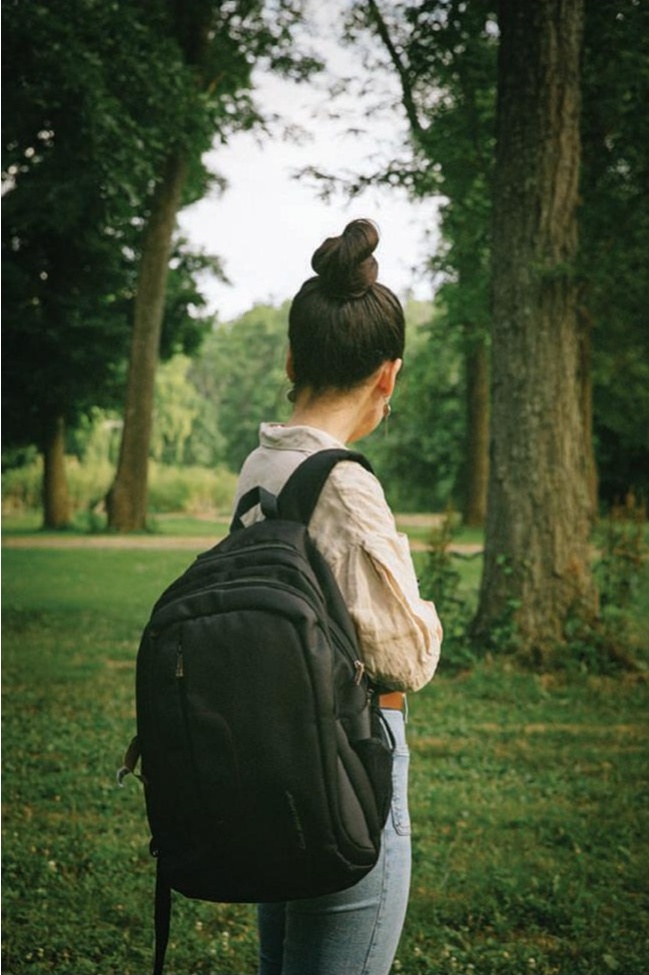
What’s the most treasured possession you have with you? I left nearly everything in Kabul, I just had a backpack with my laptop and a novel by Elif Shafak, The Forty Rules of Love. That was almost like a Koran for me, but I gifted it to a Ukrainian friend.
I left Kyiv in a hurry too for Lviv. Now my favorite possessions are the Ukrainian earrings and necklace that I bought myself on my birthday in Lviv. It was on Feb. 23, and I was celebrating alone. I didn’t know anyone, but I was having a good time because Lviv is a very beautiful city. And then the next morning I woke up to the sounds of sirens.
What do you wish for Afghanistan? Afghans are not pathetic. We are being held back by the regulations, these unnecessary, complicated processes, our lives on pause because we’re in refugee camps and cannot study or work. It shouldn’t be like this. What we need is not pity and empathy. What we need is opportunities so we can make our own way.
Choose one word to describe yourself. Unstoppable.
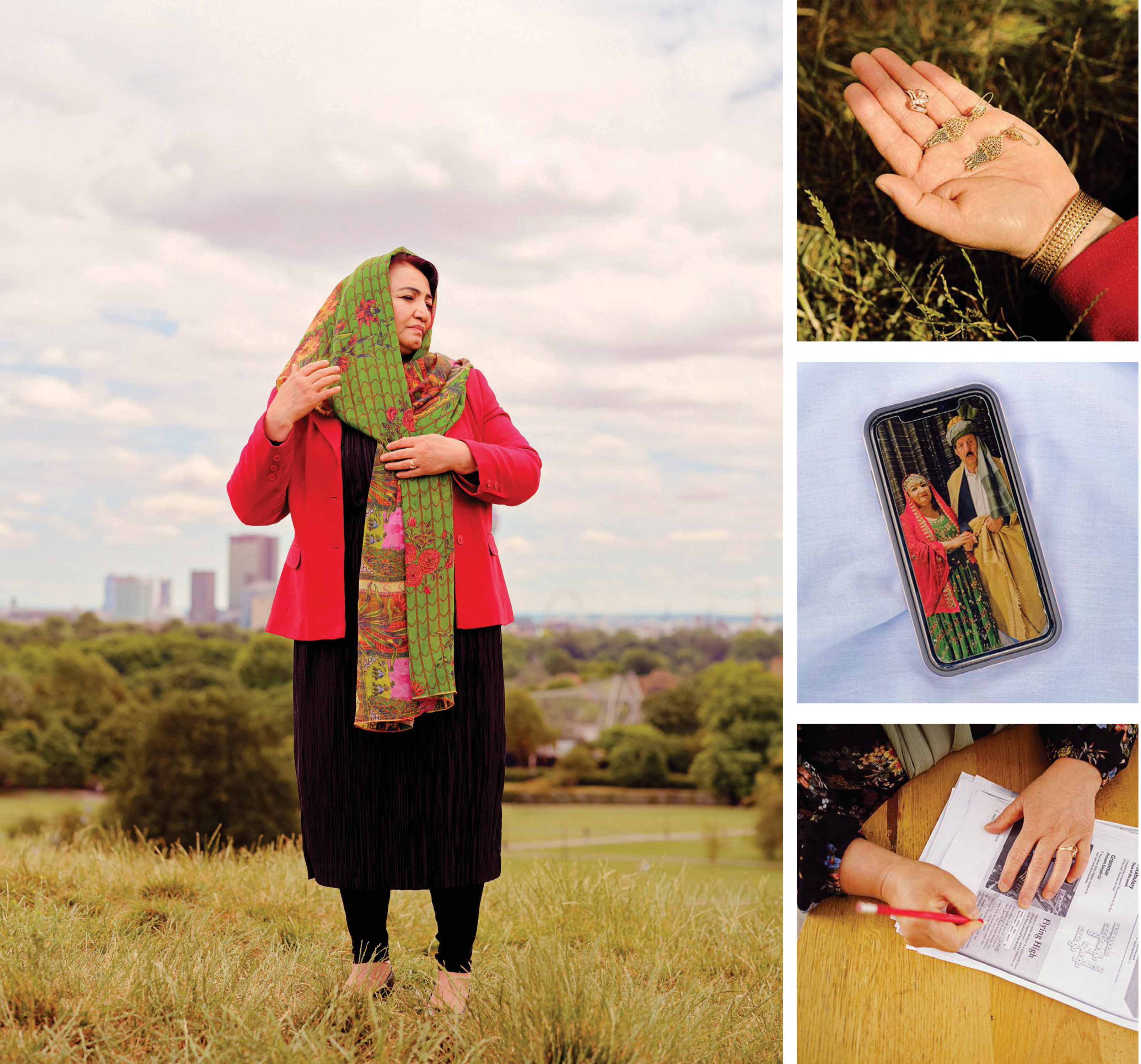
Clockwise from eft: Alizai in London’s Primrose Hill on July 2; jewelry from Alizai’s late mother; with her husband in traditional clothes; doing her English-language homework
SAHRA ALIZAI
London
BY AMIE FERRIS-ROTMAN AND ZAHRA JOYA
SAHRA ALIZAI HAS spent half of her life teaching. For 25 years, she taught more than 3,000 men and women to become schoolteachers at the prestigious Kabul Education University. Now, far from her native Kabul, in the boxy London hotel room she shares with her husband, she has become the student.
Alizai once took great delight in watching her students graduate and become teachers themselves, showing a new generation of girls how to read, write, and learn Afghan history and literature. She knows firsthand what a country can look like without education for all. During the civil war of the early 1990s, insecurity and violence pushed girls and women out of school; in the harsh Taliban rule that followed, their education was outright banned. “A country without schools for girls will simply die,” Alizai says.
Today, the education instructor often feels lost in the British capital; each night, she dreams she is back in her classroom at the whiteboard. Her salvation is learning. On weekdays, the 50-year-old takes a bus across London to Paddington, where she studies English. She hopes it will be only a matter of time before she is on the other side of the room, back to teaching others.
What has surprised you about where you live now? The government here accepts people from different backgrounds and beliefs. Everyone seems to love each other.
What do you do to relax? I do my English-language homework. It’s a way of keeping my dignity. I am also keeping a diary of my experiences. So far I’ve written over 20 pages about our journey from Afghanistan to England.
When you think of Afghanistan’s future, what comes to mind? If the Taliban continue to rule the way they do now, and deny girls’ education and women’s participation in society, Afghanistan will die.
No government has recognized the Taliban as legitimate, so the situation will remain terrible. Afghanistan has become an island.
What do you miss most about Afghanistan? I miss teaching at my university.
The university was everything for me. Every night I dream of being back in my classroom at the university, and not in this hotel room in London.
What’s the most treasured possession you have with you? My earrings and my bangles, which are a gift from my late mother. I also brought with me my cell phone, which has my memories, and my only photos of Afghanistan.
What food from home do you eat most often? Afghan vegetables, like green beans and sabzi [stewed spinach]. I do not like the food in England, especially pasta. And I will not try those small beans in a red sauce. Awful!
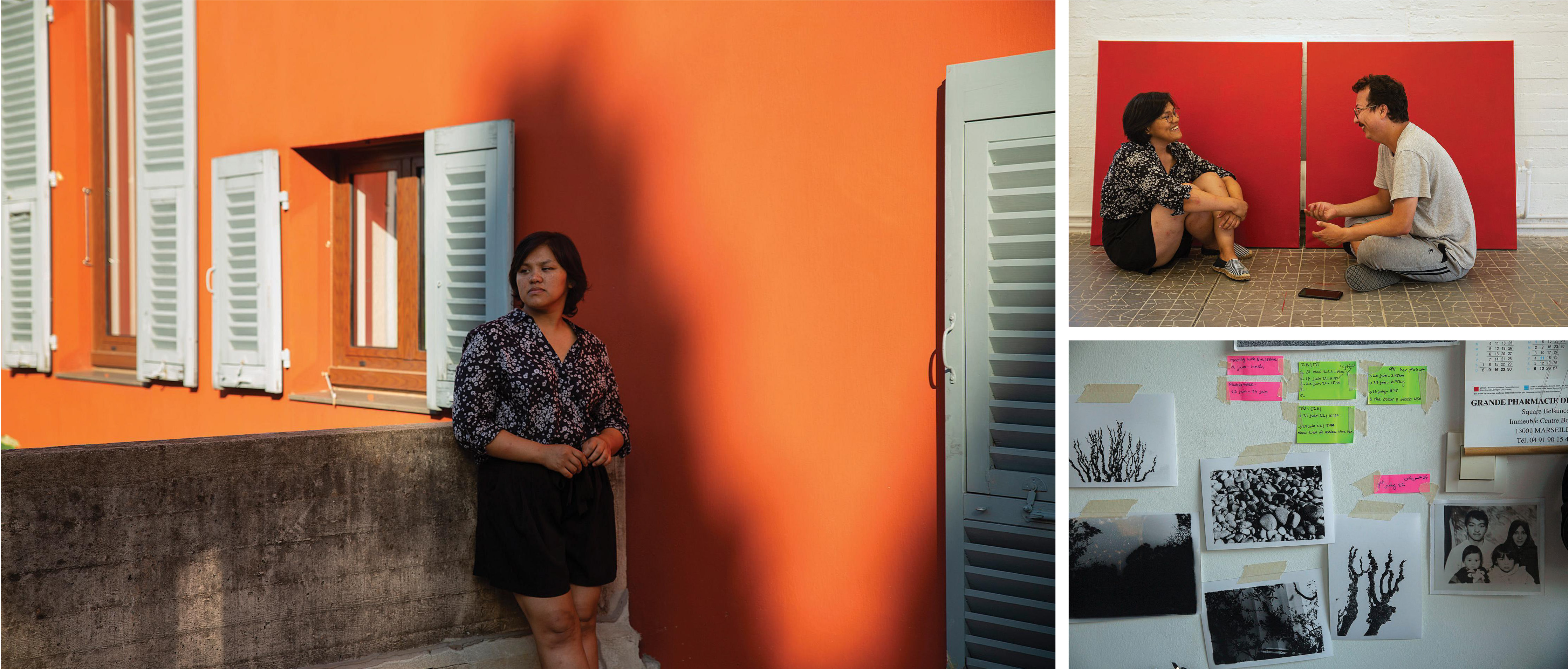
Clockwise from left: Khodadadi near her studio in Nice; with her husband Mohsin Taasha and his canvases; photos Khodadadi took on the walls of her studio
ZAHRA KHODADADI
Nice, France
BY CORINNE REDFERN
FOR MANY YEARS, Hazara artist and photographer Zahra Khodadadi, 31, fixed her lens on families in Afghanistan, exploring the ties that bind people together. Now, as fear grips her country under the Taliban, and from her new home in France, she continues to use art to document the violence that is ripping so many loved ones apart.
Leaving Afghanistan was never Khodadadi’s plan. Last summer, as the Taliban’s power surged across the country’s provinces, Khodadadi and her husband, a fellow artist and an activist, felt the danger approaching Kabul. With help from a former colleague in France, the couple secured emergency visas and arrived in Paris on Aug. 12. Three days later, Khodadadi awoke to terrified Facebook messages confirming that the Taliban had captured Kabul. Scared for her family, she worked around the clock to find her parents and four younger siblings a route out of the country. In December, they made it to Canada. Khodadadi doesn’t know when she’ll see them again: she’s had her request for asylum approved, but until she receives her residency papers, she isn’t allowed to leave.
Khodadadi and her husband now live in an art gallery in Nice, part of a project to support artists from all over the globe. On the walls of her studio, she pins photographs of burned-out cars next to news reports describing those who lost their lives. Even from thousands of miles away, she cannot close her eyes to her people’s suffering. She owes everything to all Hazara women and persecuted people in Afghanistan, she says, to make sure the rest of the world also sees their pain.
What do you miss most about Afghanistan? My parents are originally from Bamiyan. It is a very beautiful national park, just three hours’ drive from Kabul. It is so quiet. When you go there, you feel it is kind of healing. You have no fear. I miss that feeling.
When you think of Afghanistan’s future, what comes to mind? I have no hope for Afghanistan. There is no hope. Nothing.
What food from home do you eat most often? I cook bolani—it’s a kind of dough, filled with potatoes and vegetables. The difficulty is that it needs lots of time and lots of people to prepare it. I made it here once with my Ukrainian friend—it was so amazing! I rolled out the dough, and she did the filling. It was like a little production line.
Where do you see yourself one year from now? After all of these experiences, I believe that nothing is certain. I cannot plan anything in my life 100%. I try to do my best, but even short-term plans are very hard. All I know is that I would like to be somewhere peaceful.

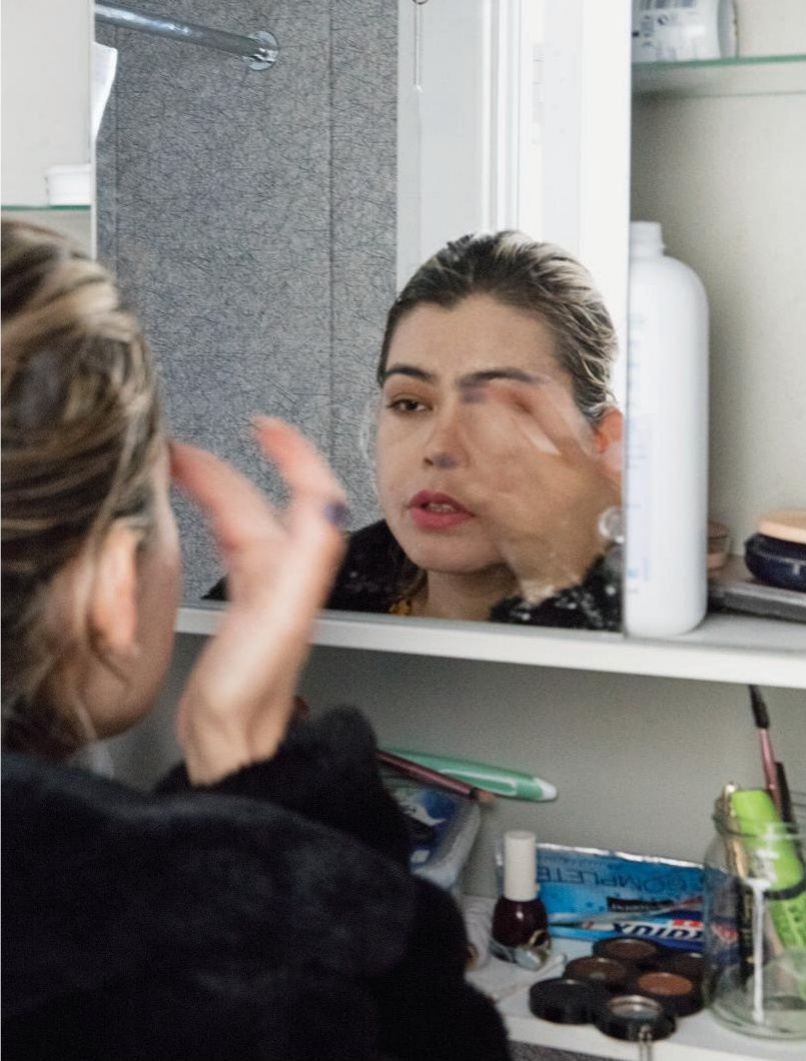

From top: Basira stands outside her home in Dublin; applying makeup in her bathroom; a poetry book Basira brought from Afghanistan
BASIRA
Dublin
BY AMIE FERRIS-ROTMAN
BASIRA, A 24-YEAR-OLD activist campaigning for the rights of the Afghan LGBTQI community, always believed the West had her back. She is too young to remember the Taliban’s previous rule; she was only a toddler when U.S. forces invaded her country.
When the Taliban swept to power last August, she took to the streets of Kabul in protest. She received invitations from several Western nations offering refuge, but she didn’t want to leave the country that had given her so much. “I was sure the international community wouldn’t abandon us,” she says. “But I was wrong.” She soon realized her life was in danger, and hid for two months before leaving for Ireland, concealed in a burqa.
Now living in a small Dublin apartment, she feels isolated and afraid as she grapples with her newfound liberation. Irish Prime Minister Micheal Martin gave her a private audience during Pride Week in June, but Basira spoke on condition that only her first name is used, worried for her family’s safety back home. She is also wary of abuse from fellow Afghans, even in Dublin. From Ireland, she continues to battle for the freedoms of LGBTQI people—both back home and those around the world.
What do you miss most about Afghanistan? I miss Afghan children, especially my nieces and nephews. After leaving, I dream I am still in Afghanistan. In my dreams I am running, I am protesting; every night I am there. I blame myself sometimes for leaving, for coming here. But then I saw I can work harder and more effectively from outside. I see the girls who are still in Afghanistan, and how they have lost hope. But that hope exists in my heart.
What has surprised you about where you live now? Ireland is a paradise for the LGBTQI community. We have a lot of LGBTQI people from around the world who are asylum seekers and refugees. They came here to find a peaceful home.
What do you do to relax? I listen to music, I study, I cook food, I write. I love to put on makeup, because it gives me self-confidence.
When you think of Afghanistan’s future, what comes to mind? Afghanistan will absolutely get worse and worse. Afghanistan is also suffering a lot from climate change, from earthquakes and floods. No support is coming, so poverty is increasing day by day.
What food from home do you eat most often? I cook Kabuli pilau. Luckily there are a lot of Asian shops here, so I can find the right ingredients and spices.
What is the most treasured thing you brought with you? My skills are the most important things I brought with me from Afghanistan. My university diploma is also very special to me. I brought it in a folder in my suitcase.
What word do you associate with the Taliban? Terror.
Where do you see yourself in one year? I want to continue raising the voice of Afghan women, as well as the LGBTQI community back home, through our organization Afghan LGBT.
Choose one word to describe yourself. I call myself the sultan. I prefer to be a leader than a boss. That’s why I am a sultan. Since I was little, I have been the only one looking after me. My life has been my empire. I made it all.
This story was produced in partnership with the Pulitzer Center and in collaboration with Rukhshana Media, an Afghan women’s media organization
FROM TOP: PHOTOGRAPHS BY LUISA DÖRR FOR TIME (6); PHOTOGRAPH BY FATIMAH HOSSAINI FOR TIME; PHOTOGRAPHS BY SABIHA ÇIMEN FOR TIME (4); PHOTOGRAPHS BY DIANA MARKOSIAN FOR TIME (3); PHOTOGRAPHS BY KRISTINA VARAKSINA FOR TIME (4); PHOTOGRAPHS BY FATIMAH HOSSAINI FOR TIME (3); PHOTOGRAPHS BY JACKIE NICKERSON FOR TIME (3)
HEALTH
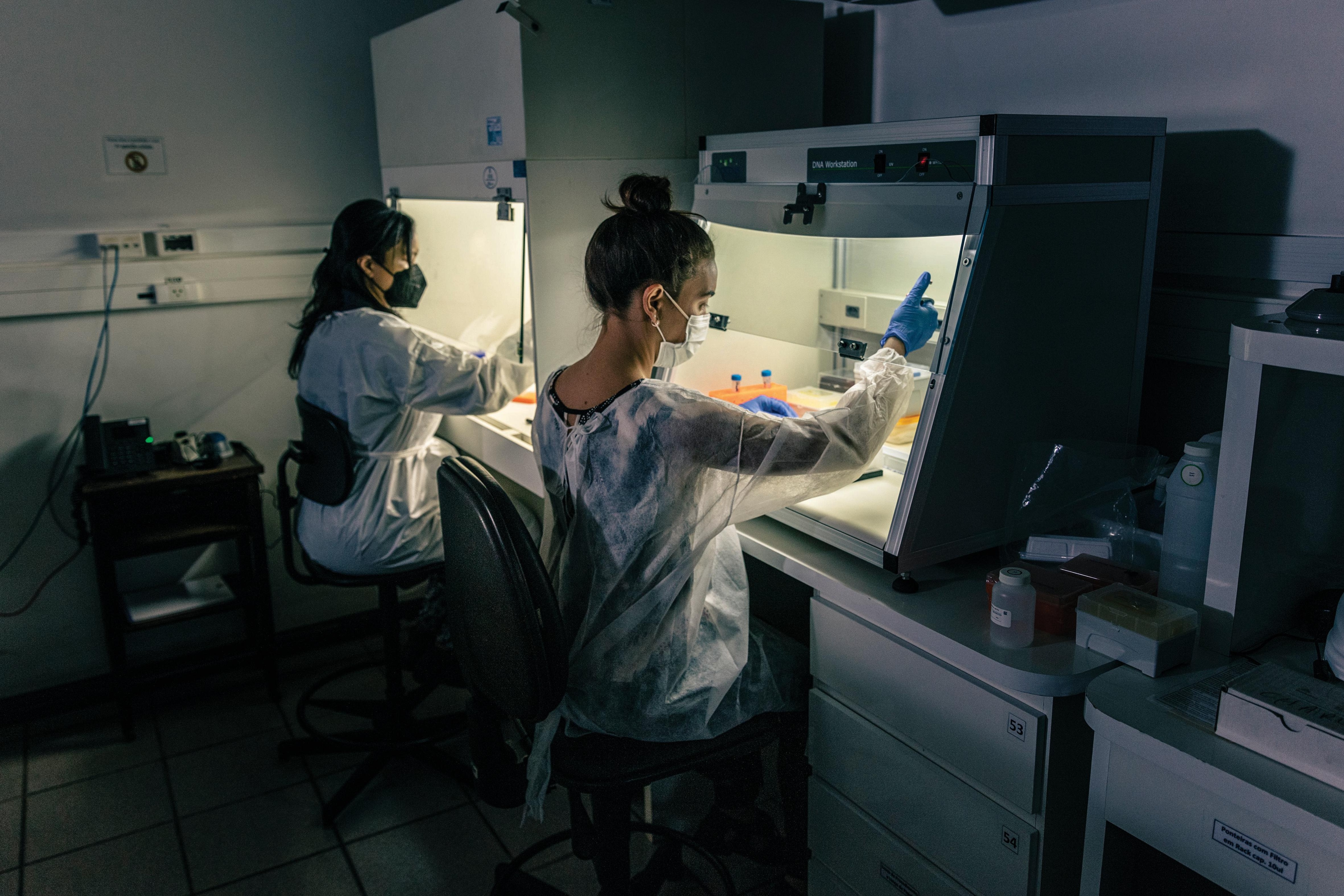
Researchers at the Institute of Tropical Medicine of São Paulo ready DNA samples to add to the group’s library
The Virus Hunters
PRIVATE COMPANIES, ACADEMIC CENTERS, AND GOVERNMENTS ARE TEAMING UP TO SPOT EMERGING HEALTH THREATS
BY ALICE PARK
EVEN THOUGH EXPERTS HAD LONG warned that the next pandemic was imminent, few saw SARS-CoV-2 coming. In the early days of the outbreak, researchers scrambled to collect samples from people who had mysteriously developed fevers, coughs, and breathing problems. Pretty soon, they realized that the disease-causing culprit was a new virus humans hadn’t seen before.
Lacking a coordinated global response, some countries acted quickly to develop tests for the novel coronavirus, while others with fewer resources were left behind. But with global travel (100,000 flights a day in 2019) far more common than when past plagues had hit, these inequities meant everyone was vulnerable. The solution? Shutting the world down, closing borders, and asking people to stay safely indoors.
It soon became clear that the world would weather this pandemic only by working together, and that governments alone couldn’t necessarily save us. Surveillance into the microbial world was necessary in order to predict coming outbreaks—or at least detect them more quickly after they hit. Some in the private sector saw an opportunity to harness their expertise and resources in testing and manufacturing to benefit both public health and their businesses. In 2021, the global health care company Abbott started the Abbott Pandemic Defense Coalition (APDC), the first convergence of public-health and academic experts led by a private company. It now includes 16 members based in 13 countries. Its mission: to detect new pathogens that threaten to wreak havoc on the world and contain them before it’s too late.
The experiment is just beginning, but it’s already paying off. APDC partners were among the first in the world to spot several dangerous mutations of the COVID-19 virus—including Omicron—just as they were emerging, which allowed countries to prepare by increasing testing, doubling down on vaccine programs, and advising infected people to isolate. It was a big change from being blindsided by the original version of the virus.
The virus hunters are not only watching out for new versions of SARS-CoV-2, but also continuing their search for the next potentially dangerous bugs. In June, as monkeypox began infecting people around the world, the network monitored genetic sequences of the virus that showed it had came from the less virulent of two strains endemic in Africa, and that existing vaccines would continue to be effective. Using that data, Abbott has developed a monkeypox PCR test (for research purposes only) that coalition members are using to track the virus, contain its spread, and detect any changes in the viral genome as soon as they appear. APDC is also continuing to monitor other emerging infectious diseases, including hepatitis, Zika, dengue, meningitis, and yellow fever. As humans continue to encroach on previously wild geographical regions, we’re more likely to come into contact with pathogens that can pose a threat to health. Climate change is also raising the risk of infectious diseases as species that carry viruses or bacteria expand to broader geographic areas.
The coalition’s goal is “to build the next generation of virologists, virus hunters, and epidemiologists,” says Gavin Cloherty, who leads APDC. “Preventing the next pandemic is a team sport, and collaboration is the only way we win.”
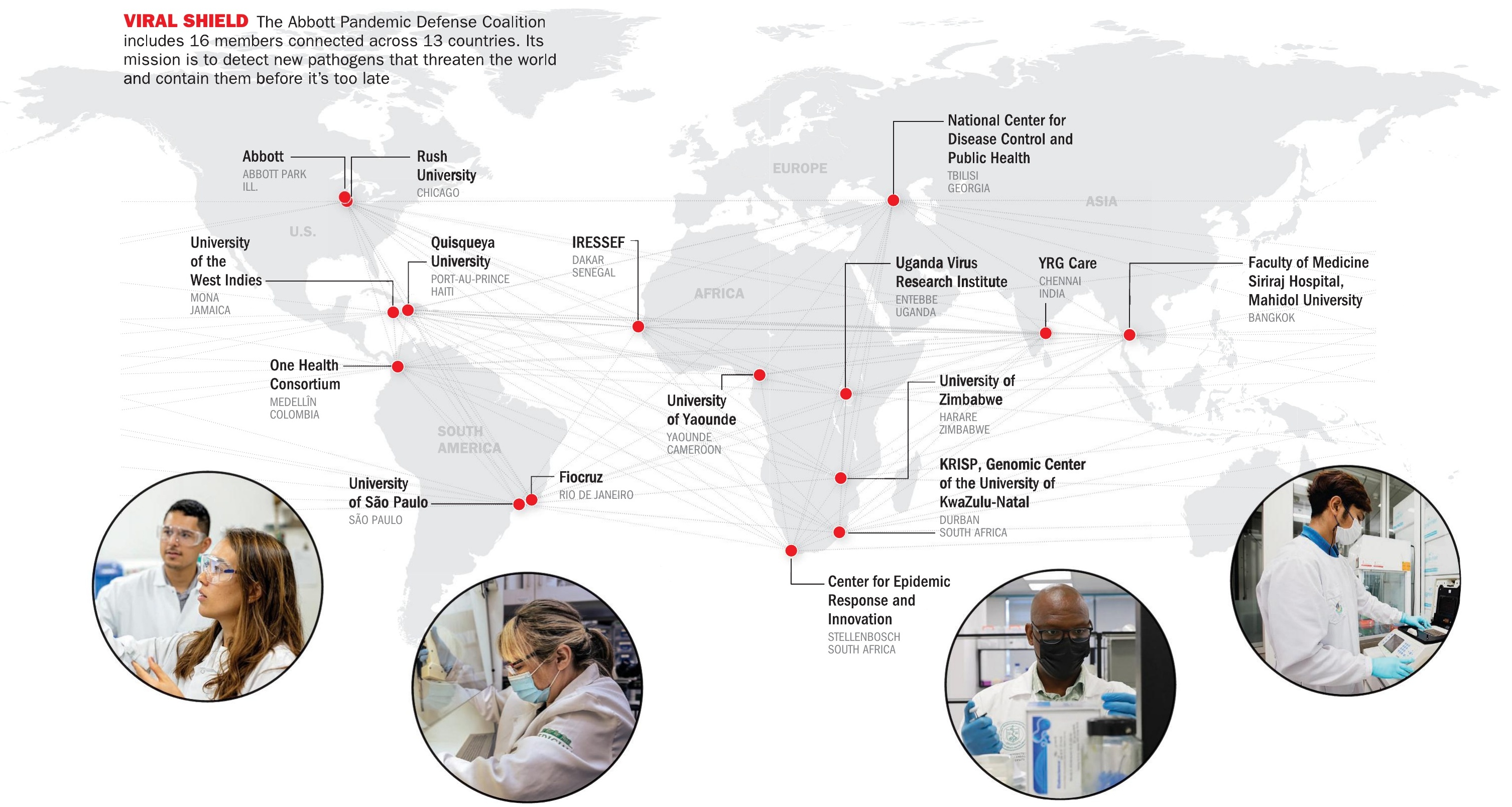
Scientists at a training session at Abbott’s U.S. labs (far left), and a researcher at the University of São Paulo (left) Researchers at University of KwaZulu-Natal (right) and Siriraj Hospital, Mahidol University (far right)
COVID-19 HAS TURNED OUT to be an ideal proving ground for this type of coalition. The virus is constantly evolving, and by comparing genetic sequences from COVID-19 patients in one region to previous samples, scientists at partner labs can spot any noteworthy differences and monitor them more closely. Any changes—especially if they appear in multiple parts of the world simultaneously—could represent mutations that make it easier for the virus to spread or cause more serious disease.
If any lab in the coalition detects a concerning pattern, it immediately shares it with the group. If others are seeing the same trend, Abbott and the partners work to ensure the current tests can still detect the new strain. Should the tests fail, then Abbott scientists would get to work revising them. “We are able to build tools like tests and assays that can be distributed to our partners and potentially manufacture them at scale if needed,” says Cloherty. Most important, the coalition also shares any concerning discoveries with global public-health officials, foundations, and government leaders—including the World Health Organization (WHO), the U.S. Centers for Disease Control and Prevention (CDC), and the Bill and Melinda Gates Foundation—as well as on global public databases. Knowing what might be coming can help health authorities deploy limited COVID-19 resources to where they are needed most.
The coalition serves Abbott’s business purposes, given that the company has a long history of providing diagnostic tests for pathogens—including its popular BinaxNOW COVID-19 rapid at-home tests. Being the first to hear of any changes in SARS-CoV-2 would give Abbott’s scientists a running start at modifying diagnostics. Finding more variants and more viruses means more tests—which makes sense for its bottom line.
But the public-health partners benefit too. Abbott wholly funds the coalition, providing scientists with state-of-the-art equipment, training, and lab supplies to collect samples and conduct genetic sequencing. Abbott also shares its scientific and manufacturing expertise, since it has been following viruses globally for about 30 years, from the start of the HIV/AIDS epidemic. That ongoing surveillance program is the predecessor to APDC; it monitors known pathogens—instead of new or emerging ones, as APDC does—for mutations that might affect diagnostic tests and treatments. The new coalition also links otherwise isolated public-health labs into a tight-knit community that can quickly disseminate information about new pathogens or genetic aberrations they discover.
“Although it is a private company, and diagnostic kits are to be sold, what I see is an effort to bring down scientific borders and increase communication across the globe,” says Esper Kallas, professor of infectious and parasitic diseases at the University of São Paulo, a coalition partner.
Being led by a private company sets APDC apart, but it isn’t the only collaborative group of virus hunters. The Rockefeller Foundation’s Pandemic Prevention Institute, for example, which recently partnered with the Pasteur Institute, is a philanthropy-led group of 33 members that act as sentinels for emerging infectious diseases that could become public-health threats.
Partnerships among entities like public-health groups, foundations, and private companies are increasingly essential for mounting a quick and efficient response against fast-moving viruses. Perhaps the best example of the power of such alliances was the U.S.’s ability to develop, test, manufacture, and distribute millions of COVID-19 vaccines in less than a year. The feat never would have been possible if the U.S. government had not funded pharmaceutical companies’ costs in developing and manufacturing these vaccines; doing so helped the U.S. and the rest of the world benefit from the revolutionary mRNA shots that had never before been used against a virus.
Experts believe that the only way to prepare for the next pandemic is not just to create more coalitions like these, but also to sustain them between public-health emergencies. “Public-private partnerships are essential for [disease] surveillance, testing, treatments, you name it,” says Dr. Eric Topol, director and founder of the Scripps Research Translational Institute. “We do better if those groups are working together.”
‘Preventing the next pandemic is a team sport.’
—GAVIN CLOHERTY, ABBOTT PANDEMIC DEFENSE COALITION
SO FAR, APDC MEMBERS have contributed to identifying three major SARS-CoV-2 variants. In June and July 2020, as the coalition was being formed, hospitals in South Africa noticed a rapid uptick in COVID-19 patients. “We found the exact same variant in samples from clinics that were hundreds of kilometers away, so we knew it was widespread and that we potentially had a new variant,” says Tulio de Oliveira, who leads the Center for Epidemic Response and Innovation (CERI) at Stellenbosch University in South Africa, an APDC partner. Data from the South African hospitals suggested that younger people were most affected, and that they were getting sicker than people who had been infected with the earlier version of the virus. De Oliveira alerted global health authorities to the new variant, which allowed them to prepare for a potential wave of hospitalizations. Back in Chicago at Abbott’s headquarters, scientists quickly determined that the company’s existing PCR and recently authorized at-home rapid tests for SARS-CoV-2 could still detect the new variant, which the WHO later dubbed Beta.
Several months later, Brazilian researchers issued a similar alarm. Researchers at the University of São Paulo led by Ester Sabino had worked with Oxford scientists during Brazil’s 2015 Zika outbreak to develop a mobile, compact machine to process virus samples; using it to scan COVID-19 samples in spring 2020, they noticed unusual sequences coming from northern Brazil in the Amazon Basin. The changes to the viral genome turned out to signal a new variant, Gamma, that would go on to cause significant disease and death in the area. But as tragic as Gamma’s local effects were, early detection likely prevented it from causing even more disease and death elsewhere in the country and world, says Kallas. “What would have happened if Gamma would not have been discovered until it reached a big city such as São Paulo, of 20 million people?” he says. “We would have been caught completely off guard.” Luckily, coalition scientists confirmed that existing rapid tests worked to detect Gamma, just as they had for Beta.
Then came Omicron. A lab technician in South Africa was conducting routine genetic sequencing of random SARS-CoV-2 samples in November 2021 and noticed that the virus was missing one of three protein signatures that all the previous variants had had. The technician tipped off de Oliveira’s group, which conducted a more detailed analysis showing that the virus had picked up a shocking 30 or so mutations—most of them in the spike protein, the very region targeted by vaccine- and drugmakers. In the span of six hours, hundreds of samples from more than 100 South African clinics arrived at de Oliveira’s labs. Sequencing those samples revealed the same pattern of mutations. Within 36 hours, de Oliveira had notified the Health Minister and President of South Africa, along with the WHO, that a new version of the virus was brewing.
Within days, de Oliveira also looped in coalition partners around the world to give countries a head start in looking for the genetic changes signaling the Omicron variant (which the WHO named shortly after).
The collaboration quickly put lots of different eyes on the same urgent problem. “Each of us brings a different skill set,” says Dr. Sunil Solomon, assistant professor of medicine in infectious diseases at Johns Hopkins and director of YRG Care in Chennai, India, one of the coalition partners. “People can go down rabbit holes thinking what they are working on is important, so they forget what the bigger picture is. The coalition is focused on translating what all of us find for clinical relevance to make sure that whatever we are doing is tailored toward improving the public’s health.”
A prominent proponent of this type of virus-hunting squad is Bill Gates. In his 2022 book How to Prevent the Next Pandemic, he describes the ideal global infectious-disease monitoring system, which he dubs GERM, for Global Epidemic Response and Mobilization. The idea is to maintain a network of scientists whose sole mission is to stay on top of infectious-disease cases and raise alerts if new unexplained infections are bubbling up anywhere in the world. GERM would also be responsible for sending teams of experts to help countries where outbreaks are occurring.
Similar systems already exist, but they aren’t robust enough. The WHO tracks emerging public-health threats through its Global Outbreak and Alert Response Network, which provides assistance to countries confronting emergencies. But its responsibilities extend beyond such outbreaks to include crises in food safety, natural and man-made disasters, and the release of chemical toxins. The CDC also surveils emerging pathogens and maintains international teams and mobile groups ready to provide assistance if countries ask for it.

Layla Honorato at the Institute of Tropical Medicine of São Paulo analyzes blood samples for any viruses present in them
Unfortunately, enthusiasm and funding for maintaining these types of systems ramps up during outbreaks—such as Ebola in the 2010s and now COVID-19—only to die down when the threat retreats. “It’s out of sight, out of mind,” says Sumit Chanda, professor of immunology and microbiology at Scripps Research, of the existing preparedness strategy. Gates calculates that it would cost about $1 billion to support 3,000 full-time virus hunters in a sustained war against invisible marauders—less than one-thousandth of what nations currently spend on defense. The funding, Gates says, should not come solely from philanthropists or foundations like his, but also from governments, which need to invest in preparing for public-health threats in the same way they shore up defenses against other dangers; and from private companies, which can provide experience and resources in the form of tests and manufacturing capabilities.
The prospectus for these investments is written in the headlines. Coronaviruses alone have caused significant outbreaks several times over recent decades—and that’s just one family of viruses. As the world learned with COVID-19, by the time a pandemic hits, it’s already too late to start creating relationships and building networks among different countries to share information in real time. And the network’s potential is only as extensive as its reach; the more partners linking together, the more likely the world will benefit from discoveries.
COVID-19 also made clear that monitoring for changes in existing pathogens and keeping a lookout for new ones isn’t a job for governments and global health groups alone. Industry can play important roles in controlling health outbreaks, but there often aren’t financial incentives for businesses to do so. “I don’t see enough companies who have made billions of dollars using some of that great profit to do things that are not in their self-interest,” says Topol. Instead, the world is left with a patchwork system of public-health sentinels that’s riddled with enough holes for pathogens to slip through undetected, giving them enough time to spread before diagnostic tests, vaccines, or treatments can be developed.
Even the refinement of COVID-19 vaccines in the U.S. is currently stalled. With more transmissible variants of SARS-CoV-2 circulating, and low uptake of the shots in many parts of the world, new vaccine designs—including nasal shots that might provide stronger and more durable protection against respiratory viruses like SARS-CoV-2—haven’t moved beyond the research and early-testing stages because of a lack of funding. Pharmaceutical companies could be enticed to invest in testing and developing innovative solutions like these if the government or philanthropic groups matched the funds industry partners put into development, Topol says, so that no one group would have to subsidize the entire cost. But so far, those investments aren’t forthcoming.
Systemic changes—like sustained funding—are needed in order to prepare for the next pandemic. Until we make those types of commitments, the world’s ability to see viruses coming will continue to be limited. But some experts, like Kallas, are hopeful that COVID-19 proves to governments how critical collaborations between countries can be, especially when it comes to identifying new potential health threats.
“Some people call the Amazon Brazil a hot zone, a place where diversity in flora and fauna are so [rich] that the chances of a bug jumping from one species into humans is high,” he says. A country like Brazil, then, would benefit greatly from having more virus hunters. Gamma, after all, won’t be the last virus to emerge from there. “We need a cultural change in mindset,” he says, “one that sees the value to society in investing in science to decrease suffering and make us a better society.”
FROM TOP: PHOTOGRAPH BY GUI CHRIST FOR TIME; ABBOTT; GUI CHRIST FOR TIME; NARDUS ENGELBRECHT; FACULTY OF MEDICINE SIRIRAJ HOSPITAL, MAHIDOL UNIVERSITY; GUI CHRIST FOR TIME
NATION
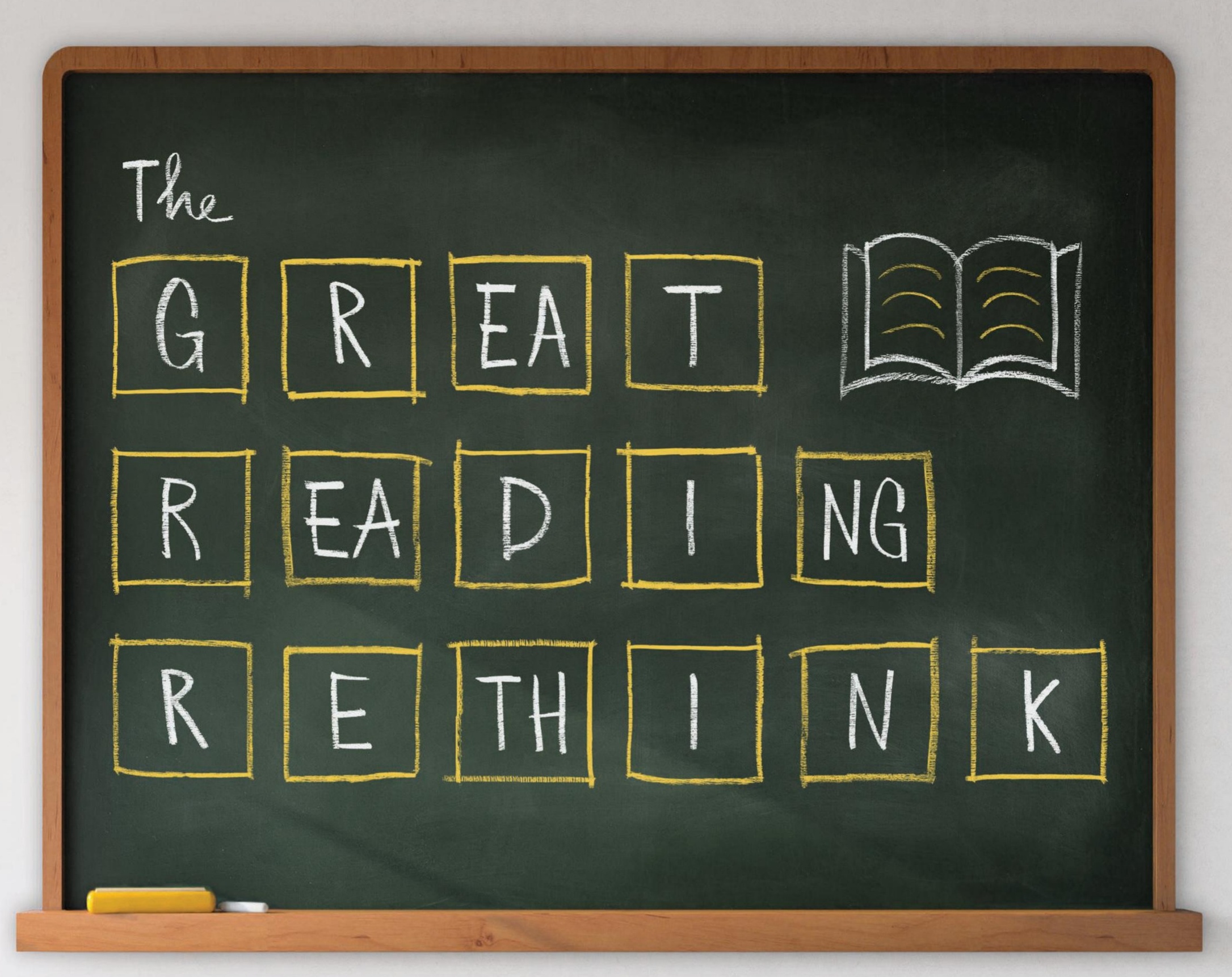
The GREAT READING RETHINK
Proficiency rates in the U.S. are abysmal. Inside the effort to change the way kids are taught
By Belinda Luscombe
ILLUSTRATION BY RICH MORGAN FOR TIME
AS A TEACHER IN OAKLAND, CALIF., KAREEM WEAVER helped struggling fourth- and fifth-grade kids learn to read by using a very structured, phonics-based reading curriculum called Open Court. It worked for the students, but not so much for the teachers. “For seven years in a row, Oakland was the fastest-gaining urban district in California for read-g ing,” recalls Weaver. “And we hated it.”
The teachers felt like curriculum robots—and pushed back. “This seems dehumanizing, this is colonizing, this is the man telling us what to do,” says Weaver, describing their response to the approach. “So we fought tooth and nail as a teacher group to throw that out.” It was replaced in 2015 by a curriculum that emphasized rich literary experiences. “Those who wanted to fight for social justice, they figured that this new progressive way of teaching reading was the way,” he says.
Now Weaver is heading up a campaign to get his old school district to reinstate many of the methods that teachers resisted so strongly: specifically, systematic and consistent instruction in phonemic awareness and phonics. “In Oakland, when you have 19% of Black kids reading—that can’t be maintained in the society,” says Weaver, who received an early and vivid lesson in the value of literacy in 1984 after his cousin got out of prison and told him the other inmates stopped harassing him when they realized he could read their mail to them. “It has been an unmitigated disaster.” In January 2021, the local branch of the NAACP filed an administrative petition with the Oakland unified school district (OUSD) to ask it to include “explicit instruction for phonemic awareness, phonics, fluency, vocabulary, and comprehension” in its curriculum.
Weaver and his co-petitioners—including civil rights, educational, and literacy groups—want schools to spend more time in the youngest grades teaching the sounds that make up words and the letters that represent those sounds. His petition is part of an enormous rethink of reading instruction that is sweeping the U.S. So far this year, five states have passed laws that require training for teachers in phonics-based reading techniques, adding to the 13 that passed such laws last year. And in May, New York City Mayor Eric Adams announced that elementary schools in the biggest district in the country would be required to adopt a phonics-based reading program.
The timing for such a dramatic change feels especially challenging. Elementary-school teachers are already having to recalibrate after two years of disruption; vicious fighting about public-health mandates as well as what kids should be taught about race and gender; and a widespread parental freak-out about how little their children have learned during the pandemic. Now the most fundamental skill that society asks them to pass along is also being completely shaken up.
But advocates say it cannot wait: in 2019, even before the pandemic upended instruction, only 35% of fourth-graders met the standards for reading proficiency set by the National Assessment of Educational Progress, an even lower number than in 2017. Only 21% of low-income students (measured by whether they qualify for free school lunch), 18% of Black students, and 23% of Hispanic students can be considered on track for reading by fourth grade. These numbers have been low for decades, but the pandemic has given the dismal results extra urgency. “There have been choices made where our children were not in the center,” says Weaver. “We abandoned what worked because we didn’t like how it felt to us as adults, when actually, the social-justice thing to do is to teach them explicitly how to read.”
‘There have been choices made where our children were not in the center.’
—KAREEM WEAVER, OAKLAND NAACP ACTIVIST
WHILE READING IS a foundational skill, it is not a natural one. Given enough time around other humans, the vast majority of youngsters will learn to walk upright and talk. For most children, however, recognizing that certain squiggles on a page or screen correspond to certain sounds requires painstaking instruction. In all, the 26 letters of the English alphabet can be combined to make about 44 sounds (depending on your accent). When those sounds are put together, they create 15,000 syllables and untold numbers of words. Ideally, children figure out what the letter string says at about the same moment a word they already know crystallizes into view. And after a couple of those aha moments, usually starting in first and second grade, when nicky reveals itself as nice or kahy-ef transforms into chief, the word seems to move into permanent memory. This is known as the simple view of reading: it’s the product of a robust ability to decode letters, and a strong vocabulary.
There are many schools of thought on how best to aid this process, but the main contretemps has been about whether kids need to be taught how to sound out words explicitly or whether, if you give them enough examples and time, they’ll figure out the patterns. The latter theory, sometimes known as whole language, says teaching phonics is boring and repetitive, and a large percentage of English words diverge from the rules. (Hello there, though, thought, through, and tough!) But if you immerse children in beautiful stories, they’ll be motivated to crack the code, to recognize each word. The counterargument is that reading is as connected to hearing as it is to sight. It begins, phonics advocates say, with speech. This understanding, and the data that supports it, has become known as the science of reading.
This debate was supposedly settled in 2000, when the National Reading Panel, a big group of literacy experts that examined hundreds of studies on what instruction kids need to read, released a report. It recommended explicit instruction in the things Weaver’s petition asks for: phonemic awareness, phonics, fluency, vocabulary, and comprehension. This was a victory for the phonics camps. But it is one thing to declare a war is over and another to parcel out territory.
Thus was born the notion of balanced literacy, which was an attempt to correct the ship’s course, rather than turn it around completely. Schools would introduce more instruction in the link between sounds and letters, but that could be sprinkled in with other methods teachers thought worked, like prompting kids to use context clues (including, say, pictures) when they came to a word they didn’t know.
The net result, says Timothy Shanahan, a former director of reading for Chicago schools and an early-literacy expert who was on the panel, was that balanced literacy came to mean whatever anybody wanted it to. Schools did not have to buy expensive new curriculums. Districts did not have to retrain their teachers. Teachers could add some lessons on phonics, but they didn’t have to hit reset on the way they taught. A 2019 survey of more than 600 elementary-school teachers by Education Week found that more than two-thirds used a balanced-literacy philosophy, although most also said they incorporated “a lot” of phonics. “The idea was each group would get some of what they wanted,” says Shanahan. “I’ve got to admit, I always thought that was a bad idea. It seemed to me that you should just go with the research.”

A third-grader works through a phonics lesson in Washington, Ill.
READING SCORES DID NOT IMPROVE much after balanced literacy was introduced, but they didn’t plummet, either. Things might have stumbled along in much the same way, except that education departments around the country had begun to earn the ire of a particularly determined group: the parents of dyslexic children. People with dyslexia take much longer to sort out the connection between sound and symbol. The immersion method of teaching was simply not going to work for them. Pressure from these parents, plus some crusading journalism, a steady stream of research, impressive results from several school districts, and heightened concern about pandemic learning loss, have finally turned the tide back toward a stronger emphasis on phonics.
Dyslexia is not linked to intelligence; it has been described as an island of weakness surrounded by a sea of strength. It has no cure but can be overcome. So when some wealthy, well-educated parents found their otherwise typical children were not learning to read, they had questions for the school. These were met in many cases with the advice to read to them more. The parents then did what educated, wealthy people do when they feel slighted: they looked at the research, paid for expensive testing, called their representatives, and contacted their friends in the press.
What they found was that the methods many teachers were using were not supported by the data. They were supported by theories, observations, hopes, and, some would argue, a few guru-like figures. Just as most children, no matter how many times they’ve been in a car, still need to be taught to drive, most readers benefit from being explicitly taught how sounds and letters go together. This is true not just for dyslexics (who represent about 10% of all learners) but for the majority of readers.
Some of the data these parents uncovered comes from the world of neuroscience. Cognitive scientists have found that as a child reads a word, the networks in the brain associated with vision activate first, followed by the areas of the brain associated with speech. There are also subtle but detectable changes in the brain as children learn to read, primarily a growth in the fibers that connect the areas associated with speech and vision. French neuroscientist Stanislas Dehaene, in his 2009 book Reading in the Brain, calls this area “the letterbox.” His studies suggest that the brain never really learns to read a whole word, it just gets really, really fast at decoding. He believes that any type of learning that does not emphasize the sound of words is inefficient.
About a decade after his book was released, Emily Hanford, an education reporter at American Public Media—after being contacted by dyslexia activists—did a multipart audio documentary on why the National Reading Panel’s recommendations and all the research were so blithely ignored. It was she who popularized the phrase the science of reading.
State legislatures, which have been getting an earful from dyslexia activists for years, have begun to act. From 2013 to Aug. 1, 30 states have passed laws or enacted new policies related to “evidence-based” reading instruction. Mississippi was one of the first, and in 2019 it became the only state in the nation to meaningfully improve its fourth-grade reading scores. The results were touted as the “Mississippi Miracle.”
As the pandemic stretched on and children missed a lot of school, parents became increasingly worried about how their kids would catch up and looked for such a miracle. Kymyona Burk, who helped implement the changes in Mississippi and is now a policy fellow at think tank ExcelinEd, says she met “a lot of parents who may have been involved but not engaged. They would show up to PTA meetings and sign progress reports but didn’t really understand what went on in the school.” COVID-19 may have changed that. “To be at home and to sit beside your child, or to hear your child in the other room with virtual learning?” says Burk. “Parents learned a lot.”
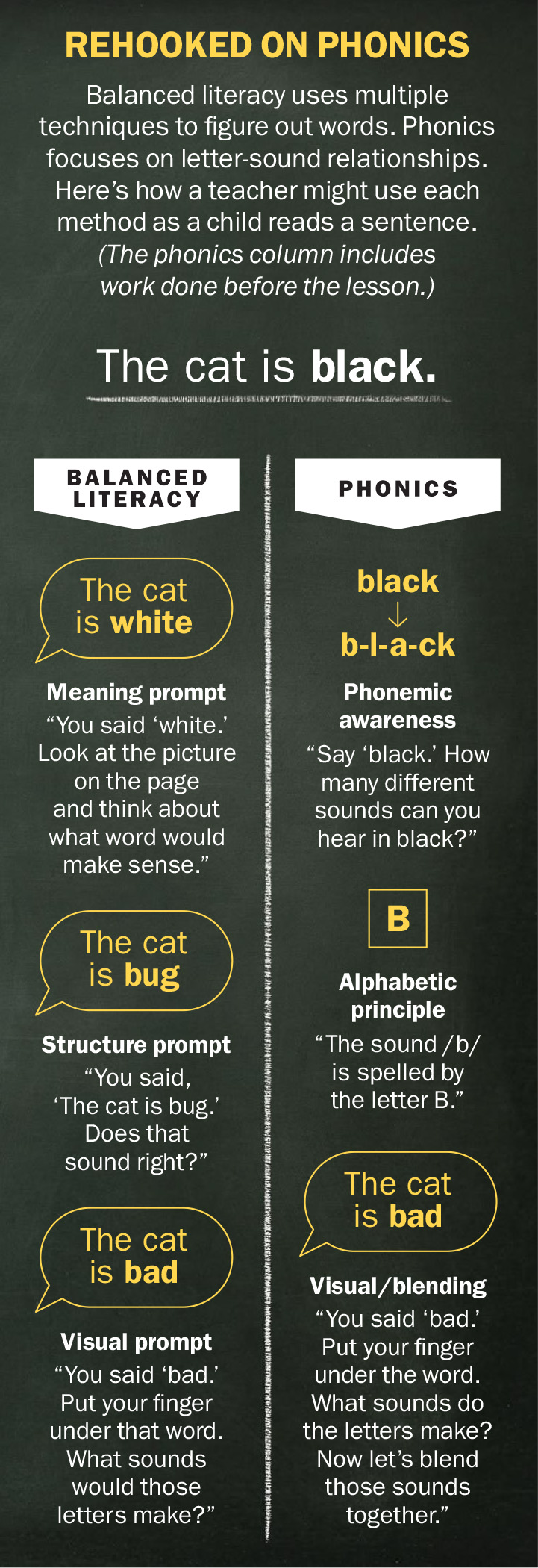
BUT EVEN WITH the Holy Trinity of school change—legislatures, researchers, and activist parents—on the case, getting teachers to use new techniques has been an uphill battle. “Passing the law was the first step for us, and it was the easy thing,” says Burk. What others tout as a miracle, she notes, was more like a slow climb, with steadfast funding, tireless messaging, and a top-to-bottom reorganization of the way Mississippi’s youngest readers were taught. “The hardest part was convincing others who had done things a certain way for such a long time that we needed to make a shift. We had to make a shift in our instructional practices; we had to make a shift in the curricula that we were purchasing; and also we had to just really come to terms with the fact that there were so many of our teachers who had come through our education-preparation programs who still were not equipped to teach children who struggle how to read.”
Mississippi retrained all its teachers using LETRS (Language Essentials for Teachers of Reading and Spelling), an intensive training module that takes them all the way back to understanding the sounds in speech, what is known as phonemic awareness. Many states have followed suit. But retraining busy teachers takes a while and doesn’t necessarily change what they do in the classroom. “There are tens of thousands of schools in the United States, and nobody really monitors what goes on in those schools,” says Shanahan, who in nonpandemic times visits 40 or 50 schools a year. “A lot of times the teachers have no idea that they’re not teaching things that are beneficial to the kids.”
Even if the teachers are equipped to teach a new way, they need the support of their principals and superintendents. Stacey Pim, an elementary reading specialist in Virginia, began to use more of her instruction time to teach first-grade students letter-sound correspondence in the fall of 2020, after she noticed that in prior years, the skills of first-graders at her school had not improved. “By the time they got to second grade, we were having a whole classroom of children who were below grade level,” she says. Moreover, because of the pandemic learning gaps, she felt her students were not able to tackle the work that the curriculum was offering. But, she says, her administrator told her she needed to stay with her school’s balanced-literacy program. Feeling stuck, and with her own kids to deal with, she resigned. (Only 18 months later, in April 2022, Virginia enacted new “evidence-based” teacher-training regulations.)
Pim was not alone. The pandemic was extremely hard on teachers, typically nurturing, underpaid souls who got into the profession because they wanted to help others. Recent surveys have showed a sharp uptick in those wanting to leave the profession early. Making matters worse, the discussion about reading quickly became like so many others in education: less about children and improving techniques and more about finger-pointing and blame. It also became politicized, since it was mostly progressive states that used methods that leaned toward child-led learning and more conservative ones that embraced the traditional phonics-heavy methods.
When Kari Yates, a former school principal and literacy manager in Minnesota who used the balanced-literacy-based Reading Recovery program to help struggling readers, heard that teachers in her district were going to have LETRS training, she thought she’d check it out. “I don’t think I anticipated going into it that I was going to be as triggered as I was,” says Yates. The language used seemed to belittle the work of those like her who had toiled for years to teach children to read using less phonics-forward methods.
Yates’ friend and writing partner Jan Burkins had also heard about this so-called science of reading and started looking at research to debunk it. Instead, she too became increasingly convinced that Emily Hanford’s reporting was right. “We began to realize, Oh, there are some things that we’ve been doing that actually make it harder for children to learn to read,” she says. “And there are some relatively simple ways to shift some practices that make it easier.” Burkins and Yates wrote a new book, Shifting the Balance, to try to build a bridge between the two camps. It is selling well, but the duo are wary of its success because it leaves them open to attacks from both sides. “People I’ve had great respect for in the field are being really criticized,” says Yates.
The two write that they had to make a pact not to give in to defensiveness as they discussed why approaches such as the use of leveled readers (which predict what kinds of stories children should be reading) should be discarded in favor of decodable texts (which give them a lot of opportunities to practice sound-letter correspondence) as well as the problems with what’s known as cueing, where teachers get children to ask a lot of questions about the word they’re stuck on, rather than just sounding out. “Moving away from a model of reading that is strategic to one that is more aligned with what we know from the inside out about what the brain is doing when we’re reading, it’s a big, hard thing for teachers,” says Burkins.
‘We’re just not doing a good enough job. Let’s start right there.’
—TIMOTHY SHANAHAN, EARLY-LITERACY EXPERT
THE DIFFICULTY OF getting teachers fully on board is one of the reasons Shanahan is wary of saying the change is here to stay. “This [shift] happens with some regularity in this field,” he says. “I’ve been doing this for more than 50 years, and this is about the third one I’ve been through.” This time is a little different, he acknowledges, because more mainstream media outlets have taken an interest in something that is usually the preserve of academia. And this is the first pendulum swing in the era of social media. A Facebook page called The Science of Reading—What I Should Have Learned in College has more than 165,000 members, most of them aggrieved parents or bewildered and angry teachers.
Hanford’s reporting laid the blame for the neglect of a foundational reading practice largely at two doors: curriculum publishers, which market programs that critics say are not supported by science; and schools of education, which are slow to change the way they teach teachers to teach reading. It singled out Irene Fountas and Gay Su Pinnell’s Leveled Literacy Intervention, which is used by about 43% of K-2 teachers in the U.S. and suggests that students can get information about words from sources other than the letters, and Lucy Calkins’ Units of Study for Teaching Reading, which is used by 14%, including, until recently, Oakland schools. (An OUSD spokesperson says it adopted a new curriculum in May 2021 and is also examining new phonics programs.)
Four years after Hanford’s first story on the issue ran, those things too are finally changing—a little. Calkins, the founding director of the Teachers College Reading and Writing Project at Columbia University and a prominent figure in the field of early reading, added more emphasis on the explicit teaching of phonics to her most recent version of the curriculum, although her critics contend it’s not enough. Fountas and Pinnell remain holdouts, saying in a recent series of blog posts that their work has been mischaracterized. None of these authors agreed to be interviewed.
It’s probably too soon to accurately assess the impact of the pandemic on children’s learning. A McKinsey report found that students in 2021 were about four months behind in reading compared with nonpandemic years. The Brookings Institute found a 15% increase in the gaps in reading proficiency between students at the wealthiest and most impoverished schools. A study out of the Netherlands found that even a relatively short eight-week lockdown led to a learning loss of a fifth of a year. But it’s not all bad news. A lot of states are using their federal COVID-19 relief funds to buy new curriculum, retrain teachers, and hire literacy coaches. One of them, Tennessee, recently announced that its 2022 fourth-grade reading scores surpassed pre-pandemic levels, though still only about 40% met or exceeded standards.
The stakes couldn’t be higher.
Fourth grade is a key moment in a child’s education. Until then, as the old saying goes, children are learning to read; after that they’re reading to learn. If they can’t, things head south. A 2011 study from the Annie E. Casey Foundation found that students who don’t read proficiently by the end of third grade are four times as likely to eventually drop out of school as those who do.
Not every child needs systematic instruction in phonics. Some can figure out the patterns for themselves. And phonics instruction alone is not enough. But the past several decades seem to have proved that a more intense focus on the letter sounds hurts nobody, and the many children who need it flounder without it. There are no panaceas in education. Even the most science-steeped curriculum will not help if it is not implemented thoughtfully, with support from principals, literacy coaches, school-district officials, and the public purse. “The schools, we’re just not doing a good enough job,” says Shanahan. “Let’s start right there.”
Teachers have every reason to feel sore about the training they didn’t receive and the children they therefore couldn’t help. But they don’t have time to look back. “Here’s the lament,” says Weaver, who is still in discussions with OUSD. “The lament is that when we started using new materials, the kids weren’t learning how to read, and to explain that, rather than looking at our materials and what we were doing, we focused on the kids and said, ‘Something’s wrong with them. Something’s wrong with our community. They’re too traumatized or too broken. Their families aren’t good enough. They’re poor.’ We explained the lack of learning in those terms, as opposed to saying, ‘Wait a second, what are we doing? And what did we do when things were working?’”
GETTY IMAGES; MATT DAYHOFF—JOURNAL STAR/USA TODAY NETWORK/REUTERS
SOCIETY
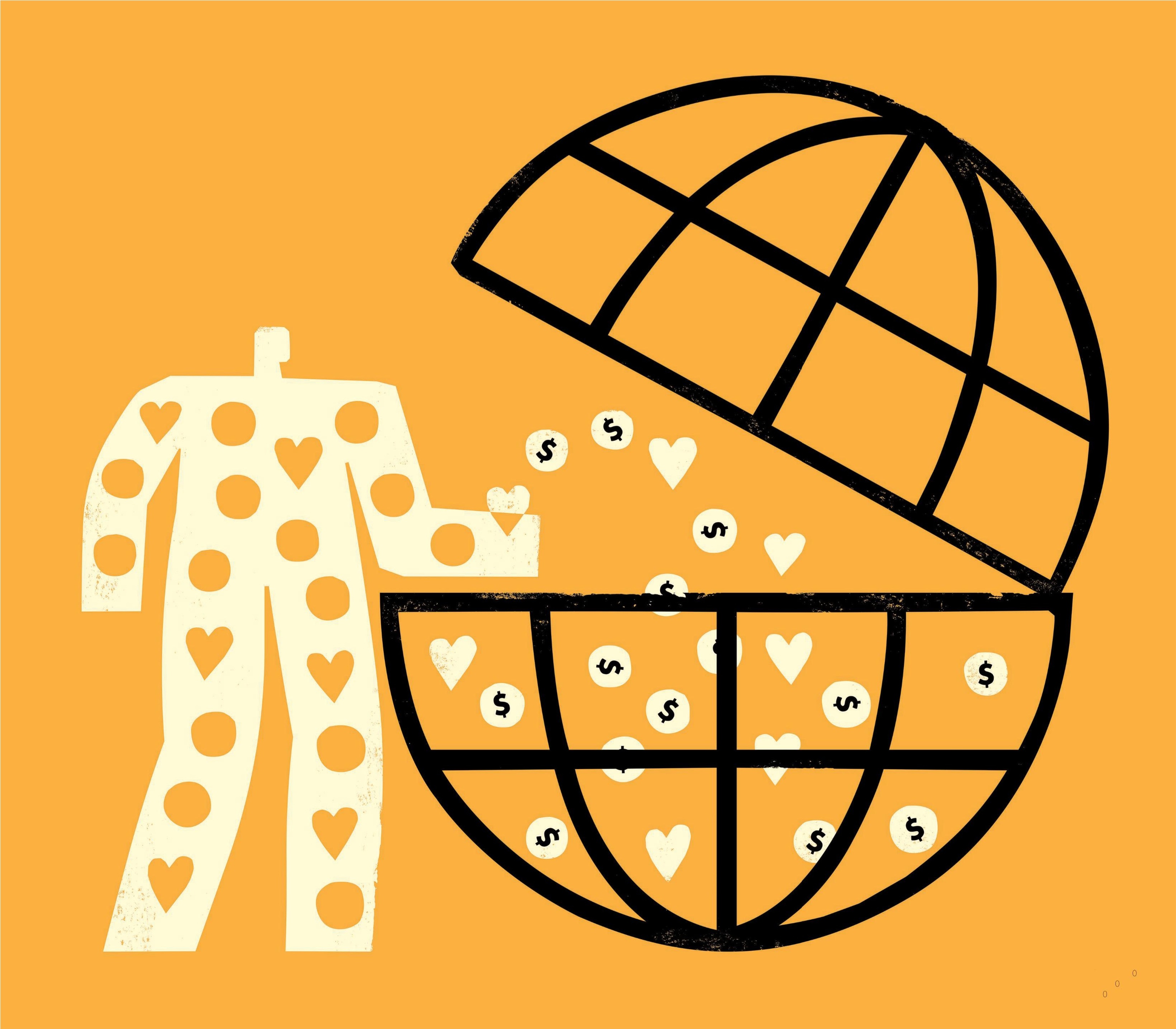
How to Do the Most Good
a growing movement argues we should care about people thousands of miles away—and millions of years in the future
BY NAINA BAJEKAL/OXFORD, U.K.
THIRTEEN YEARS AGO, WILLIAM MACASKILL FOUND HIM-self standing in the aisle of a grocery store, agonizing over which breakfast cereal to buy. If he switched to a cheaper brand for a year, could he put aside enough money to save someone’s life? It wasn’t the first time he’d been gripped by this kind of angst. His life has often felt like a series of difficult choices: Should he donate even more money to charity? Should he quit academia and work in politics—even if he hated it—in the hopes of having a greater social impact? What if he moved to a different city—could he do more to help others elsewhere?
For anyone enjoying a comfortable life in a world of horrifying inequality, examining your choices closely might spark similar questions. For MacAskill, a 35-year-old Scottish philosopher who co-founded a movement dedicated to doing the most good possible, the stakes of even mundane decisions can feel especially high.
Yet when we meet on a sunny July afternoon in Oxford, he seems to have found a way to carry that load. In fact, for a man who’s spent the past few years thinking about how humanity might permanently derail its future, he’s surprisingly cheerful. He’s just returned from a week of surfing with his partner Holly Morgan on the south coast of England. After years of suffering from depression and anxiety, he now prioritizes sleep, exercise, and meditation. He enjoys swimming outdoors, playing the saxophone, and holding “fire raves” in fields with friends, dancing around a bonfire to house music until the early hours. “There are many things in my life I care about for intrinsic reasons,” he says, “not because I’ve done some 12-dimensional maths about how it contributes to the greater good.”
The greater good has been the focus of his work for more than a decade, since he helped start the effective altruism (EA) movement, which aims to use evidence and reason to find the best ways of helping others, and to put those findings into practice. EA holds that we should value all lives equally and act on that basis. It is the antithesis of the old do-gooder’s credo “Think global, act local.”
His new book, What We Owe the Future, argues we should expand the moral circle even further: if we care about people thousands of miles away, we should care about people thousands or even millions of years in the future. The book, which has been praised by the likes of Stephen Fry and Elon Musk, makes the case for “longtermism,” the view that positively influencing the long-term future—not just this generation or the next, but the potentially trillions of people still to come—is a key moral priority of our time. Through analyzing the risks of climate change, man-made pathogens, nuclear weapons, and advanced artificial intelligence, MacAskill has come to believe we’re living at a pivotal moment in human history, one where the fate of the world depends significantly on the choices we make in our lifetimes.
For many years EA, which is both a research field and a real-life community, drew a small group of moral philosophers, nonprofit researchers, Bay Area rationalists, and altruistically inclined students. Now their ideas are increasingly taking off outside of those circles. More than 7,000 people have signed a pledge to give away at least 10% of their income to the kinds of high-impact charities recommended by, for example, GiveWell, which started in 2007 in New York City to evaluate charities based on cost-effectiveness. There are more than 200 EA chapters around the world, from Nigeria to India to Mexico; this year, approximately 6,000 individuals will attend conferences in cities including Prague, Singapore, and San Francisco—where EA, with its data-driven approach to doing good, has found a particularly receptive audience. EAs, as members of this movement call themselves, are working in government, advising on policy, and running for office.
The expansion has been fueled by a substantial rise in donations. In 2021, EA-aligned foundations distributed more than $600 million in publicly listed grants—roughly quadruple what they gave five years earlier. While this is a minute fraction of global philanthropy—and only 0.1% of U.S. giving, which amounted to $485 billion the same year—the movement is growing and has the support of a new generation of young philanthropists planning to funnel their fortunes into EA causes.
The vast majority of EA’s newfound wealth comes from two tech billionaires: Dustin Moskovitz and Sam Bankman-Fried. Open Philanthropy, which is primarily funded by the Facebook and Asana co-founder Moskovitz and his wife Cari Tuna, distributed more than $440 million in grants in 2021, a third of which went to global health and development, 28% to longtermist interventions (such as biosecurity and EA community growth), 18% to animal welfare, and the rest to research in areas such as economic policy and criminal-justice reform. Four months after launching in February this year, the FTX Future Fund had committed more than $130 million in grants, mostly to longtermist causes. The money comes from Bankman-Fried, the CEO of cryptocurrency exchange FTX, who was inspired to pursue a high-earning career after meeting MacAskill in 2012.
Bloomberg estimates Bankman-Fried’s net worth at $12.8 billion (down because of this year’s crypto-market crash) and Moskovitz’s at $13.8 billion. Both have committed to giving away most of their wealth, with EA-aligned organizations as the tributaries. Between them, that’s more than $26 billion. That far surpasses the endowments of two of America’s oldest private foundations, the Ford Foundation ($16 billion) and the Rockefeller Foundation ($6.3 billion). Like those foundations, Open Philanthropy and the Future Fund function as grantmakers for projects, nonprofits, and individuals they deem high-impact.
Despite all this growth, MacAskill still worries he’s not doing enough. Every year, millions of people die from easily preventable diseases, millions more are oppressed and abused, and hundreds of millions go hungry. On top of that, some 80 billion land animals are killed for food every year. “That’s just a f-cked-up place to be,” he says. As he sees it, pure moral philosophy leads to the conclusion that the correct thing—at least for someone with his privileges in a wealthy country—is to sacrifice everything you could for the greater good. “The question is,” he says, “how do I manage my life such that even though I believe that at the fundamental level, I don’t go completely insane?”
The EA movement has proved remarkably expansive, allowing those who might be inclined toward radical individualism to work alongside the more collectively minded. But for it to deliver on its aim—to improve as many lives as possible—it needs to help answer an impossible question: How much comfort should we be willing to trade for potentially enormous gains to society?
‘“EVERYTHING SUCKS” IS NOT HELPFUL. THE RELEVANT QUESTION IS, WHAT CAN WE DO?’
—WILLIAM MACASKILL
MANY OF THE PEOPLE who helped give rise to EA felt compelled to do good from a young age. At 11, Niel Bowerman tried to encourage his London classmates to carpool to help combat climate change. As a 13-year-old in suburban Richmond, Va., Julia Wise began giving away her allowance. The summer before his senior year at Stanford, Alexander Berger signed up to donate a kidney to a stranger. Sixteen-year-old Benjamin Todd conducted an audit to show how his school could reduce carbon emissions; in response, the school started an organic garden. “That wasn’t really what I had in mind,” he says now, laughing.
As a teenager in Glasgow, MacAskill was similarly interested in big ideas and helping others. Born William Crouch (he took his ex-wife’s grandmother’s maiden name when they married in 2013), he was the youngest of three sons. His mother worked as a geneticist for the National Health Service while his father worked in IT for a clothing company. He wrote in his journal about the philosophy of love and harbored aspirations of becoming a poet; he volunteered at summer camps for children with disabilities and worked at an eldercare facility. “My mum was honestly always pretty confused by it,” he says. At Cambridge University, MacAskill became vegetarian, got involved in climate activism, and started attending lectures on political philosophy, feminism, and global governance. It was during his final year that the urge to do good began to bubble more strongly. He spent the summer after graduation working for a humanitarian nonprofit. “All day, every day, I was thinking about extreme poverty,” he says.
Shortly after he arrived at Oxford for graduate studies in philosophy, MacAskill was introduced to the Australian philosopher Toby Ord, who had pledged to give more than half of his future earnings to charity and was thinking about how to connect others interested in doing something similar. The 22-year-old MacAskill volunteered to help him, and in 2009 they launched Giving What We Can to encourage more people to take the 10% donation pledge.
Two years later, in 2011, MacAskill and Todd, a fellow Oxford graduate, cofounded the nonprofit 80,000 Hours (named for how long the average person spends at work over their lifetime) to provide advice on using your career to make a positive difference in the world. After debating a bunch of terms for their burgeoning community—from “good maximizers” to “rational altruism”—MacAskill and his colleagues founded the Centre for Effective Altruism (CEA) in 2012, as an umbrella organization for the two projects. Their first significant donations came from a couple in Boston: Julia Wise, the former allowance gifter, who was by then a social worker donating a significant portion of her salary, and her husband Jeff Kaufman. After years of working in cafés and libraries, CEA rented its first office in the basement of a real estate office; about a dozen people worked there, eating bread and hummus for lunch.
Nine years on, I meet MacAskill outside Trajan House in Oxford, a sleek, glass-walled building that several EA organizations share with Oxford University. There’s a small gym, weekly yoga classes, and a nap room. Our lunch from the office canteen is a Tuscan ribollita stew, garlic bread, and salad provided by vegan caterers Greenbox. MacAskill says he sometimes misses the bread-in-the-basement days, which felt consistent with the mission. But CEA now has an annual budget of $28 million, which allows for the sorts of amenities one doesn’t typically associate with shoestring nonprofits. MacAskill says the comforts help to maximize productivity and well-being, and they’re cautious about not overdoing the perks. “We don’t want to go for obscene luxury,” he says, “but the main thing to focus on is how much impact we’re having.”

ASSOCIATE PHILOSOPHY PROFESSOR WILLIAM MACASKILL, AT HIS OFFICE IN OXFORD ON JULY 14
When assessing a potentially worthy cause, EAs calculate impact using three components: importance or scale (how much good could arise from working on it), tractability (how solvable it is), and neglectedness (how overlooked it is in terms of committed resources). One result of filtering the world’s problems through a lens of where an extra dollar or hour would have the most impact is that EA donations can seem to lack any obvious connection: among Open Philanthropy’s causes are South Asian air quality, farm-animal welfare, and the risks of advanced AI.
The emphasis on neglected causes has led many EA leaders to focus more on how to maximize the good not just for those alive today, but also for the many, many generations to come. As more intellectual excitement and resources have started flowing to causes like existential threats, some in the movement have worried that the reasons they all got into this—to help tackle urgent, overlooked suffering—could end up falling by the wayside.
MacAskill seems acutely aware of the trade-offs of prioritizing future people, though he believes they are uniquely disempowered by the incentives of our current political and economic systems. “If you’re a small force in the world, then there’s an argument that you should be going all in on one thing,” he says, noting that far more money goes to foreign humanitarian aid than to pandemic preparedness, AI safety, and preventing nuclear war. “EA is always fundamentally asking: What can be done on the margin? Moving the global allocation of resources potentially just a little bit in one direction can have an outsize impact,” he says.
But MacAskill wants EA to be an adaptive community, not an intellectual monoculture—which means he favors a breadth of causes. “When I start thinking in practice, if you’ve got some things that look robustly good in both the short and the long term, that definitely makes you feel a lot better than something that is only good from a very long-term perspective,” he says. This year, for example, he personally donated to the Lead Exposure Elimination Project, which aims to end childhood lead exposure, and the Atlas Fellowship, which supports talented high school students around the world to work on pressing problems. Not all issues are equally tractable, but MacAskill still cares about a range; when we met in Oxford, he expressed concern for the ongoing political crisis in Sri Lanka, though admitted he probably wouldn’t tweet about it.
With countless problems worth addressing, he knows “moral vertigo” can feel inevitable. Suppose you decide you’re going to raise money for people dying of malaria, he says. Then what about all the people dying of tuberculosis, because you’re choosing to focus on malaria? “We are in this horrific situation where you’ve got to make trade-offs about what you do,” he says. The answer, he believes, is to be honest about it. In philanthropy, big donors typically choose causes based on their personal passions—an ultra-subjectivist approach, MacAskill says, where everything is seemingly justifiable on the basis of doing some good. He doesn’t think that’s tenable. “If you can save someone from drowning or 10 people from dying in a burning building, what should you do?” he proposes. “It is not a morally appropriate response to say, well, I’m particularly passionate about drowning and so I’m going to save the one person from drowning rather than the 10 people from burning. And that’s exactly the situation we find ourselves in.”
A big part of MacAskill’s work these days is trying to persuade very wealthy people to change how they give away money. Like so many others in philanthropy, he both counts on the largess of billionaires and worries about the risks of dependence. “Look at any moral movement in the past, you will find examples of the ideas being misused to justify actions that aren’t in line with the best thing,” he says, positing that liberalism was used to justify colonial atrocities, and Marx and Engels’ concern for the working class was exploited by Stalin.
That’s partly why he thinks it’s crucial that EA continues to have culture-setters who are serious about their moral obligations. MacAskill and Ord see it as especially important to stick to the “Further Pledge” they both took to donate not just a certain percentage of their earnings, but everything above a set sum. MacAskill currently lives on £26,000 ($31,000) a year, which is slightly above the median household income in the U.K., and the proceeds of his new book all go to the Effective Altruism Funds. “It’s a legible demonstration that I’m in this because I really care, I’m not getting any financial benefit,” he says. That kind of commitment helps signal the moral seriousness of the EA community, he hopes, and is also personally reassuring. “I might worry, am I drifting in values? OK, no, if I’m still doing these things, I guess I must still be a good person.”
IT’S POSSIBLE THAT MACASKILL wouldn’t still be thinking about doing good at all, if not for that chance introduction to Ord. Like many young people, he had a sense that the world was full of injustice and a desire to make a difference, but he didn’t know where to channel it. There was plenty of discussion about how terrible the world was, he says, but little offered in the way of concrete action. “I was feeling really bad, but what I really wanted was to make the world better, rather than to make myself feel worse,” he says. “It’s quite plausible to me that I would have had this wave of moral motivation, not found an outlet for it, and it would just have faded away over time.”
I was in a similar position when I first encountered effective altruism as a university student. I’d grown disillusioned about a planned career in international development after a year working at a nonprofit when I came across the 80,000 Hours career advice. At the time, it was promoting a strategy called earning to give, encouraging students to pursue lucrative careers doing, for example, quantitative trading at hedge funds, in order to donate a significant portion of their salaries—rather than working directly for nonprofits. (80,000 Hours has now de-emphasized this approach.) That strategy is controversial and certainly wasn’t a good fit for me. But as soon as I graduated in 2014 and got my first internship at this publication, I signed the Giving What We Can Pledge. I now donate about 15% of my pretax income, mostly to EA-recommended charities working on global health, climate, and animal welfare. (I had never attended an EA event nor met any key figures until I began reporting this story.)
I was interested in EA as a set of ideas, if less in the community. Even today, the typical effective altruist is a white man in his 20s, who lives in North America or Europe, and has a university degree. (While geographic diversity is growing, gender diversity still lags.) I was glad to know that there was a group of people taking seriously the question of how to do good, but they just didn’t seem like my people.
Even for MacAskill, the community can have its downsides. Back in 2015, effective altruism felt like the majority of MacAskill’s identity; he recalls attending the wedding of his best friend from high school and realizing that he wasn’t one of the groomsmen because he had let the friendship fallow. That year was a turning point: he separated from his wife, the philosopher Amanda Askell, got his Oxford professorship at the exceptionally young age of 28, and began actively cultivating a more multifaceted life.
Still, EA remains a lodestar. “It doesn’t impact my feeling of happiness in the way that dancing might impact my feeling of happiness,” MacAskill says. “But there’s this deeper sense of satisfaction or even harmony with the world.” He might still worry about how bad everything is, or how much worse it could get, but he is largely doing his best to find solutions. “The mode of ‘everything sucks’ is not helpful. Maybe it’s true, but the relevant question is, What can we do?”
Many EAs echo that sentiment: that doing something, even when the right course of action is unclear, is better than giving in to fatalism, which is often where I find myself. It can be tough to work in journalism—a field that stares right at the world’s problems—and not become cynical. When things feel particularly bleak, I sometimes tell myself that even if I had the time and energy to try to make the world better, I’d probably fail.
Effective altruists try anyway. They know it’s impossible to take the care you feel for one human and scale it up by a thousand, or a million, or a billion. Rather than getting overwhelmed by the magnitude of the problem, they focus on the difference a single person can make.
“Some people would think that what we do is just a drop in the bucket,” Ord says. “But it doesn’t really matter what size the bucket is. If what you can do in your life involves really saving hundreds of lives, or transforming the lives of hundreds or thousands of people, that’s just as big no matter how many other people need help.”

THE MORAL PIONEERS ON MACASKILL’S DESK: HUMANITARIAN IRENA SENDLER, ABOLITIONIST BENJAMIN LAY, AND PHILOSOPHER MOZI
IS DOING ANY OF THIS actually a moral obligation? Effective altruists tend to be divided on the subject. MacAskill says EA explicitly doesn’t make moral demands. It tries to answer the question of how to most effectively use a given amount of resources, whether a dollar or an hour, to improve the world, but it doesn’t tell you how much money or time to give to these efforts. Ord and MacAskill have left the question open in how they’ve framed Giving What You Can. “The general approach is: if you hear this message and you’re excited about it, come join us,” Ord says. “Let’s go do it.”
Both philosophers have, however, been influenced by the utilitarian philosopher Peter Singer. In his famous 1972 essay “Famine, Affluence and Morality,” Singer argues that if you would feel morally obliged to wade into a shallow pond to save a drowning child, even if it would destroy your clothes, you should feel equally obliged to save the lives of people you can’t see by forgoing the cost of a new outfit.
This line of thought can lead to a crushing sense of responsibility. In the 2015 book Strangers Drowning, journalist Larissa MacFarquhar describes a frustrated and isolated Julia Wise, then in her 20s, as believing she was not entitled to care more for herself than for others. In one memorable episode, her boyfriend buys her a $4 candy apple and she weeps bitterly, feeling immense guilt that she might have deprived a child of a lifesaving antimalarial bed net.
Wise says that mindset predated any encounters with effective altruism. “Young adults want to be hardcore about something, and I decided to be hardcore about sacrifice,” she tells me, with a soft laugh. Once she connected with like-minded people in Boston and Oxford, she began to wonder if choosing the right problems to work on could have far more of an effect than simply working harder and sacrificing more. “Just feeling that I was on a team with other people mattered a lot. I realized this isn’t about how hard I can drive myself,” she says. “It’s about what I and others can accomplish as far as making the world better.”
‘YOU CAN HAVE A LOT OF IMPACT WITHOUT BECOMING A RADICAL ASCETIC.’
—ALEXANDER BERGER, CO-CEO OF OPENN PHILAANNTHOPY
Like many EAs, Wise—who is now CEA’s longest-serving employee—finds Singer’s arguments compelling, but she believes obligation is not a strong motivator in the long run. She is also not entirely convinced by the arguments of Holden Karnofsky, the co-CEO of Open Philanthropy and co-founder of GiveWell, who has written about “excited altruism,” which stresses that being able to make a significant difference to others is an exciting opportunity. To Wise, that it’s relatively easy and cheap to save a life is an indictment as well as an enticement. “A better society would have prevented this by now,” she says. Because it hasn’t, what she feels is a kind of determination—hope that the world could be better, and resolve because the problems are so appalling.
In a 2015 review of MacAskill’s first book, Doing Good Better, the philosopher Amia Srinivasan writes that “effective altruism takes up the spirit of Singer’s argument but shields us from the full blast of its conclusion,” which is that small luxuries may be morally unacceptable. To Srinivasan, effective altruism is essentially just collective decency with better branding and organization. As she wrote, “either effective altruism, like utilitarianism, demands that we do the most good possible, or it asks merely that we try to make things better. The first thought is genuinely radical, requiring us to overhaul our daily lives in ways unimaginable to most . . . The second thought . . . is shared by every plausible moral system and every decent person.” The EA movement believes it lies somewhere between the two. In encouraging a norm where people give 10% of their income—significantly more than the 2% of disposable income the average American gives—to causes that are unrelated to their immediate emotional satisfaction, effective altruism is asking more of people than to simply “try to make things better,” says Alexander Berger, the co-CEO of Open Philanthropy. On Twitter, he recently wrote that one of the core insights of effective altruism is that “comfortable modernity is consistent with levels of altruistic impact and moral seriousness that we might normally associate with moral heroism.” A world where college-educated Americans gave 10% to GiveWell-recommended charities (or similar) would be a massively better world, he argued, with far lower child mortality and poverty.
That EA is more comfortable meeting people where they are is probably why it’s taken off in a way that Singer’s arguments haven’t in the past 50 years. “EA doesn’t require you to refashion your sense of self,” Berger tells me. “You can have a lot of impact without becoming a radical ascetic.”
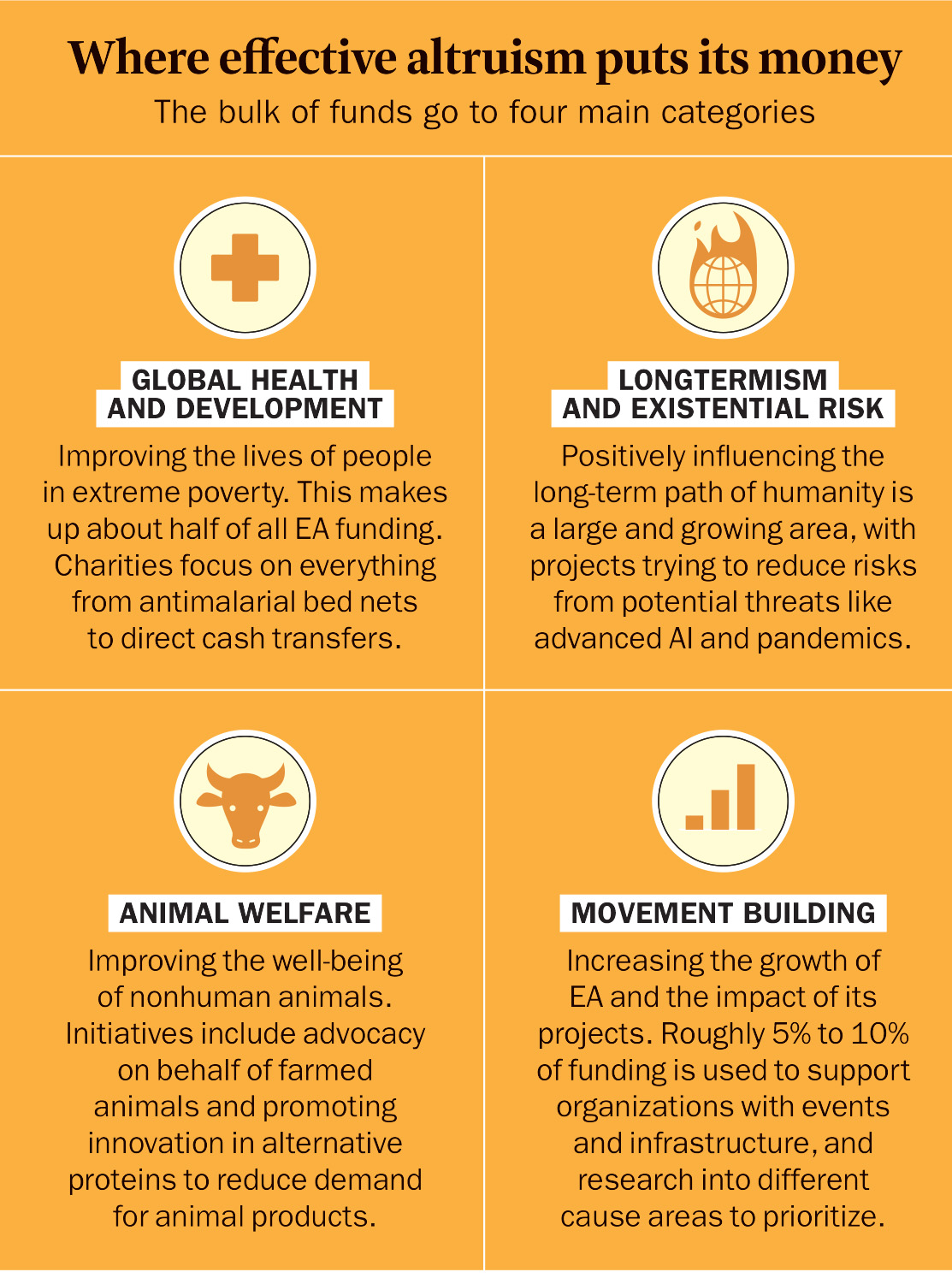
Another critique is that EA is too deeply rooted in the values underpinning current power structures and it shouldn’t be up to individuals to fix seismic problems. MacAskill agrees, pointing out that EAs are doing a lot of work to try and change things at the policy level, but he also believes the argument can be used as an excuse by well-off people to defer responsibility. “Society just consists of individuals; governments consist of individuals; corporations and so on,” he says. That leads him to argue that EA should focus on both trying to change what big institutions do, and on individual action.
Believing that it’s truly possible for one person to make a difference can inspire people to reorganize their priorities. Niel Bowerman was a climate scientist and activist when he met MacAskill and decided to change tracks; he helped set up 80,000 Hours, where he now works.
In such a young movement, though—a 2020 survey put the median age at 27—that belief can also lead people to put immense pressure on themselves to optimize all their life choices. “When I first encountered EA, there was this slightly alluring idea of: Why don’t I just dedicate my whole life to this thing?” Bowerman says. He soon came to realize that wasn’t sustainable, nor was it the best way to do the most good.
Many older EAs—those in their 30s qualify here—say doing good has become one of many goals, not the only one. Wise has three children, which has helped ground her. “It’s both not realistic and probably not desirable to be so absolutist about this that you don’t have other significant pulls in your life,” she says. “We all need to make decisions that work for us as humans and not as if we’re only optimizing machines.”
‘WE ALL NEED TO MAKE DECISIONS THAT WORK FOR US AS HUMANS AND NOT AS IF WE’RE ONLY OPTIMIZING MACHINES.’
—JULIA WISE, COMMUNITY LIASON AT THE CENTE FORR EFFECTIVE ALTRUISM
ON MACASKILL’S DESK in Oxford are portraits of three people: Mozi, the ancient Chinese moral philosopher who taught that morality should involve equal, impartial concern for all; Benjamin Lay, the Anglo American Quaker who was a prominent early opponent of slavery; and Irena Sendler, the Polish humanitarian who rescued Jews during the Second World War.
Looking at them reminds him of the long path from these moral pioneers to the widespread uptake of their ideas. The first public protest against African American slavery was the 1688 Germantown Quaker Petition. Slavery was only abolished in the British Empire in 1833, decades later in the U.S., and not until 1962 in Saudi Arabia. History encourages MacAskill to favor gradual progress over revolution. Abolition, he says, is “maybe the single best moral change ever, it’s certainly up there with feminism, and they’re extremely incremental. They don’t seem that way because we enormously shrink the past, but it’s almost 300 years we’re talking about.”
As MacAskill works to advocate for the generations to come, he tries to keep in mind how ideas play out over decades and centuries. In What We Owe the Future, MacAskill argues that a flourishing future is not fantasy; it may not be likely, but it is possible. “It’s a future that, with enough patience and wisdom, our descendants could actually build—if we pave the way for them,” he writes.
Part of that task requires cultivating imaginative compassion. At the end of the hardback edition of MacAskill’s new book, a QR code takes you to a short story, “Afterwards,” dedicated to his girlfriend Holly. Set thousands of years in the future in a eutopia (meaning a “good place,” whereas utopia means “no-place”), there is a scene where a character describes how she has been reading some history. She is incredulous that people once traveled around in trains underground, crammed together, making one another sick. “And they’d do it every day. And they’d hate it. But they’d keep doing it, because they had to, just to have a life that was barely good at all. And they hardly thought about how much better life could be.”
I find this surprisingly moving. If I think about my ancestors even 200 years ago, they would never have been able to picture my life now. It’s no surprise that it’s hard for me to imagine a future that’s much better than what MacAskill calls a “global Scandinavia,” where everyone has about as good a life as the most well-off people alive today have.
“We could really make things very good in the future,” he tells me. “Imagine your very best days. You could have a life that is as good as that, 100 times over, 1,000 times over.”
In the days that follow, I find myself thinking of that conversation—of the moments in my life that have shimmered with beauty and joy and love and laughter, and the stability and safety that made those moments more possible. I think of all the people alive right now who deserve to have such moments, and all the lives still to come that could be so much better and richer in meaning—or so much worse. If that depends on what we all do in the next few decades, I don’t know exactly how to help ensure our actions are for the better. But if the future could be as vast and good as MacAskill thinks, it seems worth trying.
—With reporting by LESLIE DICKSTEIN/NEW YORK
ILLUSTRATION BY THE PROJECT TWINS FOR TIME; SOPHIE GREEN FOR TIME (2)
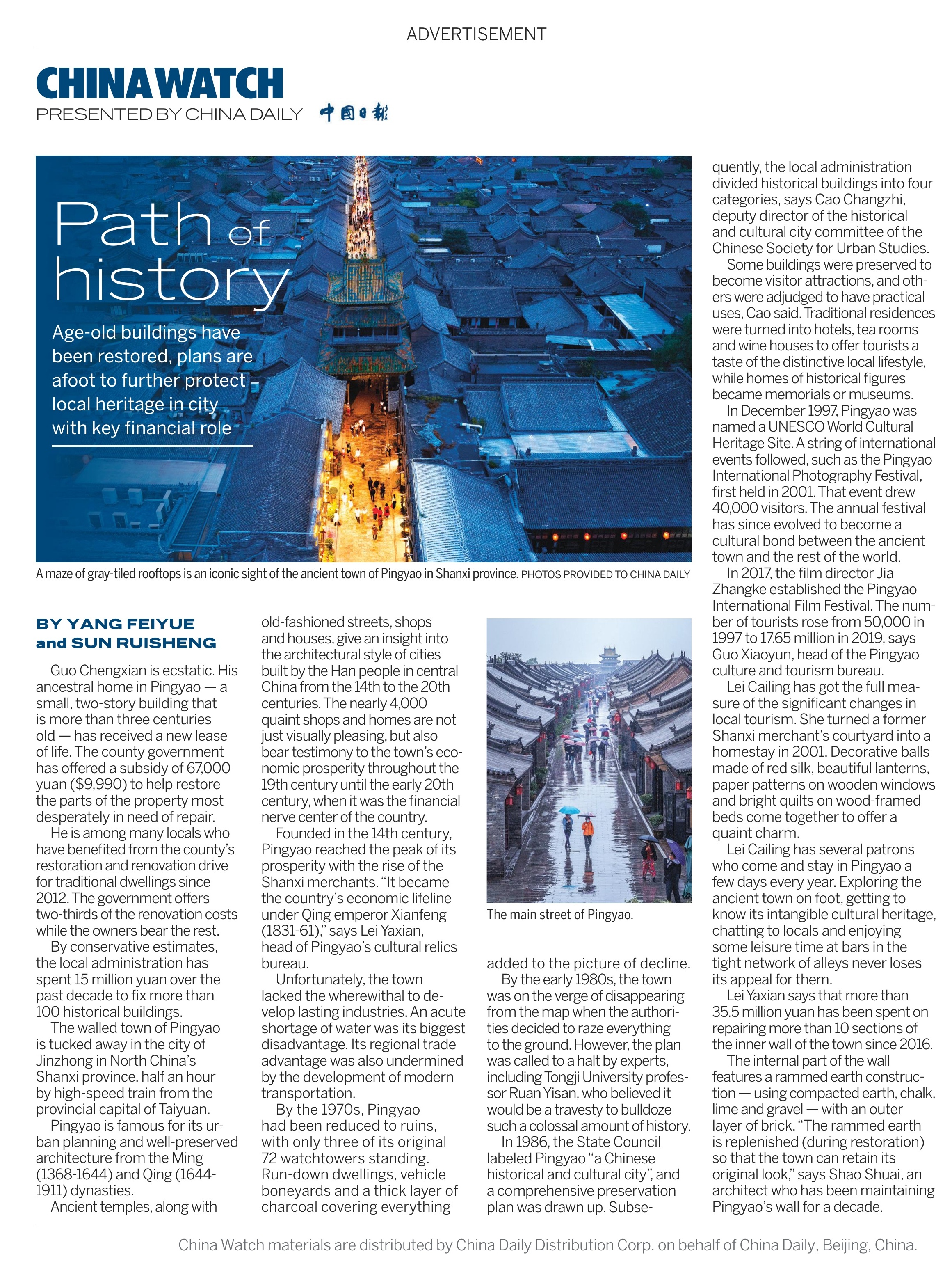
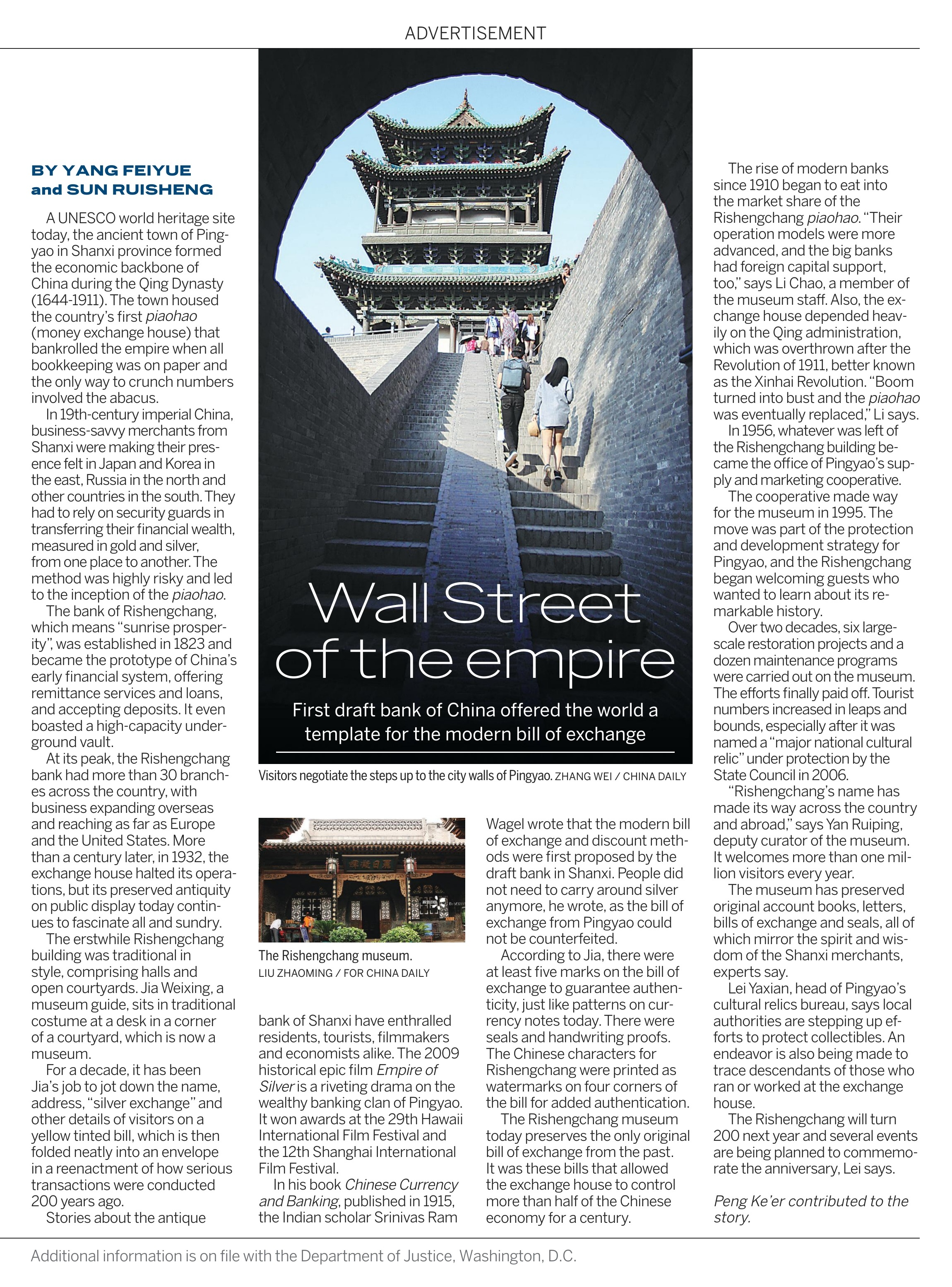
TimeOff

REALITY TV HAS SHAPED OUR WORLD
BY JUDY BERMAN
I’M NOT HERE TO MAKE FRIENDS. I’M HERE TO win.” So goes the ultimate reality-TV cliché, one popularized by the first season of Survivor, which got viewers hooked on competitions between “real people” cashing in the 15 minutes of fame that are the birthright of all Americans. Two decades later, the declaration has proved true of the genre itself. Critics, social scientists, and even fans keep unearthing revelations about reality TV’s crass manipulations and toxic tropes. Yet the genre has conquered the culture and claimed its prize: our attention.
Reality TV has radically altered the landscapes of celebrity, politics, and power. Its stars have penetrated every corner of the entertainment industry, from Harry Styles and Cardi B on the pop charts to Laverne Cox and Emma Stone in Hollywood. Without docusoaps, gossip rags would be virtually blank. And it has made many people very rich; Kim Kardashian has a net worth of $1.8 billion.
To state the obvious, reality TV also catalyzed the rise of our 45th President. In a 2016 interview that critic James Poniewozik highlights in Audience of One: Trump, Television, and the Fracturing of America, a former supervising editor of The Apprentice explained the show’s aim: “Make Trump look good, make him look wealthy, legitimate.” Well, it worked. And Trump brought the medium’s guiding principles—conflict, chaos, and public humiliation—to the West Wing.
He was hardly the first to politicize the genre. By the ’90s, reality TV was confronting third-rail issues like racism, LGBTQ rights, abortion, and AIDS—and that was just in early seasons of MTV’s The Real World. Young people have grown up expecting to see their values represented on shows as bland as Dancing With the Stars, which faced an outcry when Sean Spicer tried to launder his image as a contestant.
In other words, reality TV’s winning streak isn’t necessarily good for society. To the extent that the U.S. has become a harsher, angrier, more divided place in the 21st century, reality TV—which regularly rewards people for their cruelty, belligerence, and superficiality—bears some of the blame. As sociologist Danielle J. Lindemann notes in her recent book True Story: What Reality TV Says About Us: “For all of its extreme personalities and outlandish premises, reality TV reflects how regressive we truly are.” With that in mind, our list of reality TV’s most influential seasons is not a celebration of every show, or of the genre writ large. It’s a measure of the profound impact its charming hams, its malignant narcissists, and the bizarre situations they inhabit have had on our world, for better and worse.

ALTHOUGH THE TERM reality TV came decades later, examples of the genre emerged in tandem with the advent of television. Candid Camera first placed unwitting people in absurd situations and recorded their reactions in 1948. Through story lines about gay identity and divorce, PBS’s culture-shaking 1973 docuseries An American Family made the personal political. The ’80s police ride-along Cops and the paean to ostentatious wealth that was Lifestyles of the Rich and Famous epitomized the tough-on-crime, greed-is-good zeitgeist of the Reagan years and helped cement the genre’s implicit conservatism.
The dominant format as we know it today, a composite of fly-on-the-wall scenes and cast members’ solo interviews with producers, edited to create a coherent narrative with clearly defined characters, coalesced in 1992 with The Real World. The show’s first season finale found the Gen X cast breaking into the production room set up in their loft and realizing they weren’t documentary subjects so much as characters in an unscripted soap opera. Such deceptions would come to look quaint once a second wave of docusoaps, like Bravo’s Real Housewives, surfaced in the mid-aughts.
The producers of those cable franchises had likely been emboldened by the reality revolution that remade broadcast TV around Y2K. A cohort of popular—and, thanks to product placement and low production costs, lucrative—competition series edged out scripted programming. So tenacious is the genre that many of these shows are still airing, from Big Brother to The Bachelor. Cable has its own enduring reality contests too. Bravo has Project Runway and Top Chef. RuPaul’s Drag Race leveled up from Logo to VH1. MTV’s The Challenge dates back to 1998, and CBS has now adapted its format for The Challenge: U.S.A.
In the late 2000s and early 2010s, amid a renaissance in scripted programming on cable, it looked as though the ascendance of paid platforms might lead to reality TV’s extinction. Instead, streaming has intensified the race to create cheap, addictive, populist content. As part of its potentially quixotic effort to become a standalone cable substitute, Netflix has built a global reality arsenal that ranges from sugary import The Great British Bake Off to diabolical dating experiment Too Hot to Handle. Rival streamers have followed suit. After 20 seasons on E!, the Kardashian-Jenners now license their domestic lives to Hulu. Between the imminence of streamers’ contraction and the increasing demand for cheap time fillers from linear networks hobbled by streaming, reality TV has a stronger financial foundation than ever.
ONCE DISMISSED AS A NOXIOUS FAD, reality TV has hardened into an institution. When social scientists study the effects of this entrenchment, their conclusions are rarely encouraging. Reality shows have been found to exacerbate body anxiety, increase physical aggression, and mess with our ideas about romance.
It would be alarmist to suggest that watching 90 Day Fiancé every once in a while is likely to warp our brains. But long-term exposure to dozens of shows that reinforce the same misperceptions is different. As media critic Jennifer L. Pozner notes in her 2010 book Reality Bites Back: The Troubling Truth About Guilty Pleasure TV, reality programming “has the power to influence our notions of normalcy vs. difference,” and to encourage generalizations about different identities. Since Pozner published her book, and earnest critiques of reality TV became old news, a knowing acceptance of the genre’s deceptions has set in and cheerful self-parodies like HBO Max’s FBoy Island have emerged.
There’s plenty to enjoy about reality TV. And let me be clear: I do enjoy it. Who could deny a person living in the maelstrom of 2022 the mindless pleasure of Love Island? The genre isn’t monolithic, either. Along with talent-contest superstars, unscripted programs are often the first to bring poorly understood communities to the small screen. Sometimes it even gives those subjects the respect they deserve.
But taking reality TV seriously means holding it accountable for its frequent awfulness. Shows are still edited to reinforce stereotypes, from the vapid blonde to the angry Black person. Docusoaps thrive on the notion that women are petty gossips. Dating shows traffic in gender essentialism, and those with LGBTQ casts remain scarce. People with disabilities are treated like freak-show fodder. Asian and Latinx Americans remain underrepresented; recent attempts to compensate for this erasure, like Indian Matchmaking, have arguably hurt as much as they’ve helped. You can’t even watch The Masked Singer without worrying about humming along with an insurrection enabler.
Unless you’re fully off the grid, there’s no isolating yourself from these shows’ influence. I wouldn’t count on young people, who pore over YouTube and TikTok, to bring about their obsolescence, either. Our current influencer economy might be based in social media, but it’s an extension of the original famous-for-being-famous model of reality TV. TikTok’s D’Amelio sisters now have their own Hulu series, and no other American has more Instagram followers than Kylie Jenner.
If we can’t stop this pop-culture juggernaut—and wouldn’t want to—then we’ve got to understand what its most indelible story lines are communicating to us about who we should be, what we should believe, and, once in a while, who will best embody our values in a political forum. Because reality TV may not be here to make friends, but it’s most definitely here to stay.
ILLUSTRATIONS BY TANYA COOPER FOR TIME; SOURCE PHOTOS: GETTY (9), EVERETT (6)
TIME OFF TELEVISION


CANDID CAMERA
SEASON 2 (1949)
What began as a radio program called Candid Microphone soon pioneered the winning formula of hidden-camera prank shows. Candid Camera introduced the juxtaposition of a manipulated environment and authentic human reaction that would later be exemplified in Punk’d and international shows like Old Enough.
AN AMERICAN FAMILY
(1973)
Producer Craig Gilbert wasn’t trying to invent reality TV as we know it when, in 1971, he brought cameras into the Santa Barbara home of Bill and Pat Loud and their kids. But what he ended up with was seven months’ worth of footage about one family that, when aired as a 12-part series on PBS, attracted around 10 million viewers and was dubbed the “ultimate soap opera” by TIME.
LIFESTYLES OF THE RICH AND FAMOUS
SEASON 1 (1984)
Mansions. Yachts. Celebrities with golden tans lounging poolside. Host Robin Leach’s foghorn baritone showering viewers with “champagne wishes and caviar dreams.” This is the fantasy Lifestyles of the Rich and Famous peddled for more than a decade beginning in the mid-’80s. The show shattered taboos around flaunting riches and opened the wealth-porn floodgates.
THE REAL WORLD
SEASON 3 (1994)
The premise was simple yet intriguing: put a group of strangers in a house and film them as they “stop being polite and start getting real.” The Real World, which marked MTV’s first foray into nonmusic programming, was an instant hit, setting a blueprint for reality docusoaps to come. The third season of the show featured a boisterous cast of seven, but its most memorable star was AIDS activist Pedro Zamora.
COPS
SEASON 7 (1994–1995)
Shot at the height of the show’s relevance, on the heels of several Emmy nods, Season 7 of Cops enabled two of the country’s biggest, most controversial police forces—the NYPD and LAPD—to launder their reputations. But that same year saw the publication of multiple studies that uncovered the show’s racist subtext and confirmed it was biased toward officers.
SURVIVOR
SEASON 1 (2000)
More than 20 years after the first season of Survivor, the premise of the show hasn’t changed much. But while the rules of the game are simple—to outwit, outplay, and outlast everyone else—the series altered the reality-television landscape by pushing a bunch of castaways to their mental, physical, and emotional limits, setting the tone for adventurous, demanding competition shows to follow.
MAKING THE BAND
SEASON 1 (2000)
The singing competition has become a reality TV staple and the launchpad for many a pop star’s career. While the average viewer may associate this model with American Idol, it was actually predated in the U.S. by Making the Band, which debuted in 2000 at the height of the boy-band craze—and produced the platinum-selling quartet O-Town in its first season.
BIG BROTHER
SEASON 2 (2001)
Unlike most reality series, Big Brother leaves little room to question how real it is. The show streams its cast members’ every move for 24 hours a day as they live together and vie to become the last one standing—ensuring, per George Orwell’s famous phrase, that at all times, “Big Brother is watching you.” The second season introduced the format and strategic approach that would last for 22 seasons and counting.
JACKASS
SEASON 2 (2001)
Jackass, which aired on MTV from 2000 to 2002 and spawned five movies (plus several hours of bonus content), was a study in extreme discomfort and the strong bonds of friendship. The cast, led by Johnny Knoxville, featured an amalgam of skateboarders, stunt performers, and pranksters. By the middle of its second season, it had, for better or worse, gained national attention, becoming MTV’s top-rated show.
AMERICAN IDOL
SEASON 1 (2002)
In 2002, a 20-year-old waitress stepped into an audition room and sang before a panel of judges. It was the inaugural season of American Idol: The Search for a Superstar, the talent competition series that would become lasting appointment viewing, go on to inspire shows like America’s Got Talent and The Voice, and make celebrities out of contestants including Kelly Clarkson—the contender from Texas who was crowned the winner later that first year.
THE OSBOURNES
SEASON 2 (2002–2003)
Before the Kardashians became America’s first family of reality TV, the Osbournes reigned. Their show, which followed the antics of Black Sabbath front man Ozzy Osbourne, his wife Sharon, and two of their kids, Jack and Kelly, won the second ever Emmy for Outstanding Reality Program. Season 2 set the stage for a glut of reality shows about semifamous families in the early to mid-2000s, from Hogan Knows Best to Gene Simmons Family Jewels.
QUEER EYE FOR THE STRAIGHT GUY
SEASON 1 (2003)
An instant ratings success and critical hit upon its premiere in 2003, Queer Eye for the Straight Guy shaped representation for gay men on reality TV at a shaky time for LGBTQ rights, and in an era of rampant casual homophobia. Although it faced criticism for offering a narrow view of gay life by centering privileged white men, for its time the show felt radical. And its central tenet—that every person deserves to access their most fabulous self—carries on.
JOE MILLIONAIRE
SEASON 1 (2003)
Arriving one year after The Bachelor, Joe Millionaire at first seemed familiar: a group of women vie for the love of one man. The twist? The women were told that the inaugural star was an heir to millions, while, in actuality, he was a construction worker earning less than $20,000 a year. The series inspired questions about why we’re so drawn to shows that perpetuate romantic ideals and gender norms—and more than 40 million people tuned in to watch its finale.
BOY MEETS BOY
SEASON 1 (2003)
The same year that Bravo broke ground with Queer Eye for the Straight Guy, the network also cranked out this nasty piece of work. Disguised as The Bachelor for the male-seeking-male set, this short-lived summer dating show found protagonist James courting 15 suitors in hopes of finding his ideal “mate.” The twist was that half the contestants were straight guys hoping to win a cash prize by duping him.
THE SIMPLE LIFE
SEASON 1 (2003–2004)
No reality show epitomized the zeitgeist of the early aughts more than The Simple Life. The show riffed on the notoriously ditzy celebutante personas ascribed to socialites Paris Hilton and Nicole Richie. Season 1, which found them in Arkansas, was full of hilarious and cringeworthy moments, including an infamous scene in which Hilton claimed not to know what Walmart was.

THE SWAN
SEASON 1 (2004)
Rolled out in the wake of ABC’s cosmetic-surgery-happy Extreme Makeover, this abomination from Fox upped the ante not only by placing its all-female subjects, who were framed as ugly ducklings, at the mercy of questionably qualified physical- and mental-health professionals, but also by pitting them against one another in a season-finale beauty pageant. The prize: a modeling contract, of course.
THE APPRENTICE
SEASON 1 (2004)
Once the embodiment of ’80s excess, Donald Trump had become a relic by the time Survivor mastermind Mark Burnett gave him a chance to rewrite that history, casting him as a boardroom demigod. Was it the show that convinced almost 63 million Americans he was fit for the presidency? At the very least, it helped. To this day, there’s no better example of reality TV’s power than The Apprentice.
PROJECT RUNWAY
SEASON 1 (2004–2005)
When Project Runway debuted in 2004, the fashion-design contest set the template for creative competition series on Bravo and beyond. Without Runway, there would be no Top Chef, no RuPaul’s Drag Race, no Blown Away—and host Tim Gunn might still be the world’s best-dressed academic. The first season was perfectly cast, and the show’s producers smartly trusted that the creative process would provide enough inspiration and conflict to fuel engaging story lines.
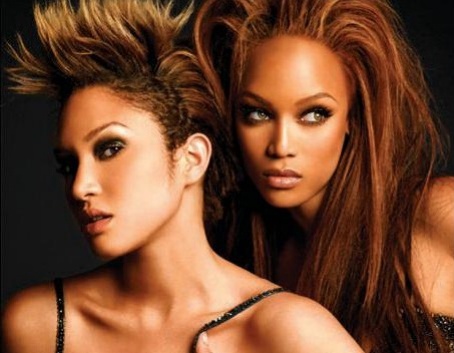
AMERICA’S NEXT TOP MODEL
SEASON 4 (2005)
America’s Next Top Model combined two formats, the makeover and the competition, to become reality TV’s longest-running fashion series. By cycle 4, it had hit its stride, with Tyra Banks cementing her persona as the over-the-top host and mentor to the models—at one point memorably admonishing a contestant by shouting, “I was rooting for you. We were all rooting for you!”
FLAVOR OF LOVE
SEASON 1 (2006)
When MTV’s Flavor of Love hit television screens in 2006, it represented, despite its flaws, a breakthrough in reality dating shows. Centered on the romantic pursuits of Public Enemy hype man Flavor Flav, the show offered a rare unapologetic view of Black and brown romance and desire at a moment when shows like The Bachelor featured precious few contestants of color. But although its representation of Black love was historic, the show also struck many as reinforcing racial stereotypes.
THE NEXT FOOD NETWORK STAR
SEASON 2 (2006)
It wasn’t until its second season that The Next Food Network Star accomplished its mission to discover the food channel’s next breakout celebrity and catapult them to stardom. The winner of Season 2 of the series, in which eight chefs competed in challenges assessed by a group of judges who crowned the ultimate chef champion, is undoubtedly the show’s most successful: Guy Fieri.
THE HILLS
SEASON 2 (2007)
The modern reality-TV and influencer landscapes owe much to The Hills, a prescient series about a group of rich and beautiful young frenemies in L.A. A spin-off of the wildly popular Laguna Beach, which was itself a riff on scripted teen soap The O.C., it starred Lauren “LC” Conrad, a student and aspiring fashion-industry player whose nascent career, romances, and friendships fueled most of the supposedly unscripted show’s extremely stage-managed story lines.
SAY YES TO THE DRESS
SEASON 2 (2008)
New York’s Kleinfeld Bridal has been in business since 1941, but it wasn’t until 2007 that it became the setting of TLC’s now long-running reality show Say Yes to the Dress. For 20-plus seasons, each installment of the show has centered on a handful of different brides, depicting the emotional highs and lows of wedding-dress shopping—and setting a generation of viewers’ expectations for what a wedding should look like and how much it should cost.
CELEBRITY REHAB WITH DR. DREW
SEASON 2 (2008)
Public humiliation comes with the territory of reality TV, but shows about people suffering from addiction raise unique ethical questions. Are they educational or just exploitative? And in the case of Celebrity Rehab, which paid famous people hundreds of thousands of dollars to have their inpatient treatment documented, were producers essentially financing the habits of the many cast members who later relapsed?
THE BACHELOR
SEASON 13 (2009)
By 2009, The Bachelor had seen several seasons end in engagements. So it was truly shocking when Jason Mesnick, the 32-year-old father serving as that year’s lead, dumped the woman he had proposed to at the end of filming and went back to his second choice. These days, twist endings are par for the course on the dating show—and Mesnick’s season foreshadowed all that was to come.
16 AND PREGNANT
SEASON 1 (2009)
Each episode of 16 and Pregnant featured a different teen, following her from midway through pregnancy into the early weeks of becoming a parent. Creator Lauren Dolgen was clear about her intention to put forward a show that would communicate the consequences of failing to take responsibility for one’s sexual health. Whether it was effective in that mission is debatable.
THE BIGGEST LOSER
SEASON 8 (2009)
Danny Cahill was named the Season 8 winner after losing 239 lb.—at that point, the most weight ever lost on the program. But by 2016, seven years after he joined the series, he had gained back more than 100 lb. Far from living out the promise of the show—that anyone could lose weight and stay healthy—Cahill was one of many who proved that it offered an unachievable dream.
JON & KATE PLUS 8
SEASON 5 (2009)
Jon & Kate Plus 8 marked one of the first times a mainstream audience was introduced to a family unit that looked different from most—the Gosselins had twins and sextuplets—and it laid the path for future series like 17 Kids & Counting. No other season proved the Gosselins’ choke hold on tabloid news more than its fifth and final one, which set ratings records after Jon Gosselin was accused of infidelity.
JERSEY SHORE
SEASON 1 (2009–2010)
The proudly crude 20-somethings featured in Jersey Shore were a far cry from the polished, image-conscious casts of MTV’s typical California-based programming. Season 1 followed the antics of eight strangers turned roommates who shared a summer home in New Jersey’s Seaside Heights—and brought the wild youth docusoap subgenre into the mainstream.
BASKETBALL WIVES
SEASON 1 (2010)
When Shaunie O’Neal, the ex-wife of NBA great Shaquille O’Neal, created the series Basketball Wives in 2010, she didn’t just raise the profiles of the cast, which included Evelyn Lozada, Gloria Govan, and Jackie Christie—she also legitimized the power and reach of WAGs, or, in layman’s terms, the “wives and girlfriends” of professional athletes.
DEADLIEST CATCH
SEASON 6 (2010)
In 2010, the commercial crab-fishing series transformed from a show about working in precarious conditions to one about working through grief and loss after the death of Phil Harris, captain of the boat Cornelia Marie, who suffered a stroke onscreen. The season was applauded for its portrayal of the emotionally complex decisions the crew faced in the wake of Harris’ death.

KEEPING UP WITH THE KARDASHIANS
SEASON 6 (2011)
Whether you view them as American royalty or pop-culture caricatures, there’s no denying the impact of reality TV’s first family. Over the course of 20 seasons, viewers watched as they evolved from fame-adjacent Calabasas, Calif., residents to full-fledged celebutantes and business moguls. In Season 6, Kim Kardashian’s wedding to NBA player Kris Humphries dominated not only the series’ story lines but also headlines around the globe.
TODDLERS AND TIARAS
SEASON 5 (2012–2013)
Toddlers and Tiaras, credited with influencing the rise of “kidsploitation” with its focus on child beauty queens and their stage moms, introduced Alana “Honey Boo Boo” Thompson and her mother June “Mama June” Shannon in Season 5. The pair would go on to have their own show—and, with news surrounding Shannon’s relationship with a convicted child molester, become central figures in the debate about the ethics of reality series starring kids.
DUCK DYNASTY
SEASON 4 (2013)
The fourth season of Duck Dynasty heralded the last days of a more innocent time, when viewers across America found wholesome amusement in a mischievous family of duck-call manufacturers. In 2013, the season premiere broke ratings records, and media began to pay closer attention to the Robertsons—including patriarch Phil, whose views on race and sexuality sparked major controversy.
THE REAL HOUSEWIVES OF ATLANTA
SEASON 6 (2013–2014)
As the third iteration of the Real Housewives franchise, Atlanta had the difficult task of proving it could live up to the success of its Orange County and New York City forebears. It did just that and more, delivering first-rate drama, immaculate shade, and countless meme-able moments. In its sixth season, it became the first Housewives series to feature an all-Black cast—and boasts the highest-rated episode in Housewives history.

VANDERPUMP RULES
SEASON 2 (2013–2014)
When Vanderpump Rules premiered in 2013, it launched what would become a powerful web of interconnected Bravo shows centered on a younger contingent of stars. While ostensibly focused on longtime Real Housewives of Beverly Hills cast member Lisa Vanderpump, the show’s real draw was the dramatic employees of Vanderpump’s restaurant SUR. By the end of Season 2, the show had eclipsed its Real Housewives predecessor in ratings.
90 DAY FIANCÉ
SEASON 2 (2014)
Although 90 Day Fiancé began as an inside look at America’s arduous and often fraught immigration process, it has since drawn criticism for promoting questionable romances, xenophobic story lines, and problematic cast members. Season 2 introduced Danielle Mullins and her now ex-husband Mohamed Jbali. The pair’s tumultuous and, by all appearances, sham relationship was marked by a significant age gap, cringeworthy gossip, and, ultimately, an ugly divorce.
CATFISH
SEASON 3 (2014)
The success of Catfish, in which the hosts investigate individuals’ claims that they are being tricked online, banks on the draw of watching strangers realize they’ve been duped. The revelation in 2014 that the show itself was engaging in some trickery by editing the episodes to make it seem as if the potential marks initiated the investigations—while it was often the person doing the catfishing who reached out to MTV—did not deter audiences. The season offered story lines that audiences found even more compelling than the truth.
THE GREAT BRITISH BAKE OFF
SEASON 6 (2015)
Reality TV may seem like a quintessentially American genre, but many of our biggest unscripted series originated in the U.K. One of the most significant imports of late is the remarkably gentle competition, The Great British Bake Off (titled The Great British Baking Show in the U.S.), which pits home bakers in the U.K. against one another in a multiweek contest whose only real prize is the esteem of a global viewership. Bake Off leveled up, stateside, from cult favorite to massive hit with its extra-sweet sixth season.
LITTLE PEOPLE, BIG WORLD
SEASON 14 (2015)
Little People, Big World examines the lives of the Roloffs: Matt and Amy, a couple with dwarfism, and their four children, one of whom also has dwarfism. The series has long concerned itself more with the dynamics of the charming, complex family than with what makes them different—an approach that was exemplified in the tense yet celebratory 14th season, which earned the series its highest ratings yet.
I AM JAZZ
SEASON 1 (2015)
I Am Jazz premiered in 2015, introducing a broader audience to trans teenager and already influential YouTuber Jazz Jennings. At a moment when TV was attempting to capture trans experiences across many types of programs, from Transparent to I Am Cait, the first season of the show offered a sensitively constructed portrait of a teenager coming into her own as it chronicled her experiences at home, at school, and in her broader South Florida community.
LOVE & HIP HOP: NEW YORK
SEASON 6 (2015–2016)
When creator Mona Scott-Young unveiled Love & Hip Hop in 2011, it was an irreverent, unscripted look at the lives of women in the hip-hop industry, many of whom were in romantic relationships with the genre’s male stars. Over time, however, the popular series—which has spawned eight spin-offs, including franchises in Atlanta and Hollywood—became an effective vehicle for aspiring artists to launch their careers. The most salient example: Season 6 arrival Cardi B.
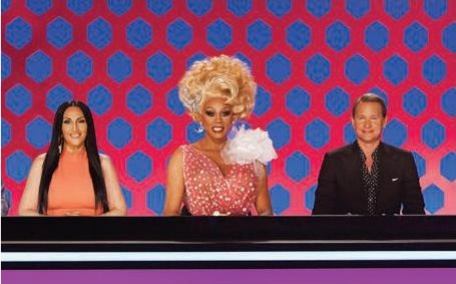
RUPAUL’S DRAG RACE
SEASON 8 (2016)
Few pop-culture products have done as much to queer the mainstream as Drag Race, the competition show created by legendary drag queen RuPaul Andre Charles. Although the show was made for queer audiences, it quickly became a hit with viewers who did not identify as such. And in Season 8, it not only celebrated its 100th episode but also garnered more than a million viewers for its premiere—moving off a niche network to VH1 the following year.
THE BACHELORETTE
SEASON 13 (2017)
In 2017, Texas lawyer Rachel Lindsay became the Bachelor franchise’s first Black lead. Her season of The Bachelorette featured what was then the most diverse set of contestants in Bachelor franchise history, but it quickly became clear that the show was unable to properly support her. Despite tense and inappropriate episodes in which she was forced to manage racist behaviors, Lindsay found love—and became a strong voice for change in the franchise and reality TV more broadly.
ARE YOU THE ONE?
SEASON 8 (2019)
Are You the One? started out in 2014 by challenging contestants to identify their “perfect match” from a pool of housemates of the opposite sex for a chance to split $1 million in prize money. Then, in 2019, it flipped its concept on its head by casting 16 people who identified as sexually fluid, which made for a competition that was not only miles more difficult but also exponentially more compelling. The season went on to win a GLAAD Media Award.

SELLING SUNSET
SEASON 3 (2020)
Netflix’s first original docusoap, Selling Sunset chronicles the telegenic lives of real estate agents at the Hollywood-based Oppenheim Group. The modern fairy tale reached its emotional apex in Season 3, as cameras followed Chrishell Stause while her marriage to an actor dissolved, apparently overnight. Sunset has set the template for reality TV in the streaming era: packed with conflict, backloaded with cliffhangers, and clocking in at 30ish minutes, it’s deeply bingeable.
INDIAN MATCHMAKING
SEASON 1 (2020)
Indian Matchmaking revolves around matchmaker Sima Taparia and the hopeful singles who come to her looking for a compatible life partner. The show’s debut season was met with mixed reviews; while some praised the mere fact of its representation of love within brown and South Asian communities as a positive step forward, others critiqued the show for its lack of cultural context and for reinforcing stereotypes.
TOP CHEF
SEASON 18 (2021)
Top Chef has long been the gold standard of competition shows. Whereas most series in this subgenre care more about the drama among the contestants than what they produce, the quality of the food has always been the priority for Top Chef’s judges. Season 18 had a cast that radiated positivity and rallied support for an industry decimated by COVID-19.
LOVE ISLAND (U.K.)
SEASON 7 (2021)
Contestants seeking romance on the U.K.’s Love Island are monitored in real time for a show that airs hour-long episodes, six days a week throughout the year. The constant exposure has created instant celebrity for participants, which also brings constant scrutiny. The show instituted new mental-health protocols for Season 7, including social media training and offering at least eight therapy sessions after filming.
THE MASKED SINGER
SEASON 7 (2022)
It was one of the realest scenes in the history of prime-time reality TV: Rudy Giuliani steps out from a jack-in-the-box costume on The Masked Singer, and panelist Ken Jeong walks off set. The chaos of American politics had even derailed a lighthearted singing contest.
BY JUDY BERMAN, ELIANA DOCKTERMAN, MARIAH ESPADA, MAHITA GAJANAN, ANNABEL GUTTERMAN, CADY LANG, BELINDA LUSCOMBE, AND MEGAN MCCLUSKEY
CANDID CAMERA: EVERETT COLLECTION; SOURCE PHOTOS: EVERETT (4); THE SWAN: EVERETT COLLECTION; AMERICA’S NEXT TOP MODEL: EVERETT COLLECTION; SOURCE PHOTO: GETTY (1); VANDERPUMP RULES: EVERETT COLLECTION; RUPAUL’S DRAG RACE: EVERETT COLLECTION; SOURCE PHOTO: GETTY (1)
8 QUESTIONS
Neil Gaiman The prolific author on a new Netflix adaptation of his classic comic, the upside of nightmares, and the practical uses of fantasy
What do you say to people who look at The Sandman and don’t see literature?
I like the fact that comics are still a gutter medium, because there’s always life in the gutter. It doesn’t matter to me if people think Sandman is literature. What I care about is that people read it and it matters to them.
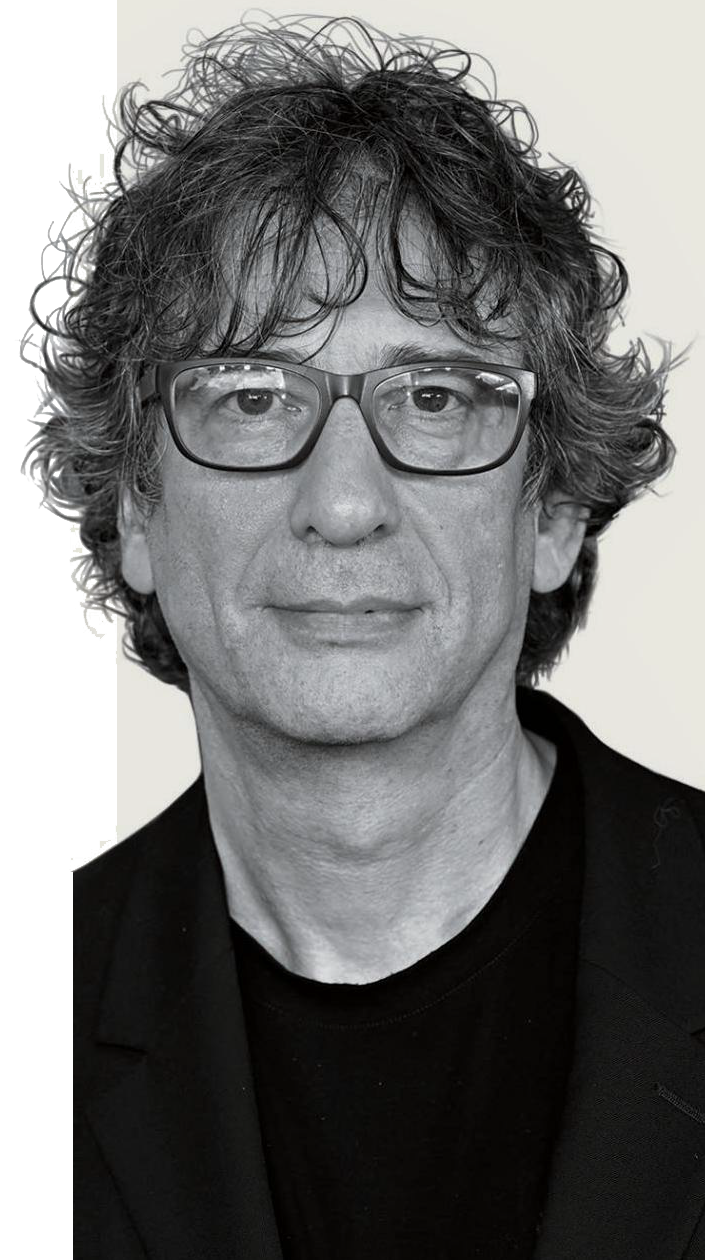
It’s been more than 30 years since you started writing The Sandman. What was it like to revisit? It felt like we were doing something that was literally impossible. I’d spent 30 years waiting for somebody to make a bad Sandman film. And just hoping that if I was really lucky, maybe it wouldn’t be bad.
Was there anything that, upon rereading, you were excited to update? Mostly going through the old comics reminded us the extent to which Sandman had been rather ahead of its time. Back when nobody commented on the fact that it was filled with gay characters, trans characters, and Black characters. We actually had gone and made something that felt pretty much of its time.
In one of the Sandman series’ later episodes, there’s a line about how a nightmare’s purpose is to reveal a dreamer’s fears so that they may face them. What did you learn from your nightmares? I’ve learned to trust my dreams and nightmares. When I was a kid, I had terrible nightmares. When I was writing Sandman, they continued. But whenever I’d get a nightmare, I would wake up thrilled and immediately jot it down and go, “Whoa, I can use that.” The nightmares went away. My theory was that whoever was giving me them was so disappointed by my reaction that they just couldn’t be bothered anymore.
The character of Death offers some of the warmest moments in the show. What informed your creation of her? I loved the idea of a Death that was warm, a Death that you’d like to meet. I thought, that’s the Death I’d like. When it’s my turn to go, there’d just be somebody lovely there, saying, “Oh, I’m so sorry, you should have looked both ways before crossing that street.” That was the Death that I wanted.
What does fantasy offer in times like these, full of so many real-world crises? Fantasy sends us back to our lives with a different point of view. Politics makes an awful lot more sense if you read George R.R. Martin’s Game of Thrones books. You realize politicians are people, and they’re acting on their own motivations. Sometimes those motivations are beneficial, and often it’s going to be your village burned. On a micro level, I’ve spent 34 years with people coming up to me and saying, your character Death in Sandman got me through the death of my loved one. The fact that fantasy can help shoulder that burden is huge.
Despite the many adaptations of your work, including of fan-favorite novels Good Omens and American Gods, you have a reputation for trying to steer Hollywood away from your work. Why? From the age of 24 to 27, I was a film critic, and I saw a lot of bad films. I couldn’t see the point in making bad films. I didn’t want to make things that were less than they could have been. Sometimes the chances you take pay off and sometimes they don’t.
What would you tell your 28-year-old self, who published the first issues of The Sandman? Oh, I wouldn’t tell him anything. The thing that kept him doing the impossible was a combination of terror and the knowledge that if he didn’t do this thing, it wouldn’t happen. If I went back in time and said, “Hey, 30 years from now, it’ll be in print, and we’re going to make the most amazing television series of it,” he would relax and stop working. In order to get where we are, I need him to be hungry and terrified.
—CATE MATTHEWS
JEFF SPICER—GETTY IMAGES

A Climatic Change
The Inflation Reduction Act is about to jump-start U.S. climate policy and change the world
BY JUSTIN WORLAND
The Virus Hunters
Private companies, academic centers, and governments are teaming up to spot emerging health threats
BY ALICE PARK
BY ALICE PARK
The Great Reading Rethink
Proficiency rates in the U.S. are abysmal. Inside the effort to change the way kids are taught
BY BELINDA LUSCOMBE
View Desktop Version
Subscribe Now
















